Allison Collection Photos
August, 1942

Alaskan Patrol, 8/15/1942.
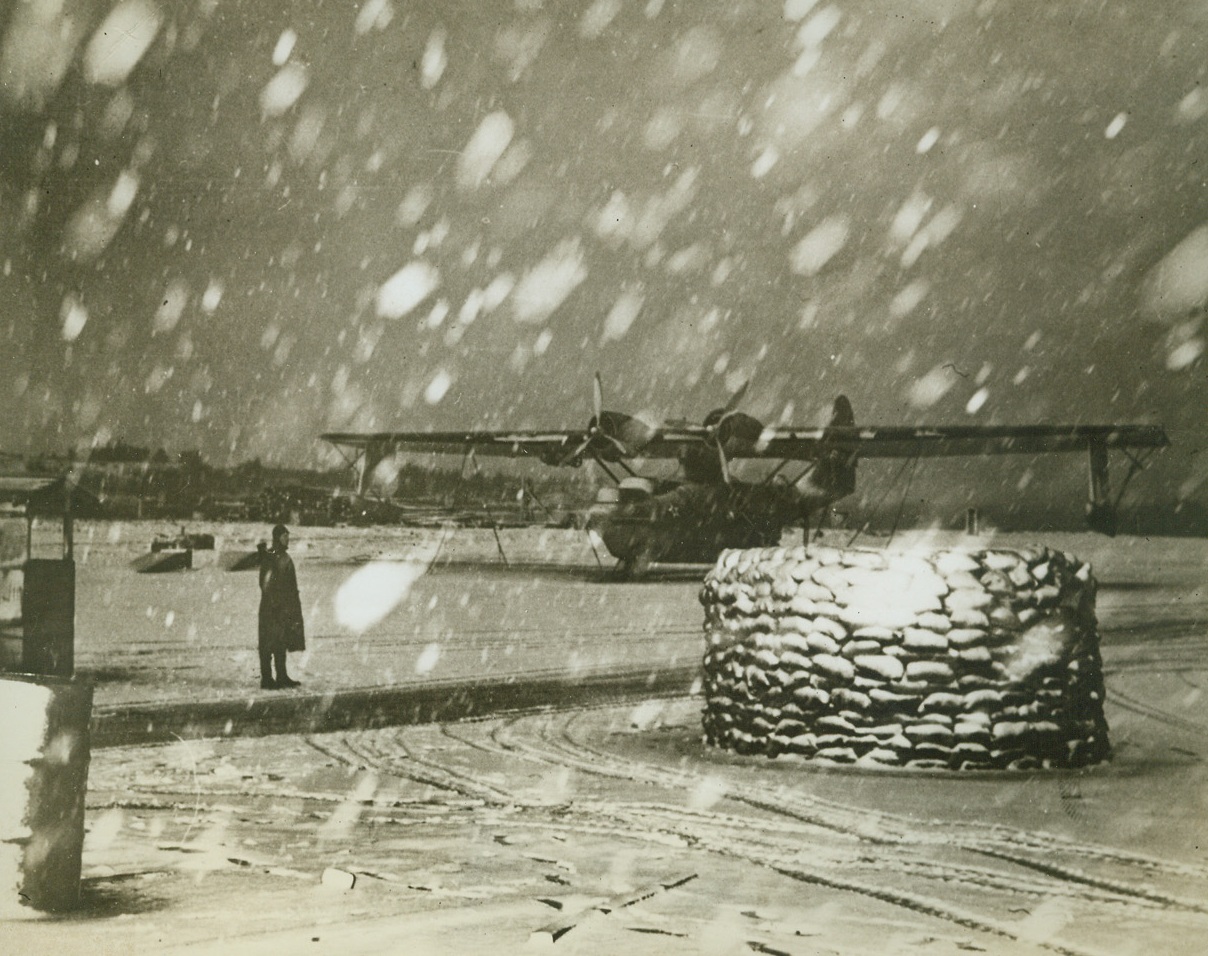
WHAT FLYERS IN ALASKEN AREA ARE UP AGAINST, 8/15/1942. Sudden snow storms are added handicaps to flying in the Northern Alaskan and Aleutian areas. Here, a Navy PBY Patrol Bomber and a “pillbox” as sandbags are almost obscured by a snow flurry. This picture describes more graphically than any words the difficulty encountered in maintaining the sky patrols in part of Alaska.Credit: U.S. NAVY OFFICIAL PHOTO FROM ACME;

No Title, 8/26/1942. Burning oil tanks and oil cars greeted the Japanese when they occupied the former Dutch-held Tanduong, in Java, according to the Japan Photo Library caption which accompanied this picture. The photo reached the U.S. via Brazil. Credit: ACME.;
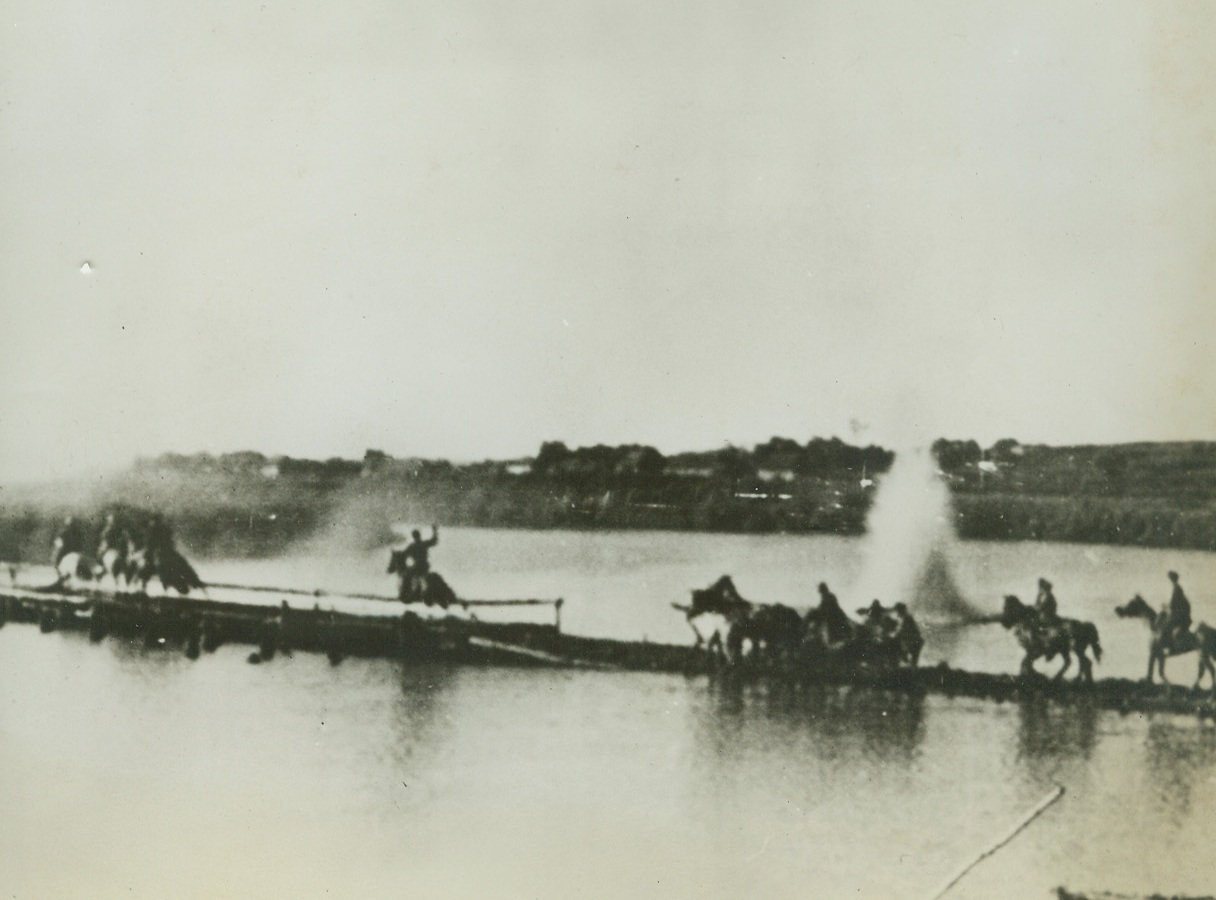
THE COSSACKS FIGHT AT STALINGRAD, 8/30/1942. STALINGRAD, RUSSIA—Under heavy enemy artillery fire, members of a Cossack Cavalry unit cross a causeway over river in the Don Region near Stalingrad. Latest reports from Moscow, Aug. 30, stated that Soviet counter-attacks had smashed the German spearhead before Stalingrad, and also the German attack from the northwest.;
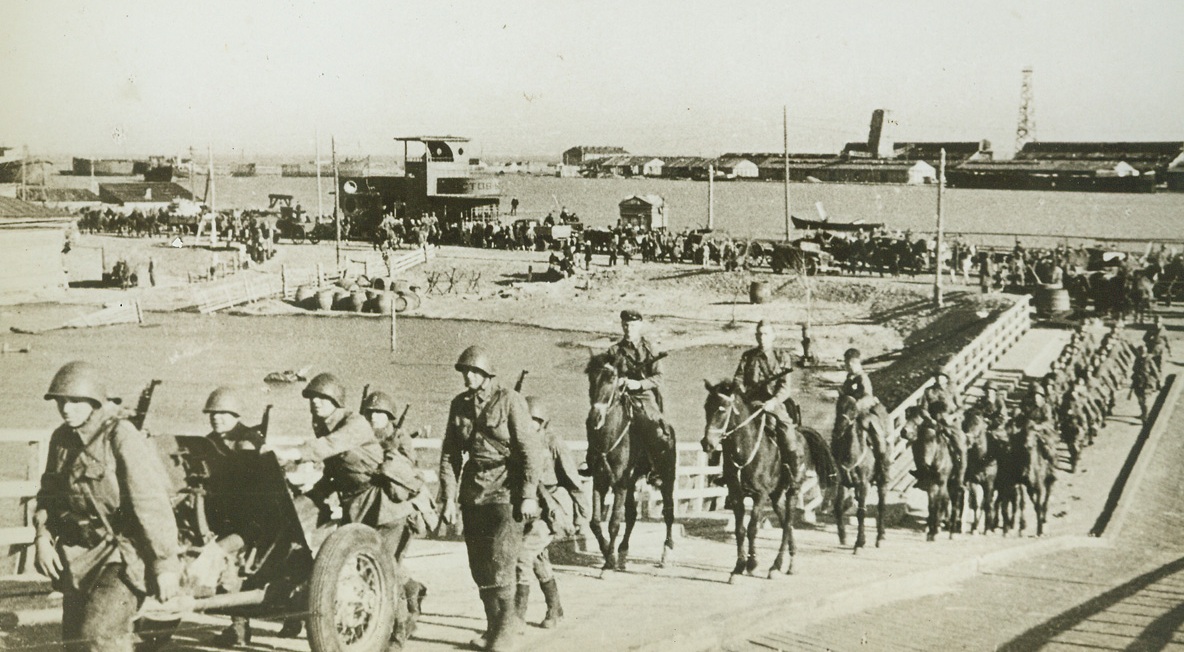
Reserves Move Towards Battle, 8/4/1942. Russia – A machine gun crew and mounted troops carrying sub-machine guns, part of a long line of Red Army Reserves, move up to the front, “somewhere in Russia.” (Passed by Censors).Credit: ACME;
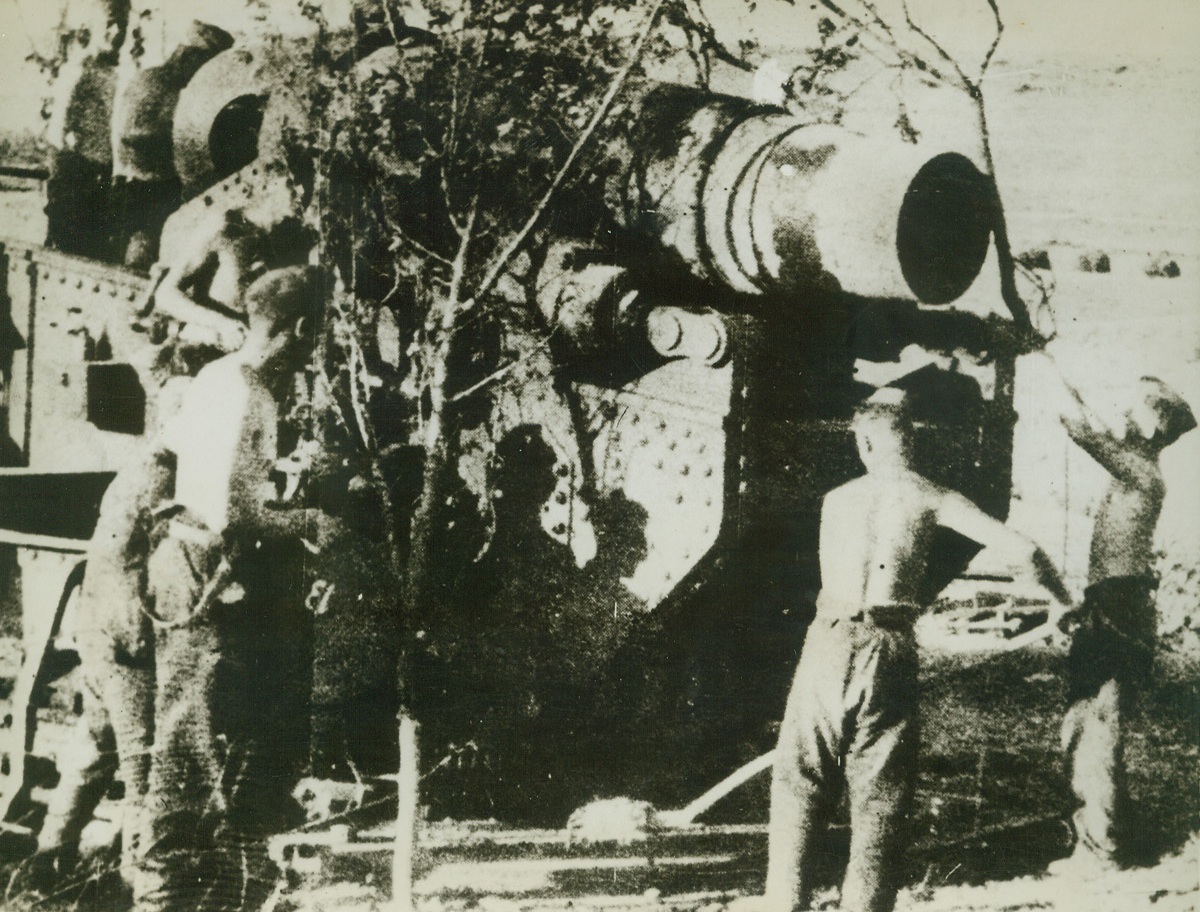
New German Gun, 8/13/1942. ON THE SOUTHERN RUSSIAN FRONT—This photo received in London from an enemy source shows, according to the caption which accompanied the picture, a new German “Giant” gun, used in the capture of Sevastopol. It is said to fire a shell weighing several hundred pounds and is believed to be an improvement of the Skoda 12-inch mortar used in the last war. It is shown “somewhere in the Crimea.” Passed by censors.Credit: ACME;
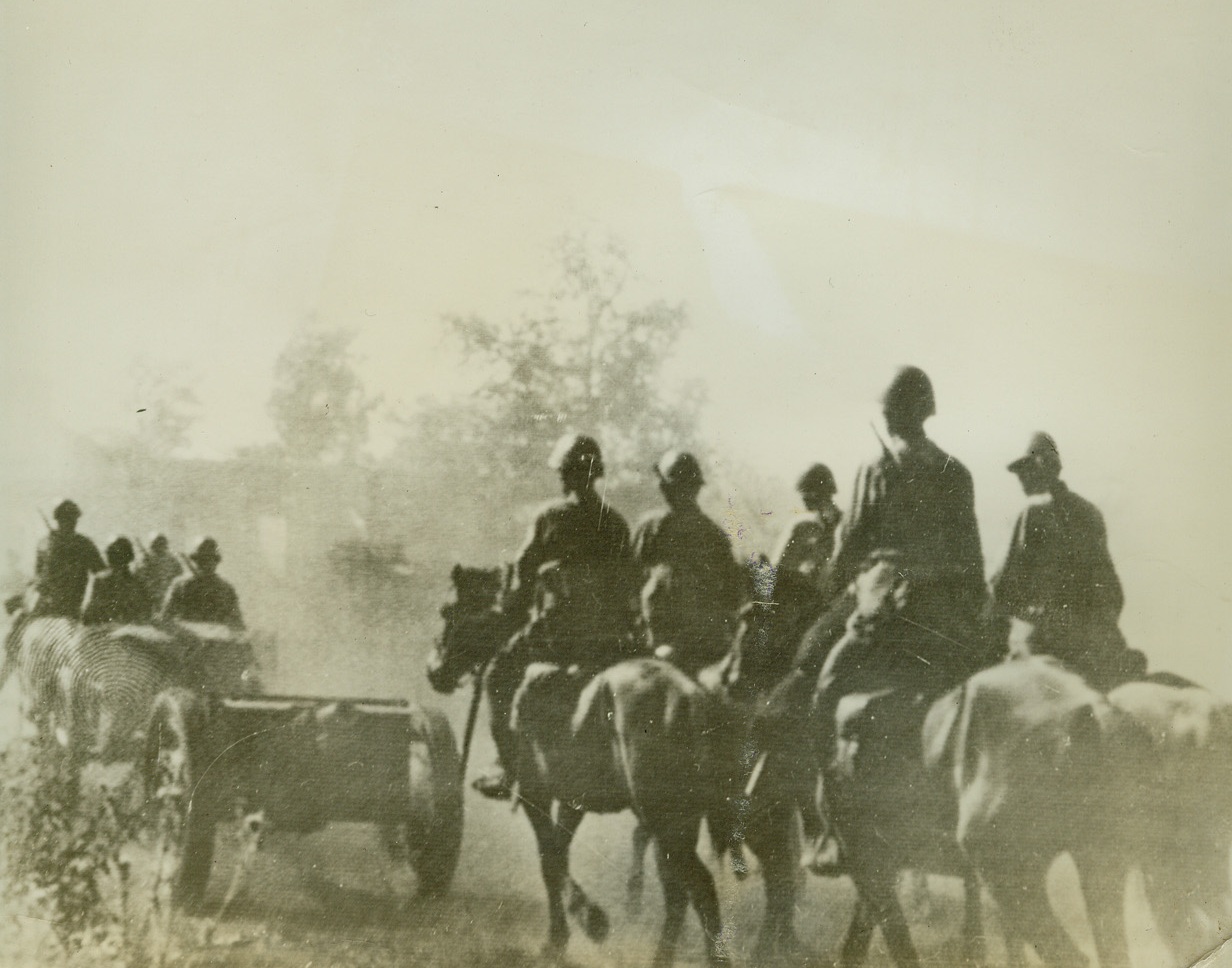
Russian Artillery Moves Up at Stalingrad, 8/30/1942. RUSSIA—A Soviet horse artillery unit enters a village northwest of Stalingrad where, according to the latest reports, August 30, Russians have successfully counter-attacked in great mechanized battles against invading Germans. The enemy is also reported to have been pushed back before the city. Photo was radioed from Moscow to London and was received in New York by clipper. Passed by censors.Credit: ACME;
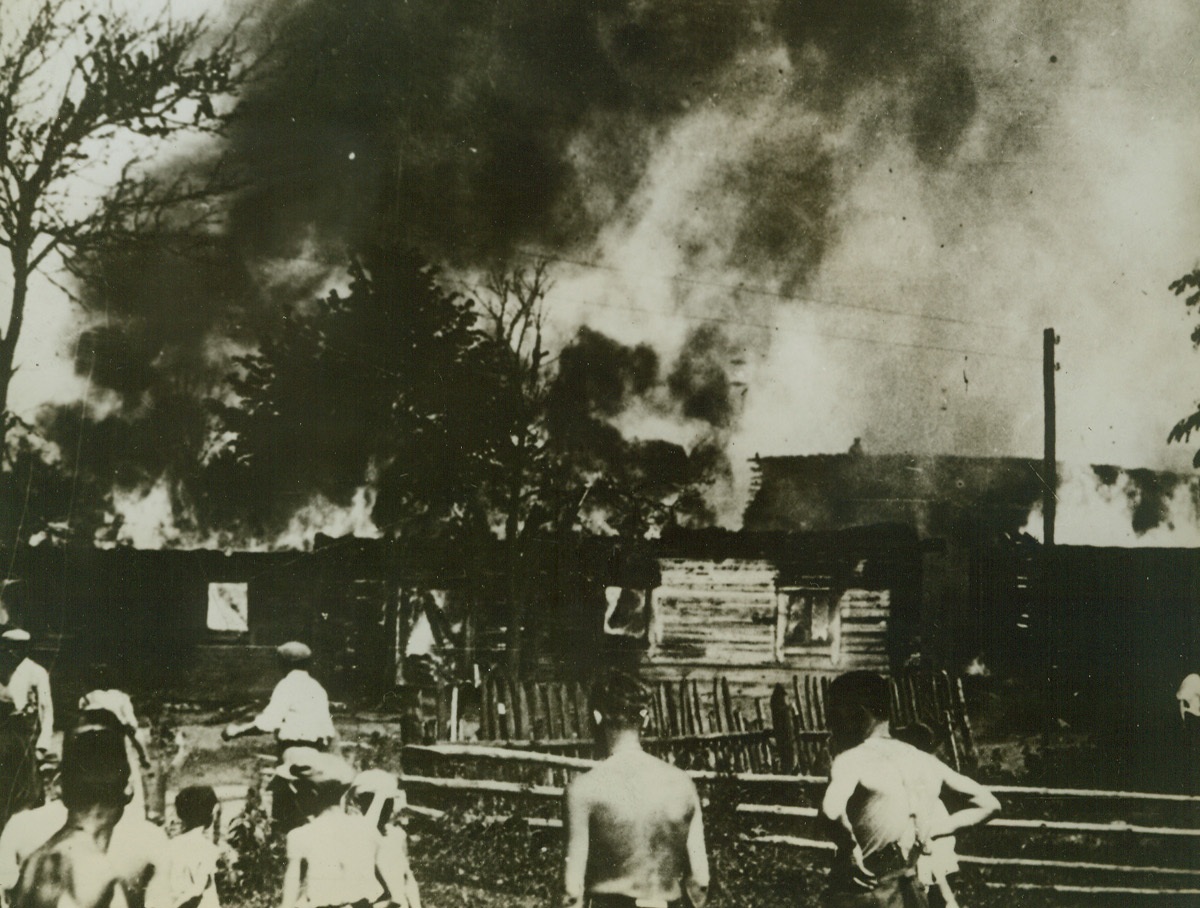
Nazi Handiwork, 8/3/1942. RUSSIA—This photograph, found on German Lance Corporal Ludwig Lehr, taken prisoner on the Kalinin front, shows Nazi soldiers, stripped to the waist, as they watch hungry flames consume a Russian village which they fired.Credit: ACME;
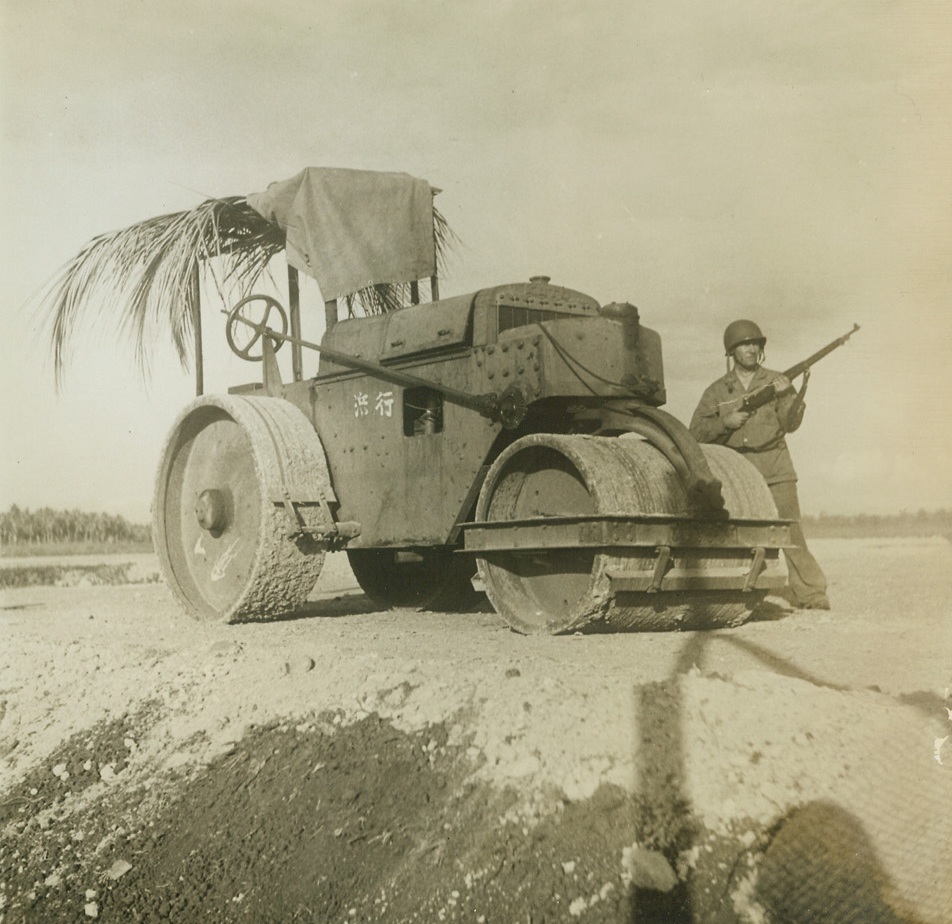
Jap Steam-roller in Enforced Idleness, 8/30/1942. Solomon Islands – A U.S. Marine stands guard over a Jap steam-roller which smoothed the ground on Guadalcanal island for a Jap air field until the Leathernecks took over the island in their offensive in the Solomons. Photo, relased in Washington yesterday, was made by War correspondent photographer Sherman Montrose of ACME News pictures. Credit line (ACME);
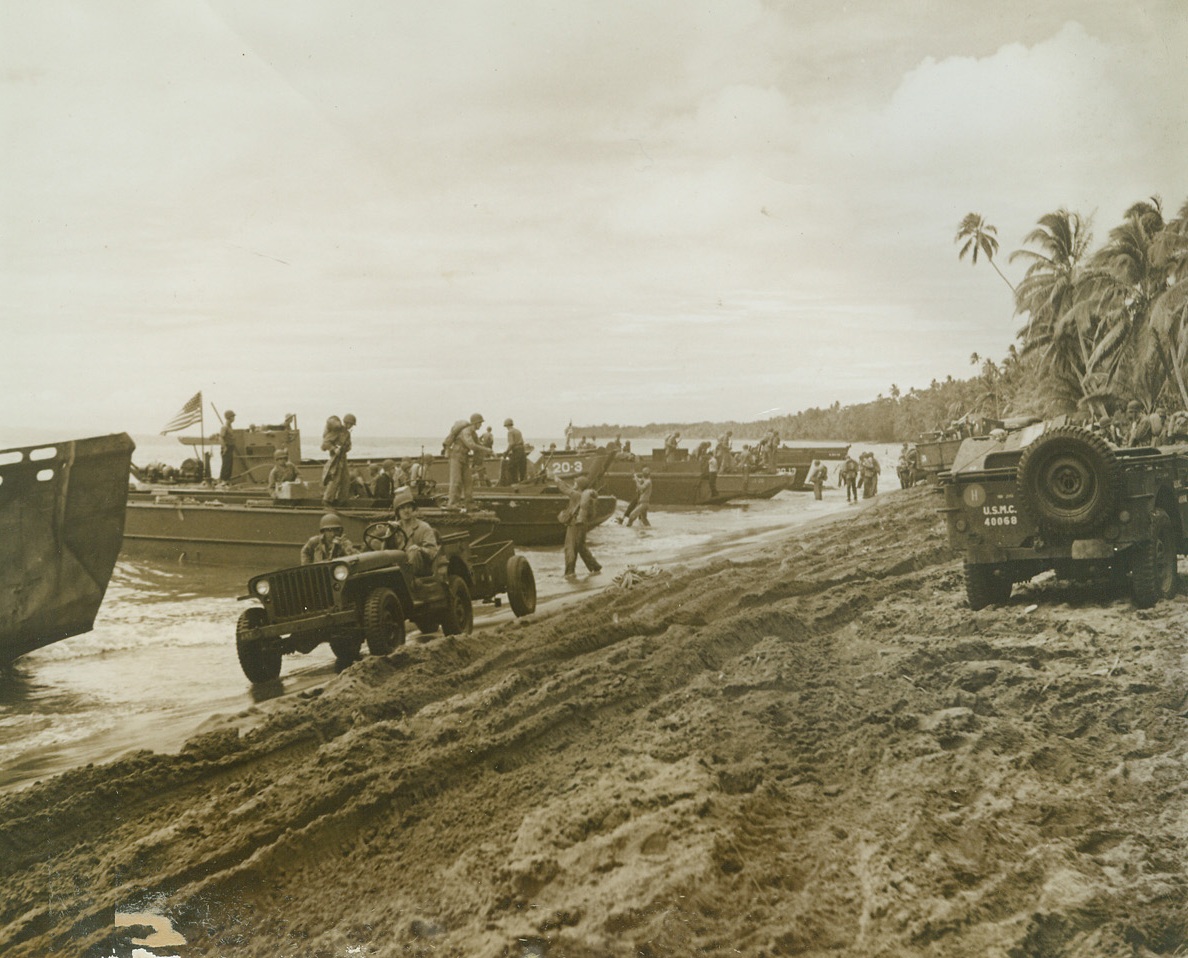
Mechanized Landing in the Solomons, 8/30/1942. Solomon Islands – Jeeps and new-type landing barges line the sandy beach of Guadalcanal island as U.S. Marines and to launch their offensive against the Japs in the Solomons. Photo, released in Washington yesterday, was made by War correspondent photographer Sherman Montrose of ACME News pictures. Credit line (ACME);
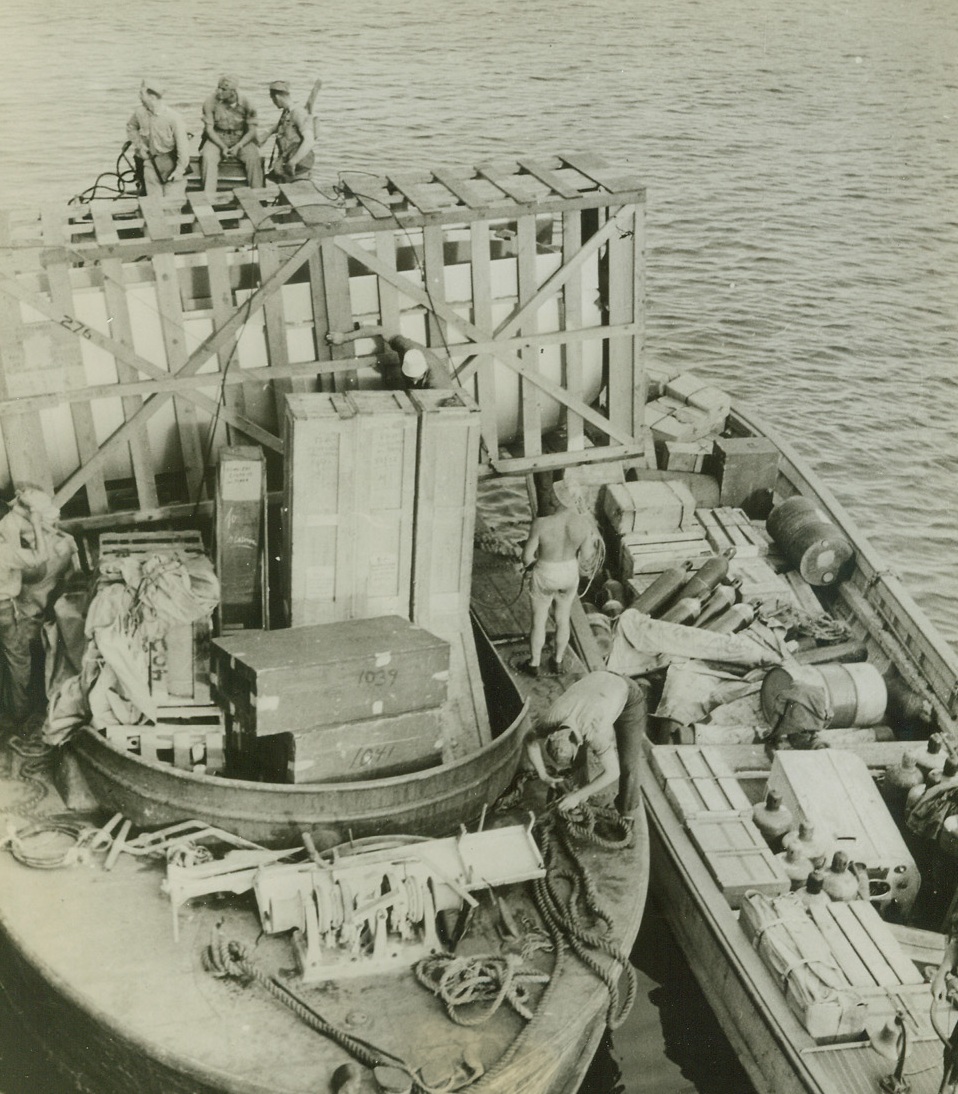
Supplies Help Form Pacific ‘Ring of Steel’, 8/13/1942. Two lighters drawn up beside a cargo boat are loaded with tools and supplies for one of the U.S. built bases in the Southwest Pacific as a ‘Ring of Steel’ is formed against the Japs . Credit line (ACME);
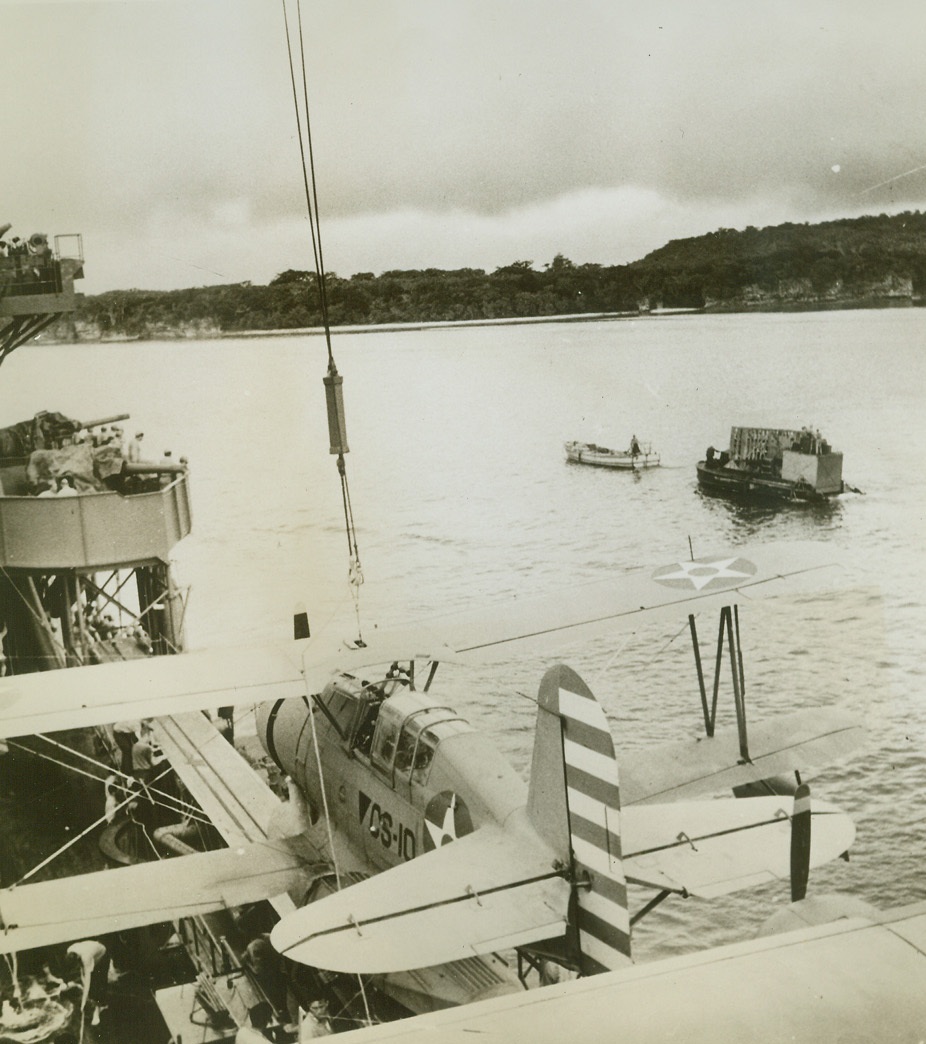
U.S. Supplies Land at Pacific Base, 8/13/1942. Crew members of a U.S. cruiser watch the operations as a landing lighter is towed ashore with tools and supplies for a U.S. built base in the Southwest Pacific. The base affords the U.S. a jumping off base to counteract Japanese actions in the area. Credit Line (ACME);
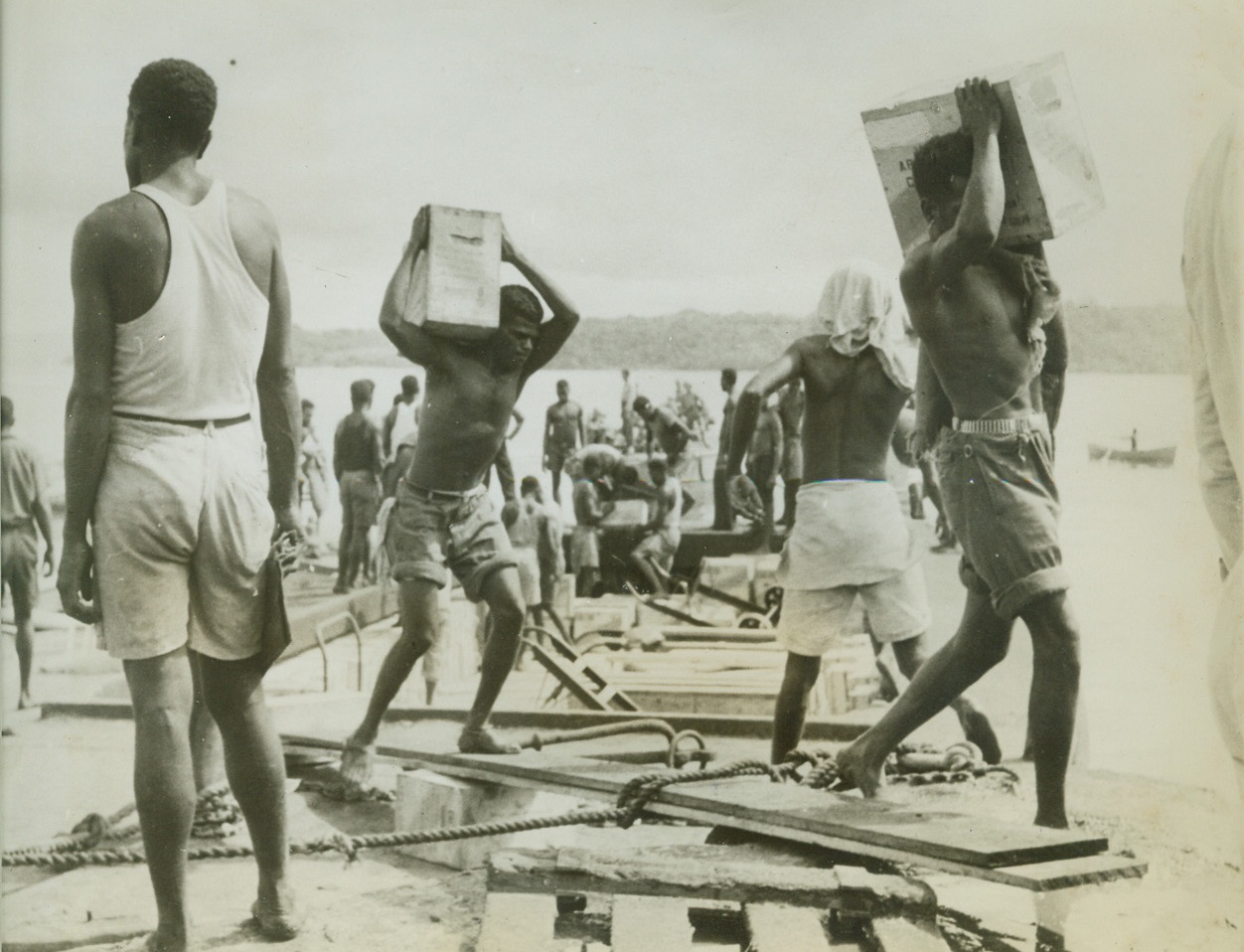
Natives Unload Supplies for Pacific Base, 8/13/1942. Natives of an island in the Southwest Pacific unload supplies brought ashore by a lighter for a U.S. operations base which will be used to prevent further Japanese conquests in the area. Credit line (ACME);
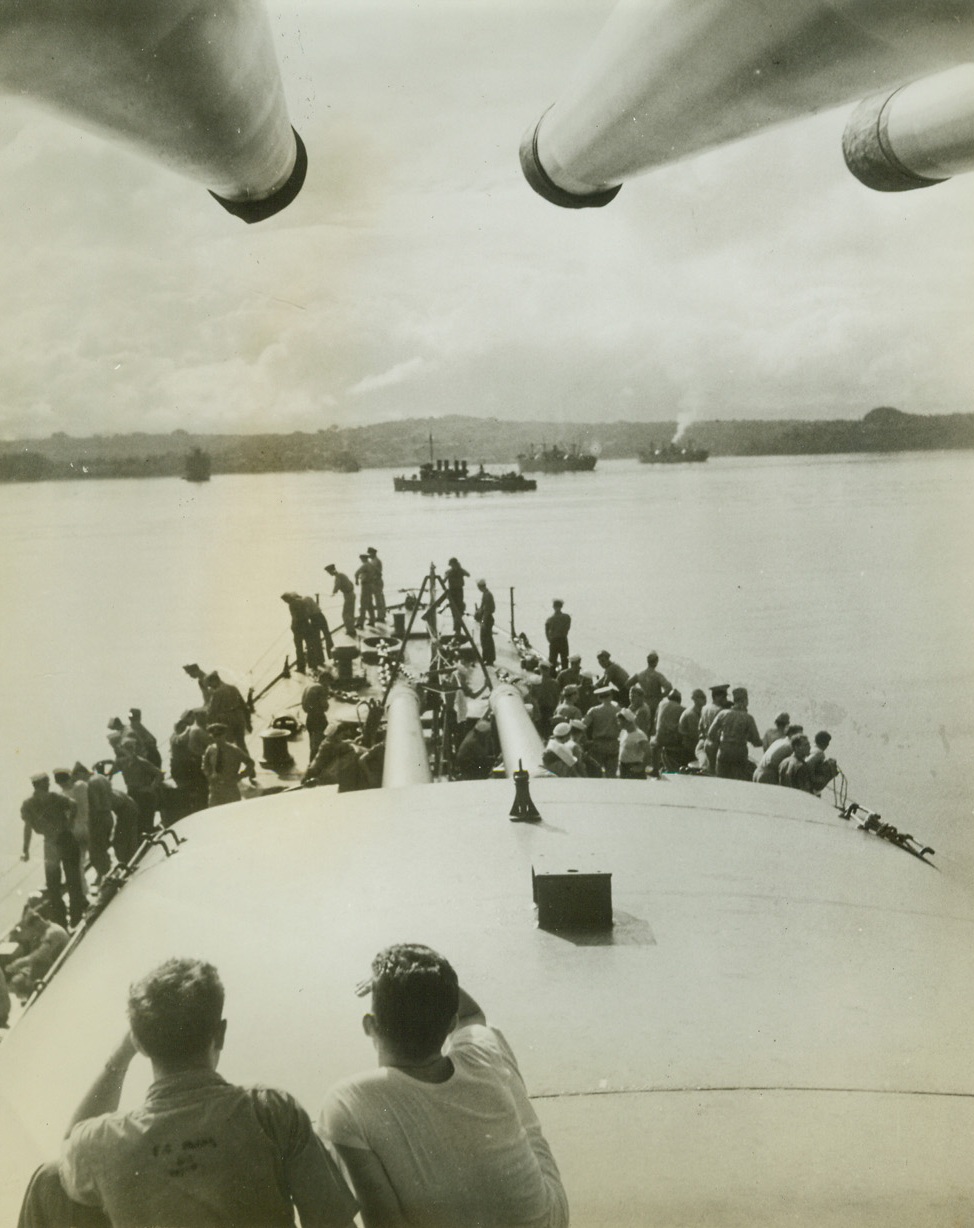
Convoy Supplies a Pacific Outpost, 8/13/1942. Under the protective eyes of a cruiser (foreground), and a destroyer (center), cargo ships of a United States convoy ease into an undisclosed harbor in the Southwest Pacific. Once safely in, they’ll drop anchor, and unload supplies for an American base. Credit line (ACME);
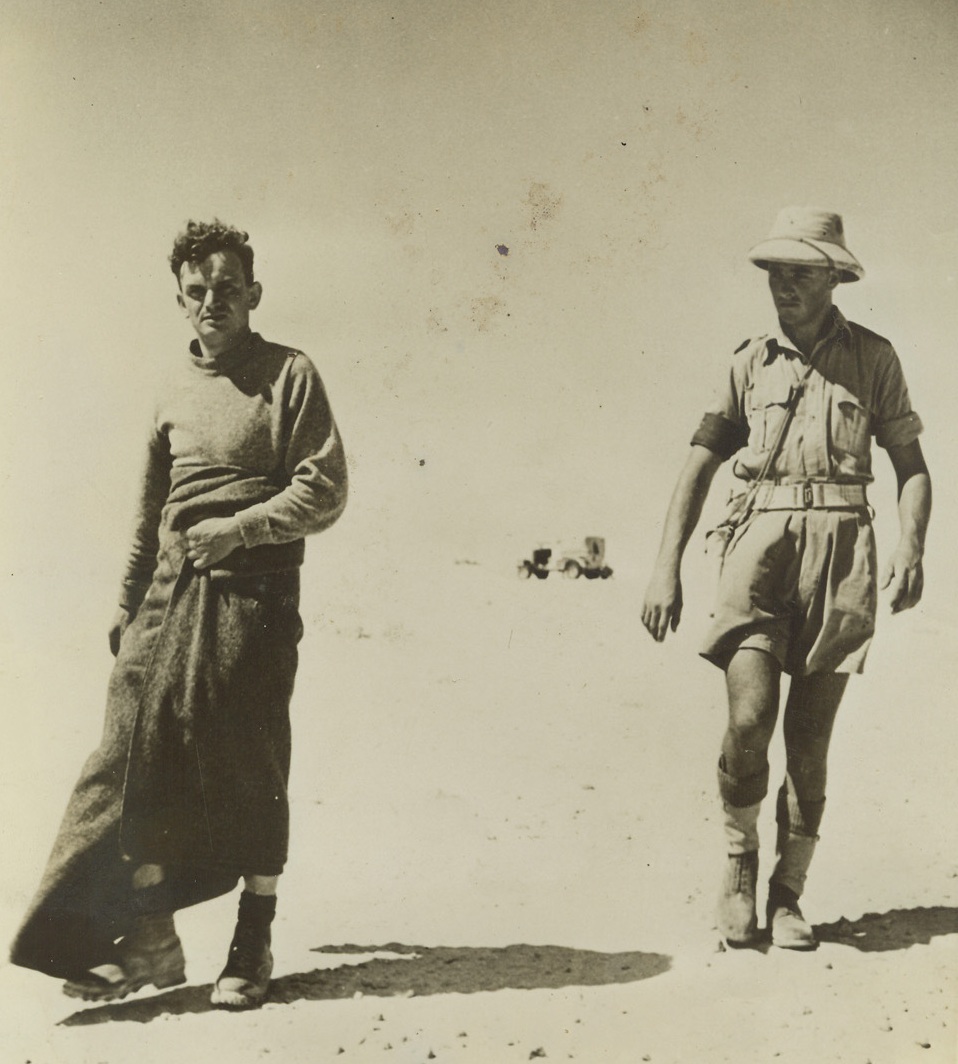
Desert Mornings Are Cold, 8/31/1942. Egyptian Desert – This Italian prisoner, under guard of a New Zealand military policeman, was captured before he could get into his pants during a dawn attack in the Egyptian desert. He wears the blanket as much for comfort as modesty, since the early morning air is cold in the desert. Credit line (ACME);
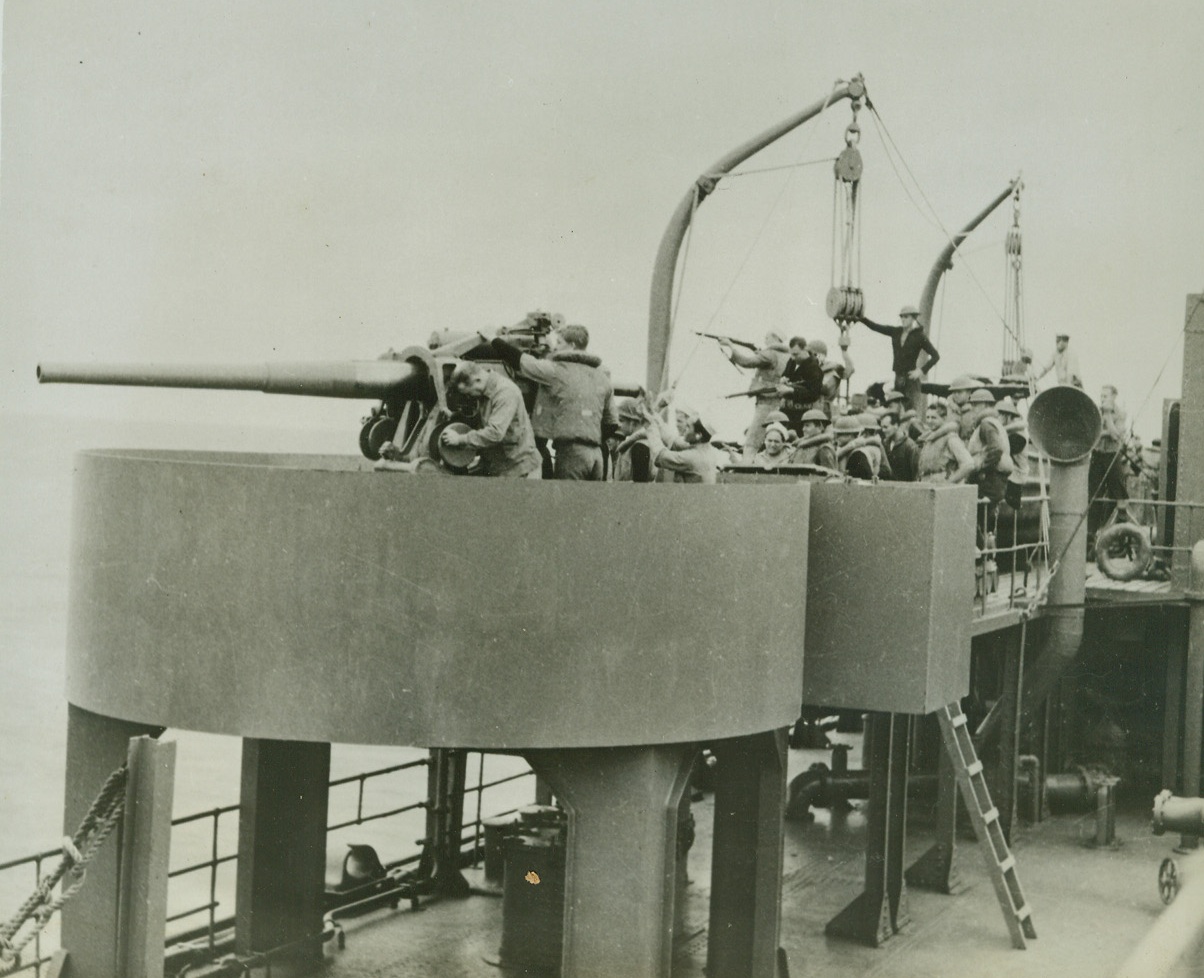
Tense Moment on a U.S. Tanker in a Convoy, 8/4/1942. Life-jacketed U.S. sailors leap to their guns as a submarine alarm is sounded on a naval tanker in a convoy somewhere in the Indian ocean. Credit line (ACME);
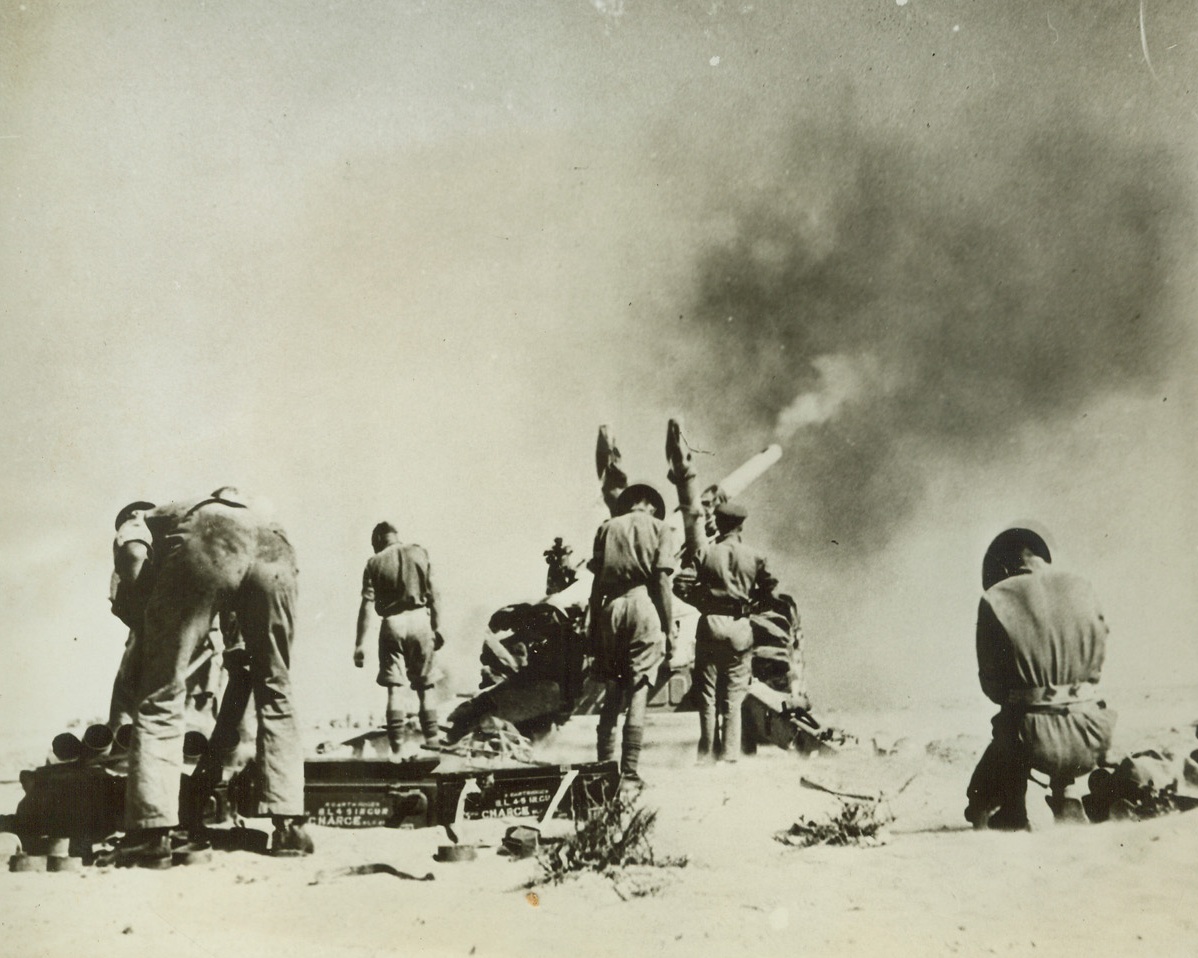
New Zealanders in Battle of Egypt, 8/3/1942. These photos of New Zealanders in the battle of Egypt were taken by official photographers during action on the El Alamein front. Fierce New Zealand troops have joined other United Nations forces on the fighting front, and have done much to stem the axis march toward Alexandria, large British naval base in Egypt. These are said to be the first pictures of New Zealanders’ participation in the Western Desert campaign during June and July, 1942. New York Bureau Gun of this New Zealand heavy artillery unit roars into action in the battle for Egypt. Sand storms and heat make conditions trying, but tough New Zealanders can take it. Credit line (ACME);
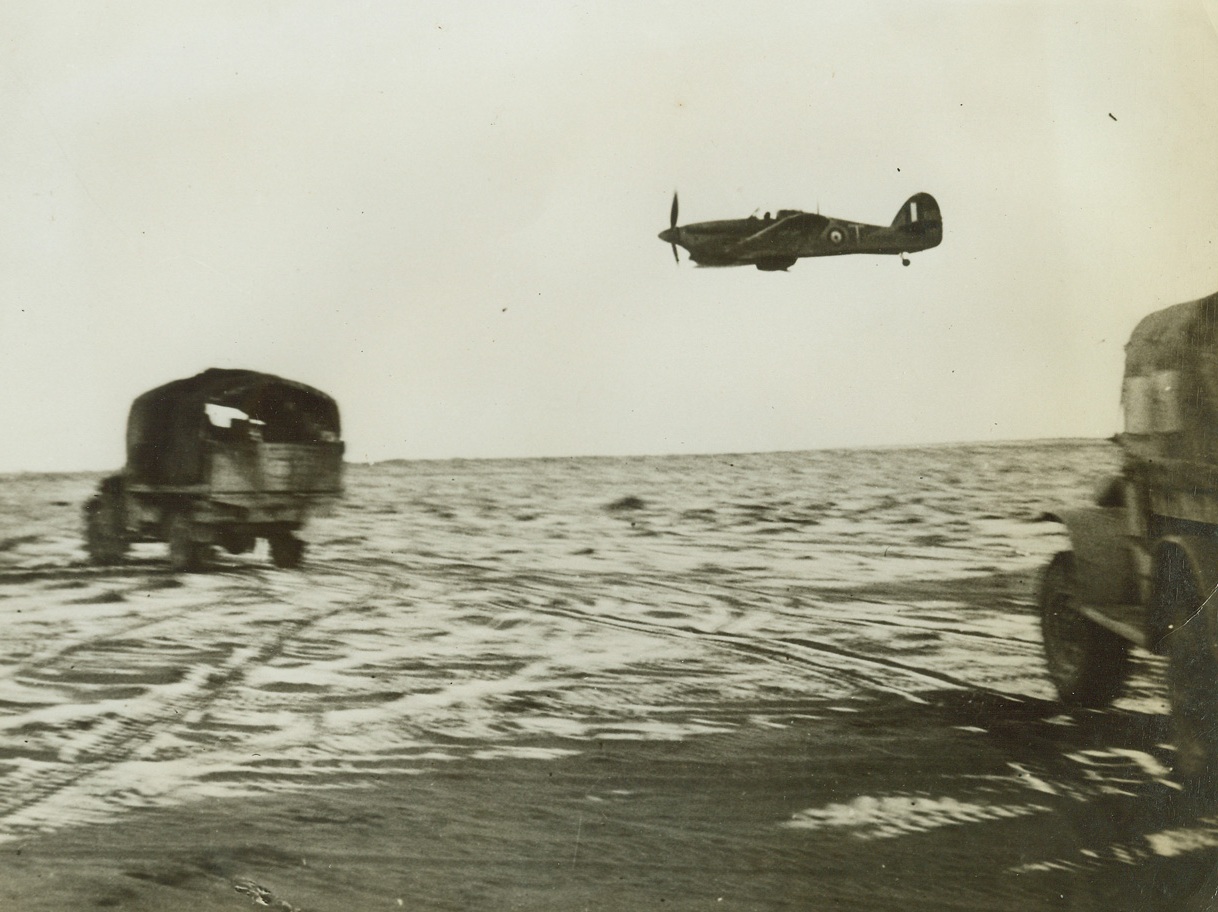
New Zealanders in Battle of Egypt, 8/3/1942. These photos of New Zealanders in the Battle of Egypt were taken by official photographers during action on the El Alamein front. Fierce New Zealand troops have joined other United Nations forces on the fighting front, and have done much to stem the Axis march toward Alexandria, Large British Naval Base in Egypt. These are said to be the first pictures of New Zealanders’ participation in the Western Desert Campaign during June and July, 1942. Low-flying fighter plane patrols New Zealand colums as they leave Mersa Matruh bound for Minqar Qaim to make contact with the enemy. Only once, at the beginning of this campaign was the transport bombed Credit Line (ACME) 8/3/42;
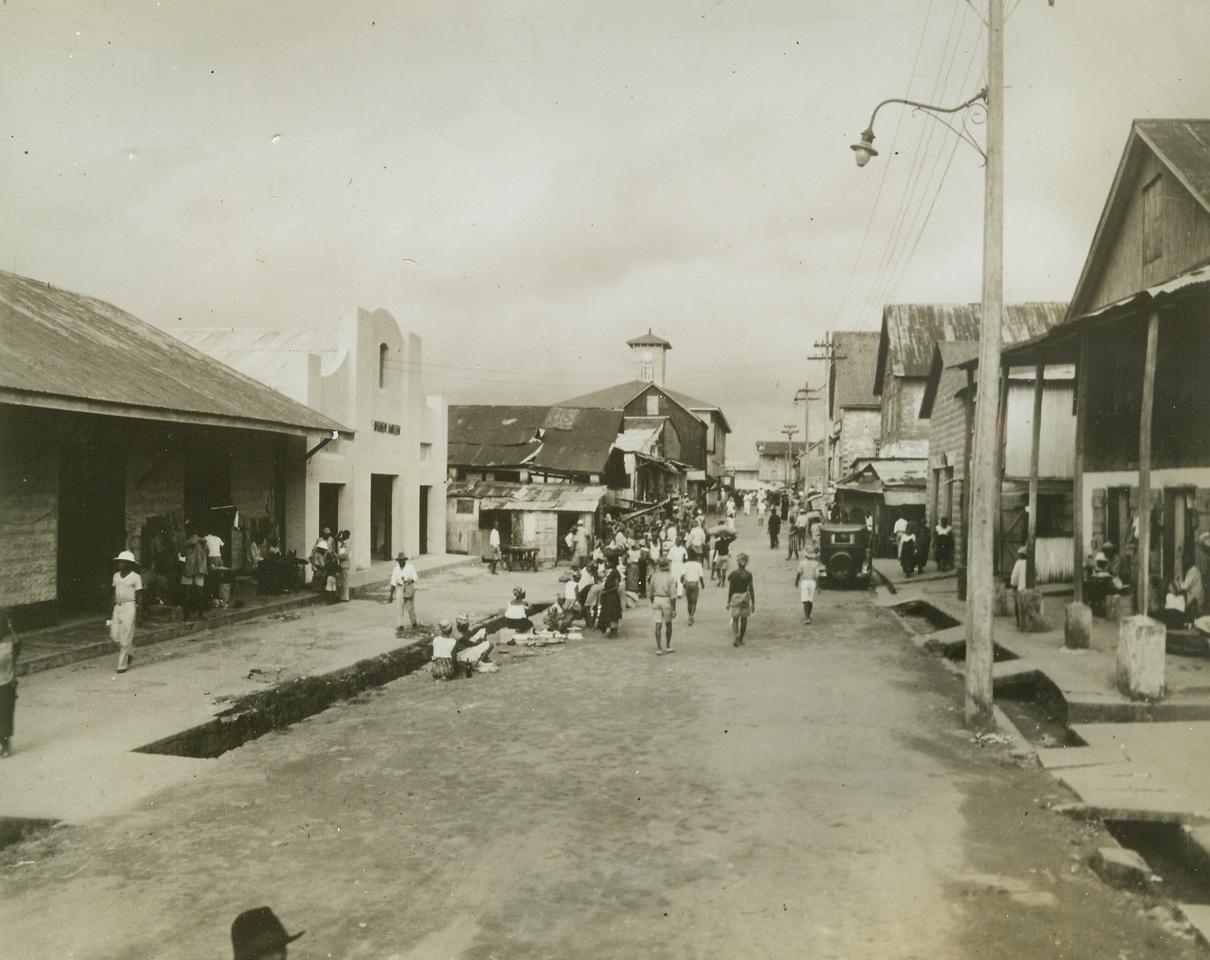
Shopping Center of Liberia, 8/27/1942. Monrovia, Liberia—View of Water Street, on the waterfront on Monrovia, capital of Liberia. Here are located most of the trading concerns in the city. At the left are two European trading shops; further along, under the broken down roof, is a native sea-fish market. The clock tower in the center background surmounts the Government Customs Building. The street has open sewers, but is electrically lighted at night, the power coming from a government-operated plant. Editors: These photos of scenes in Liberia are sent to you for use with future wire stories, please file them for reference. Credit: Firestone Company—from ACME.;
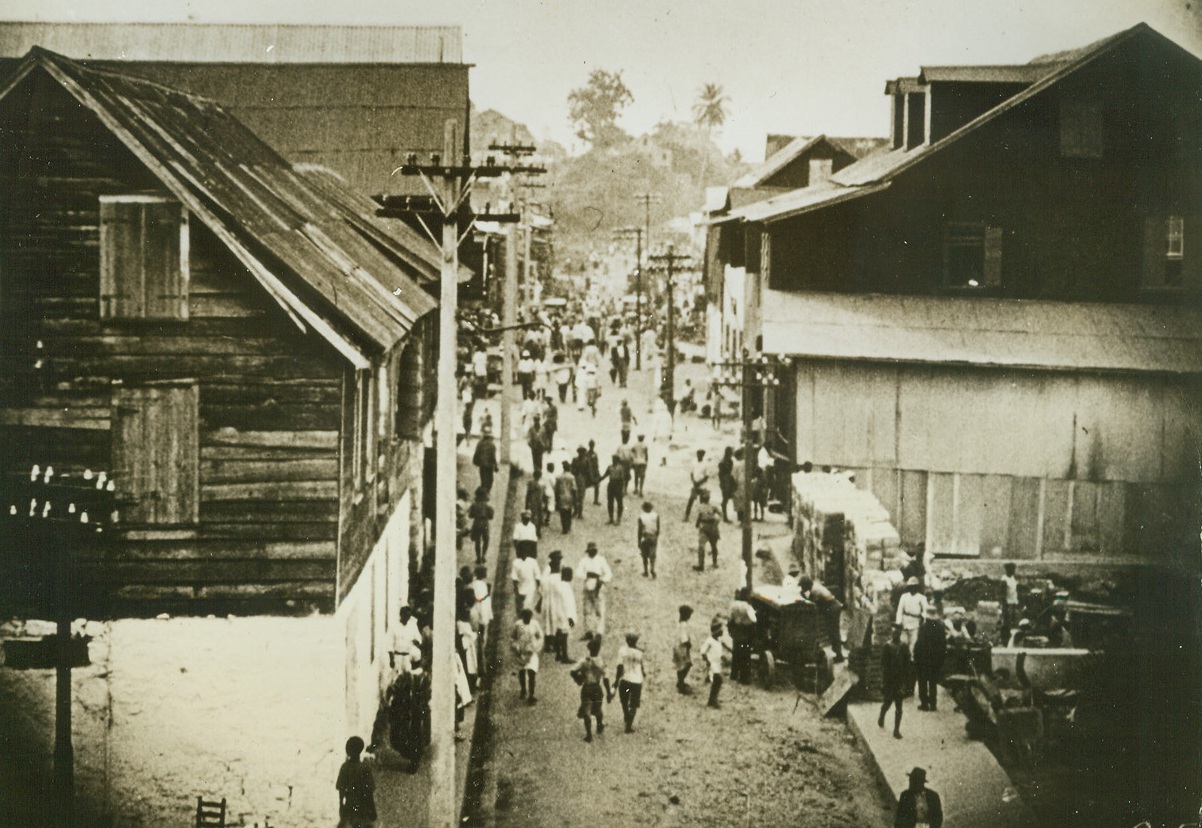
Liberian Street Scene, 8/27/1942. Monrovia, Liberia—American cultivation of rubber began on a large scale in Liberia, on the west coast of Africa, when the Firestone organization began its planting on two 50,000 acre plantations. Since then, American institutions—chain stores, electric lights, autos, movies, radio, and paved streets—have become familiar sights in this 100-year-old Negro Republic. Here is a typical street scene in the native quarter of Monrovia, the capital of Liberia, which was named after President Monroe. Editors: these photos of scenes in Liberia are sent to you for use with future wire stories. Please file them for reference. Credit: ACME.;
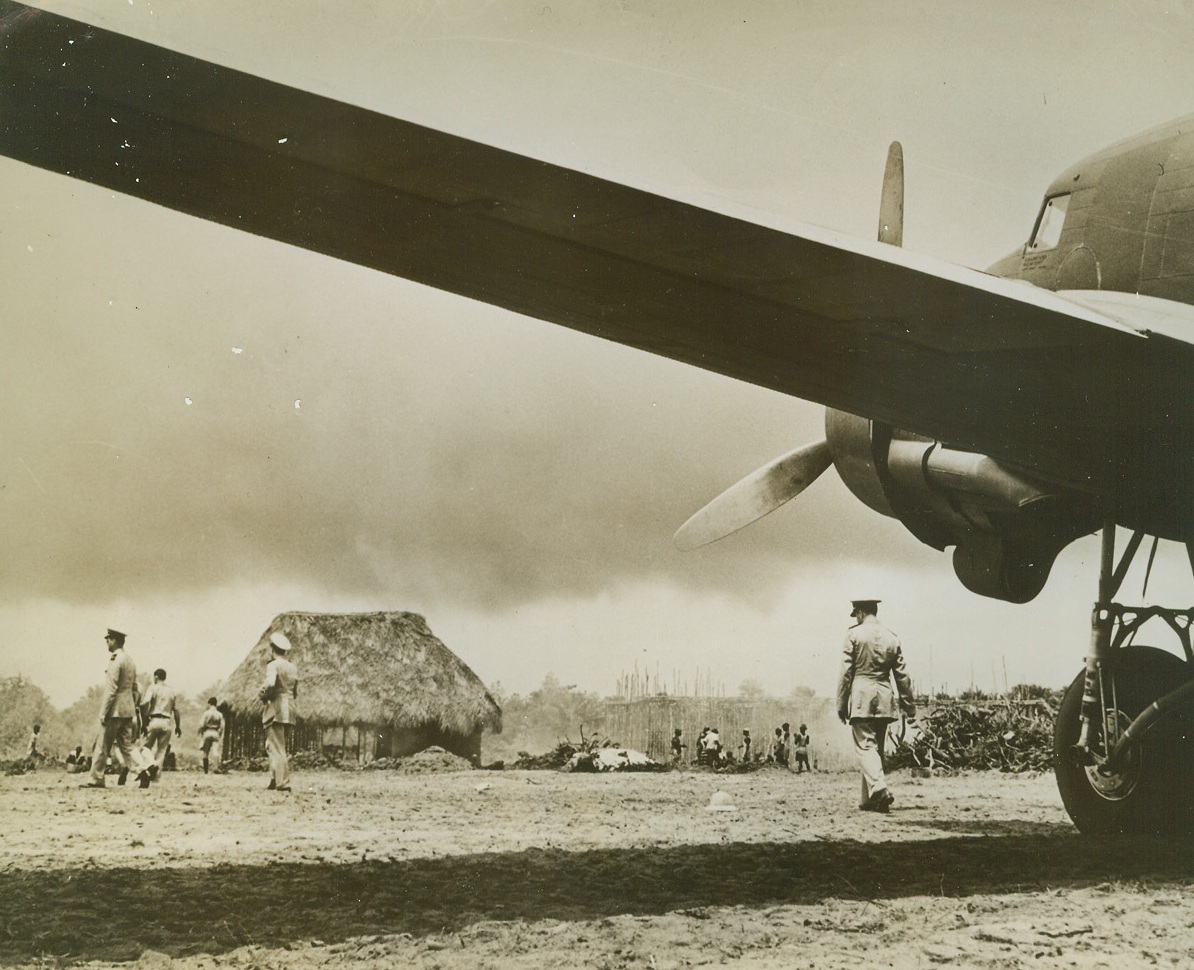
Hut in the Way of Progress, 8/26/1942. Liberia—A big modern airliner spreads its wing symbolically over a crude thatched native hut standing on a field in Liberia which Pan American Airways is converting into an airport for its proposed trans-oceanic service across the South Atlantic. Passed by censor. Credit: ACME.;
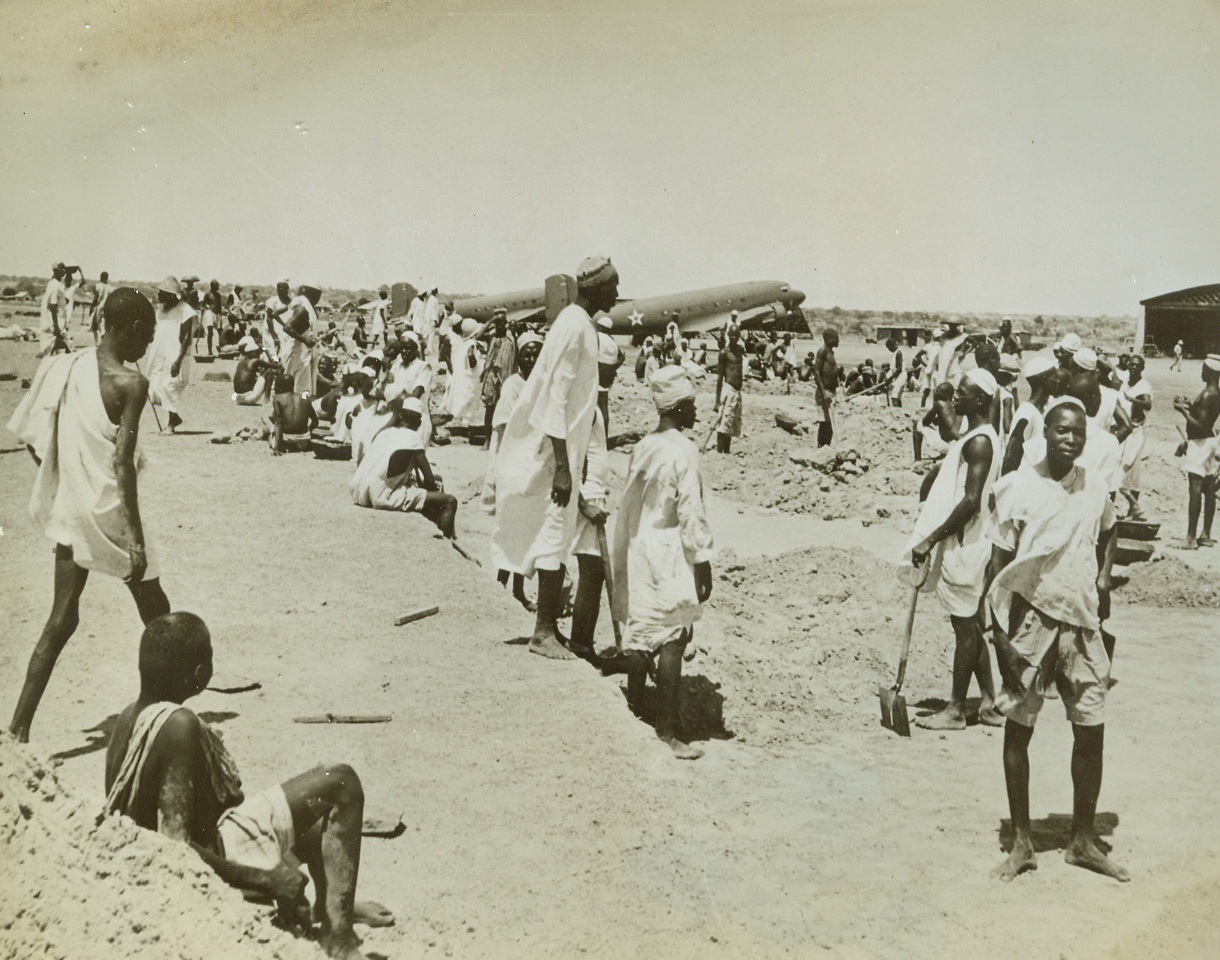
Liberian Airport Builders, 8/26/1942. Liberia—Clad in white robes, sheets, or just shorts, natives grade the earth for a new airport somewhere in Liberia which Pan American Airways is building for its proposed trans-oceanic service across the South Atlantic. Passed by censor. Credit: ACME.;
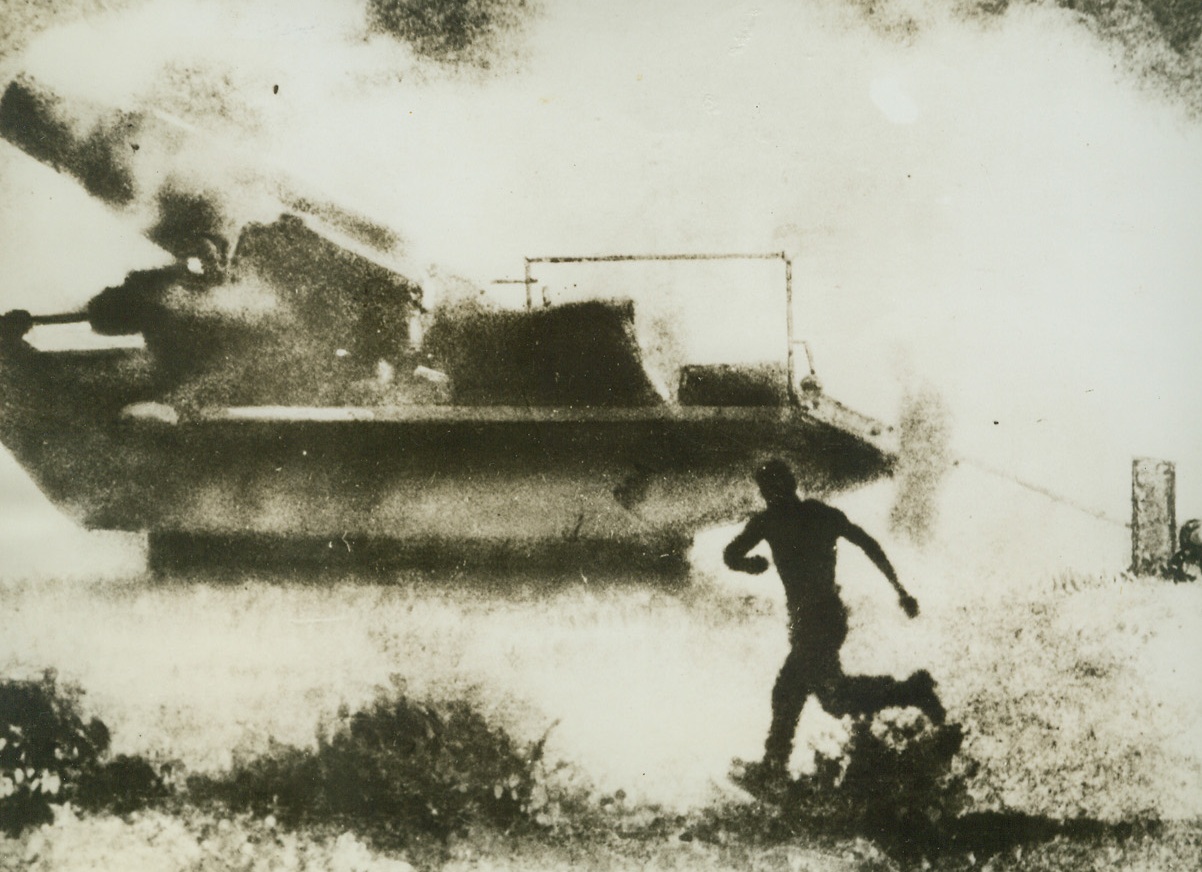
German Gun Fires in Crimea, 8/13/1942. On the Southern Russian Front—This photo from a German source shows, according to the caption which accompanied the picture, a giant Nazi gun of a secret new type, firing in the Crimea. The gun was first used in the capture of Sevastopol and is said to fire a shell weighing several hundredweights. It is believing that the weapon is an improvement of the Skoda 12-inch mortar used in the last war. (Passed by censors). Credit: ACME.;
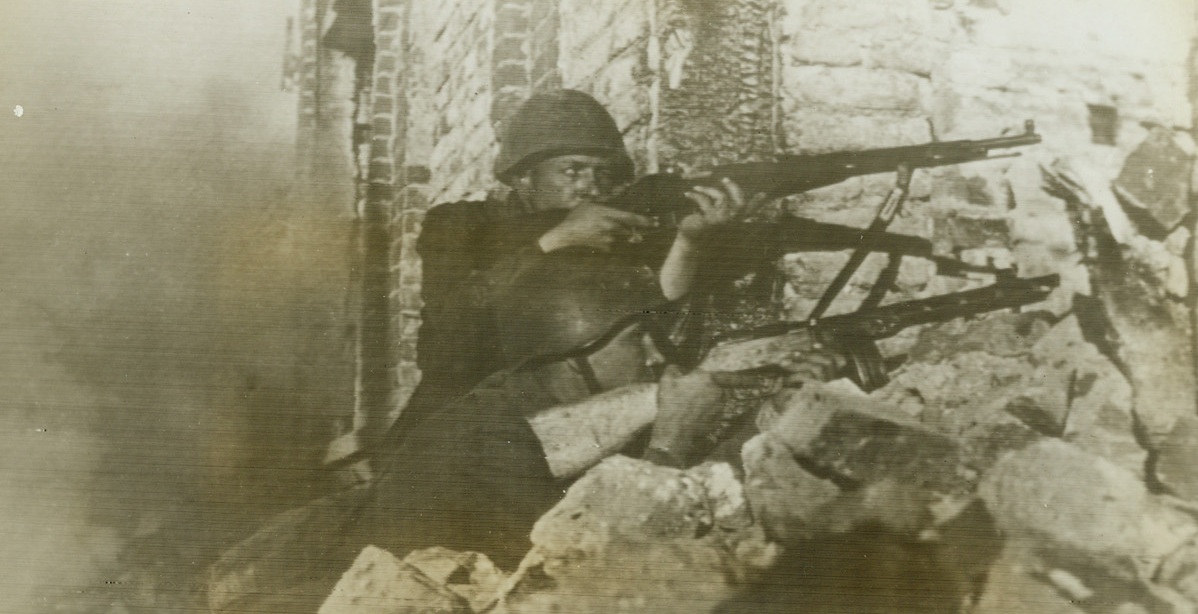
Driving Germans Out of a Russian Town, 8/30/1942. Soviet-German Front—A Soviet rifleman and submachine-gunner dislodge Germans from shelters during street fighting in a town in the Pogoreloye-Gorodische area on the Rzhev front as the Nazis get out of town under a Red Army offensive. Photo was flashed from Moscow to New York today by radio. Passed by Soviet censor. Credit: ACME radiophoto.;
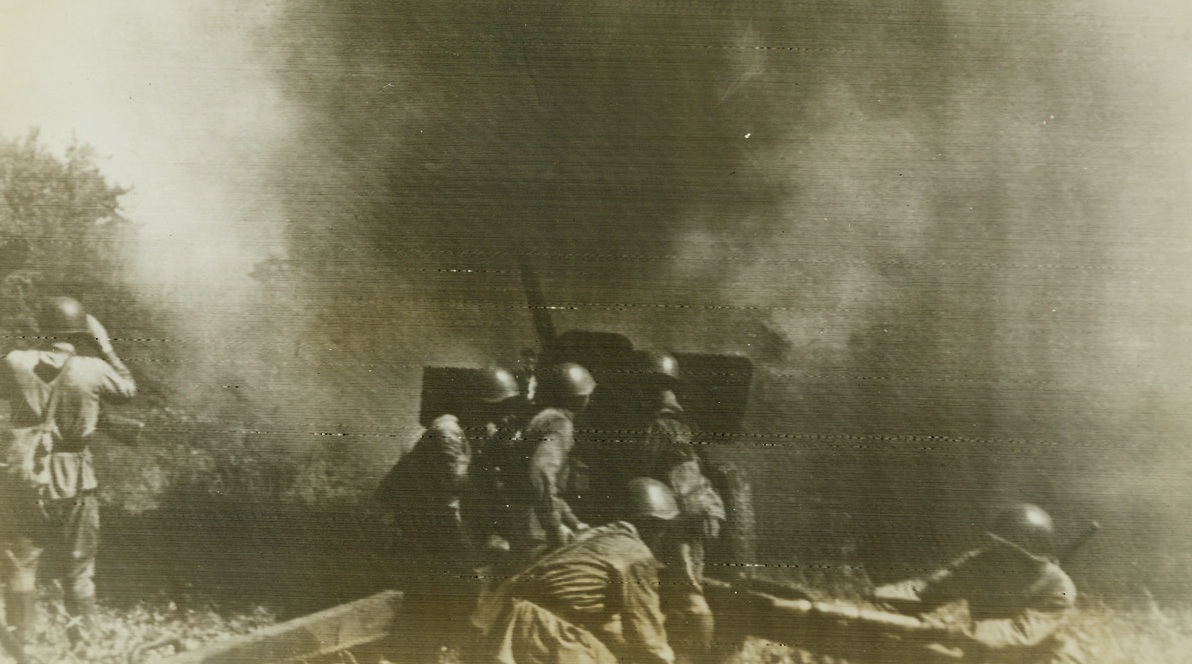
Anti-Tank Fire on the Don Front, 8/30/1942. Soviet-German Front—Red Army men fire a 76-millimeter anti-tank gun from an uncovered position in the Don River region. Photo was flashed to New York from Moscow today by radio. Passed by Soviet censor. Credit: ACME radiophoto.;
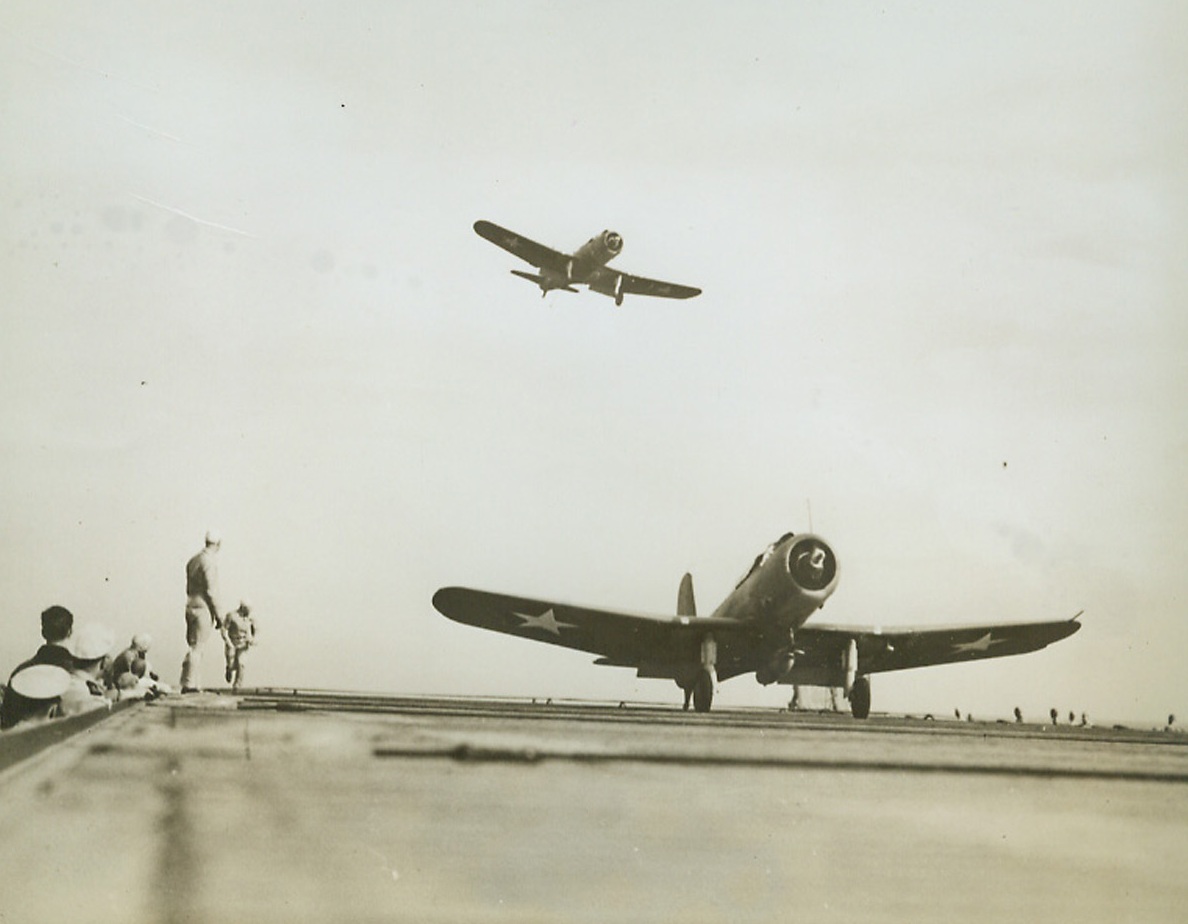
Happy Landings, 8/4/1942. Washington—The remarkable thing about this familiar scene is that the aircraft carrier on which these dive-bombers are landing and taking off is a former merchant ship converted by the skill of American shipyard workers into the aircraft carrier Charger. Uncle Sam is making use of every facility for hurling planes against enemy sea forces.Credit: Official U.S. Navy photo from ACME.;
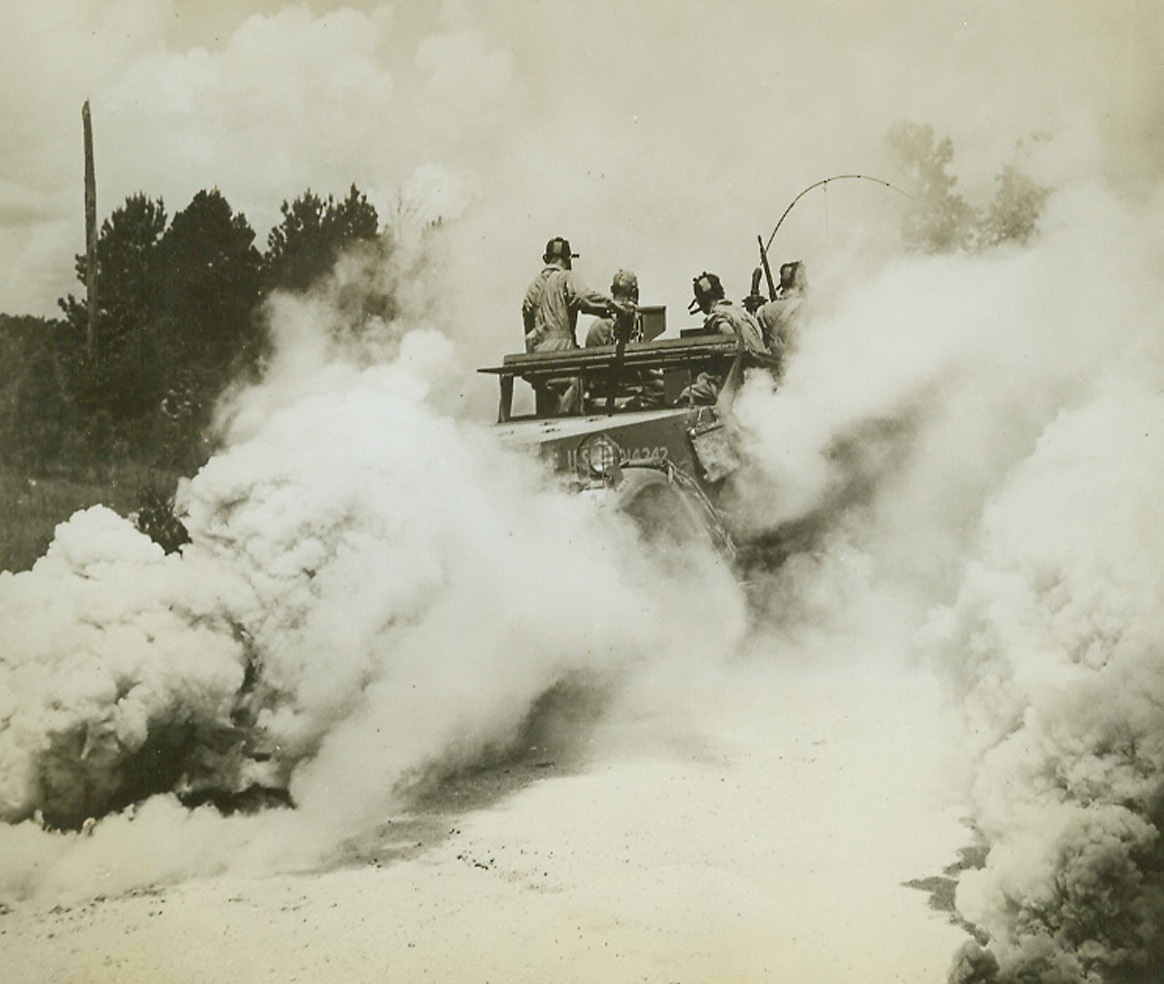
Smoky Refuge, 8/27/1942. This half-track is enveloped in a smoke screen as its crew concentrates on attack from the rear while solving one of the problems of the Third Army Louisiana Maneuvers.Credit: U.S.A. Signal Corps photo from ACME.;

Sky Transport, 8/27/1942. This super transport plane was launched by Consolidated Aircraft Corp. at its Texas plant more than a month ahead of schedule. The new long-range transport, a conversion of the Consolidated B24 Liberated Bomber, is now in mass production. The four-engine ship incorporates all the desirable features of the 20-ton bomber and will carry a pay-load cargo of 10 tons, fly faster than 300 mph, and range 4,000 miles. Inauguration of the transport assembly line gives Consolidated’s Texas plant the longest, continuously-moving straight production line in operation in the aircraft industry. Production of super transports means no halt in production of Liberator bombers.Credit: ACME.;

He Reached Our Goal, 8/27/1942. New Haven, Conn.—Helping the Jap on his way out is Helen Cherback, one of the thousands of employees at New Haven’s Winchester Repeating Arms Co. who signed up 100 per cent for war bonds. Helen is pushing the Jap to the 100 per cent mark as he flees from the handful of bullets held by a Winchester worker. The company is the largest plant in Connecticut to reach 100 per cent participation under the Treasury’s payroll deduction plan.Credit: ACME.;
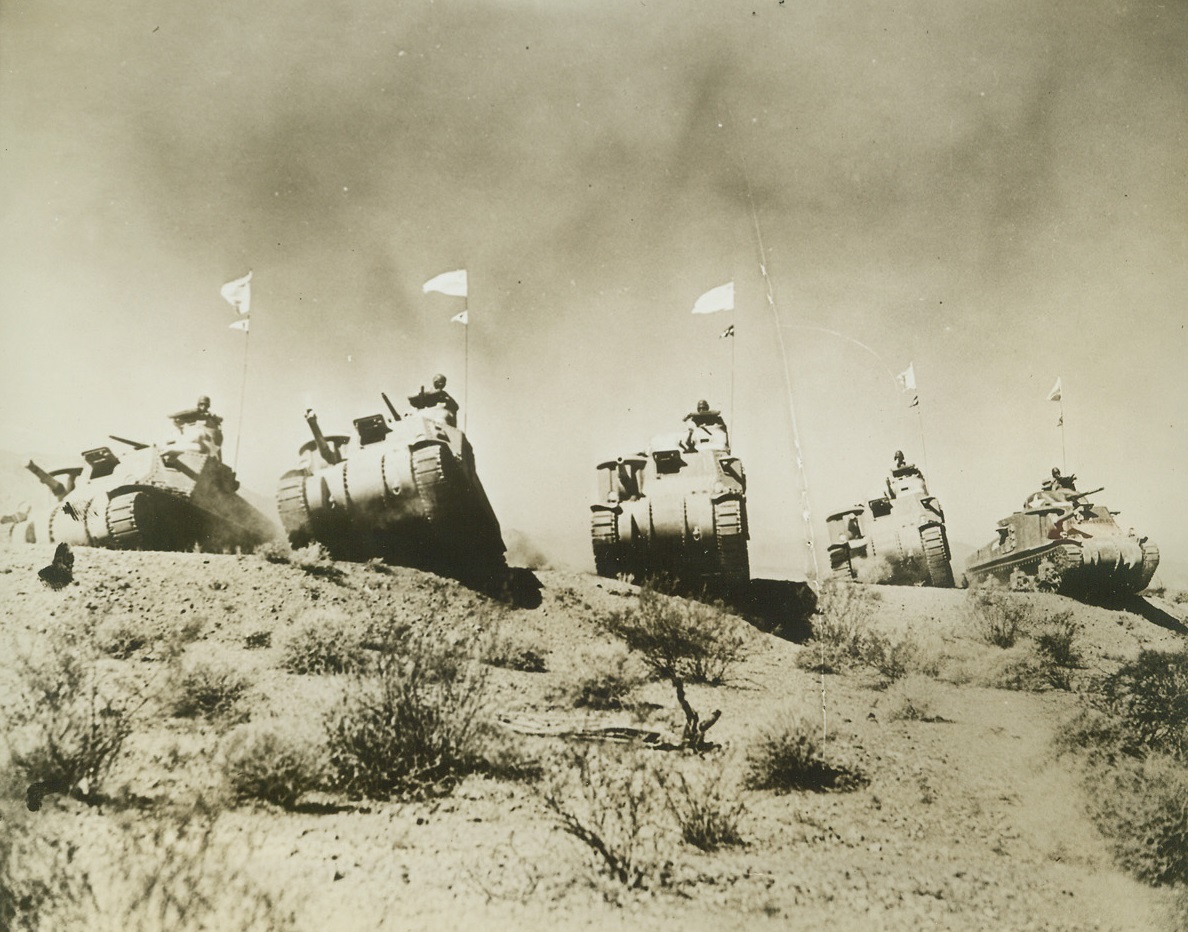
Tank Crews Train for Desert Warfare, 8/27/1942. With U.S. Army in California Desert – Kicking up sand in clouds that darken the sky, these U.S. Tanks clank over a sand dune somewhere in the California desert during extensive battle maneuvers over the world’s most grueling terrain. Credit: ACME;
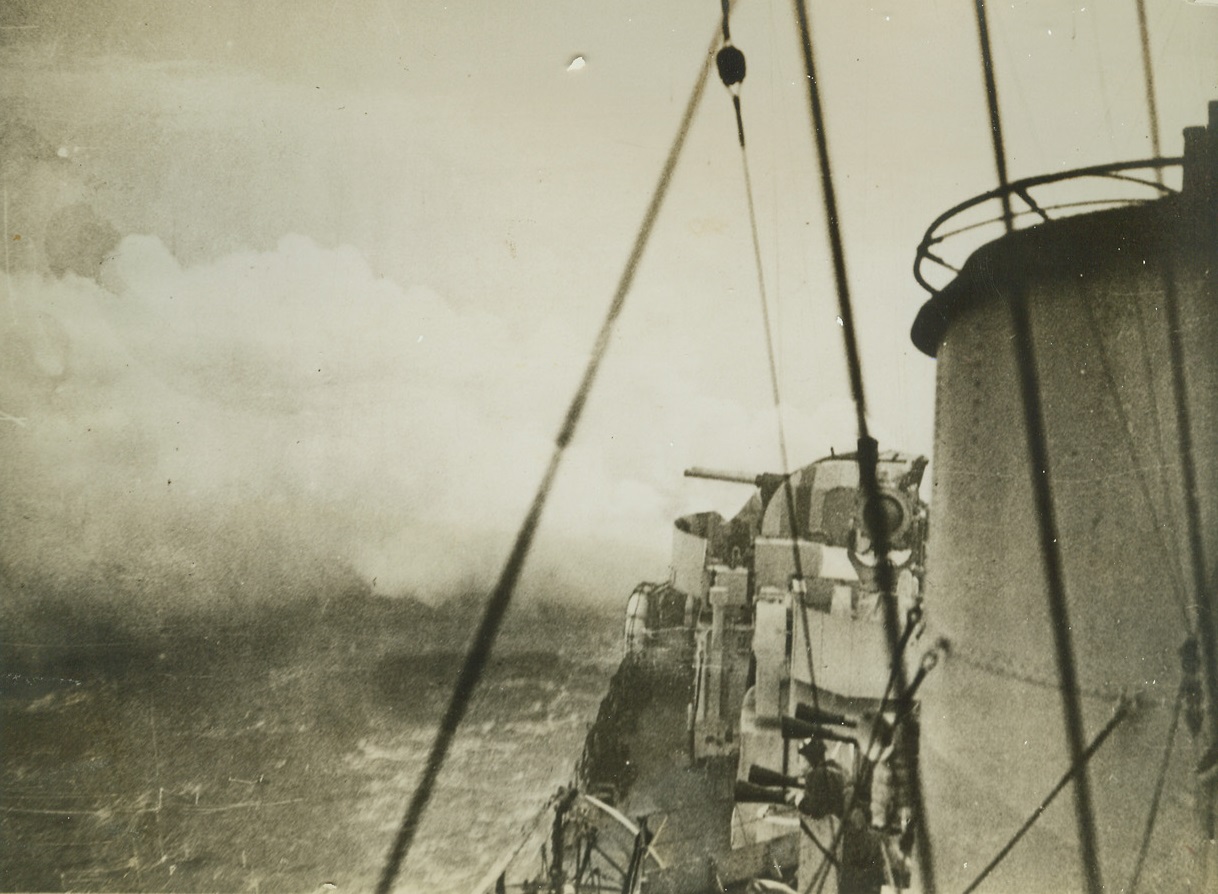
Dieppe Raid – A Miracle of Cooperation, 8/27/1942. The raid on the French coastal town of Dieppe, August 19, by United Kingdom Commandos and American Rangers, was a miracle of cooperation of land, sea and air forces. The R.A.F., U.S. Army Air Forces, and Royal Navy worked hand in hand to effect the landing of the raiders. Here, a Royal Navy Destroyer lays a smoke screen to protect landing craft from enemy eyes. (Passed by Censors). Credit: ACME;
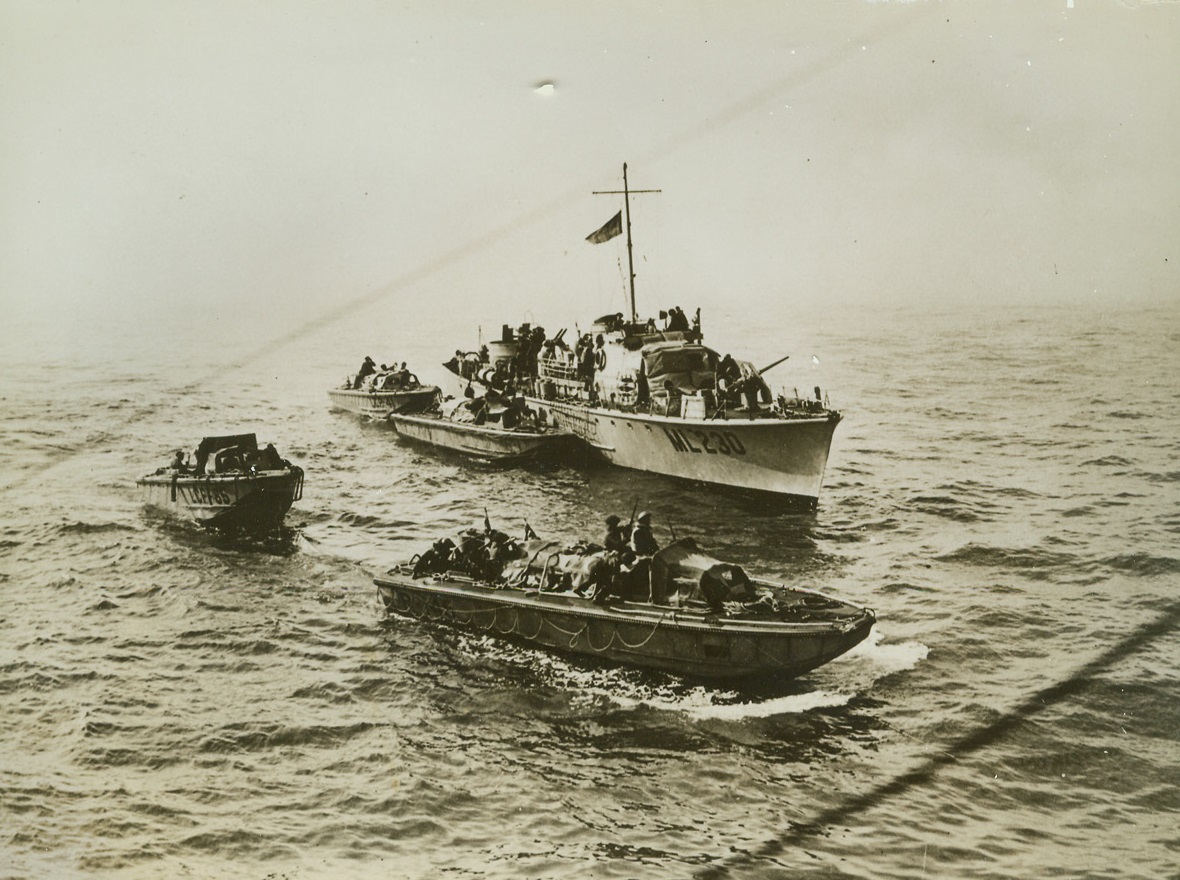
Dieppe Raid- A Miracle of Cooperation, 8/27/1942. The raid on the French coastal town of Dieppe, August 19, by United Kingdom Commandos and American Rangers, was a miracle of cooperation of land, sea and air forces. The R.A.F., U.S. Army Air Forces, and Royal Navy worked hand in hand to effect the landing of the raiders. Here, a Royal Navy Launch watches over four of the many landing craft used during the raid. (Passed by Censors) Credit: ACME;
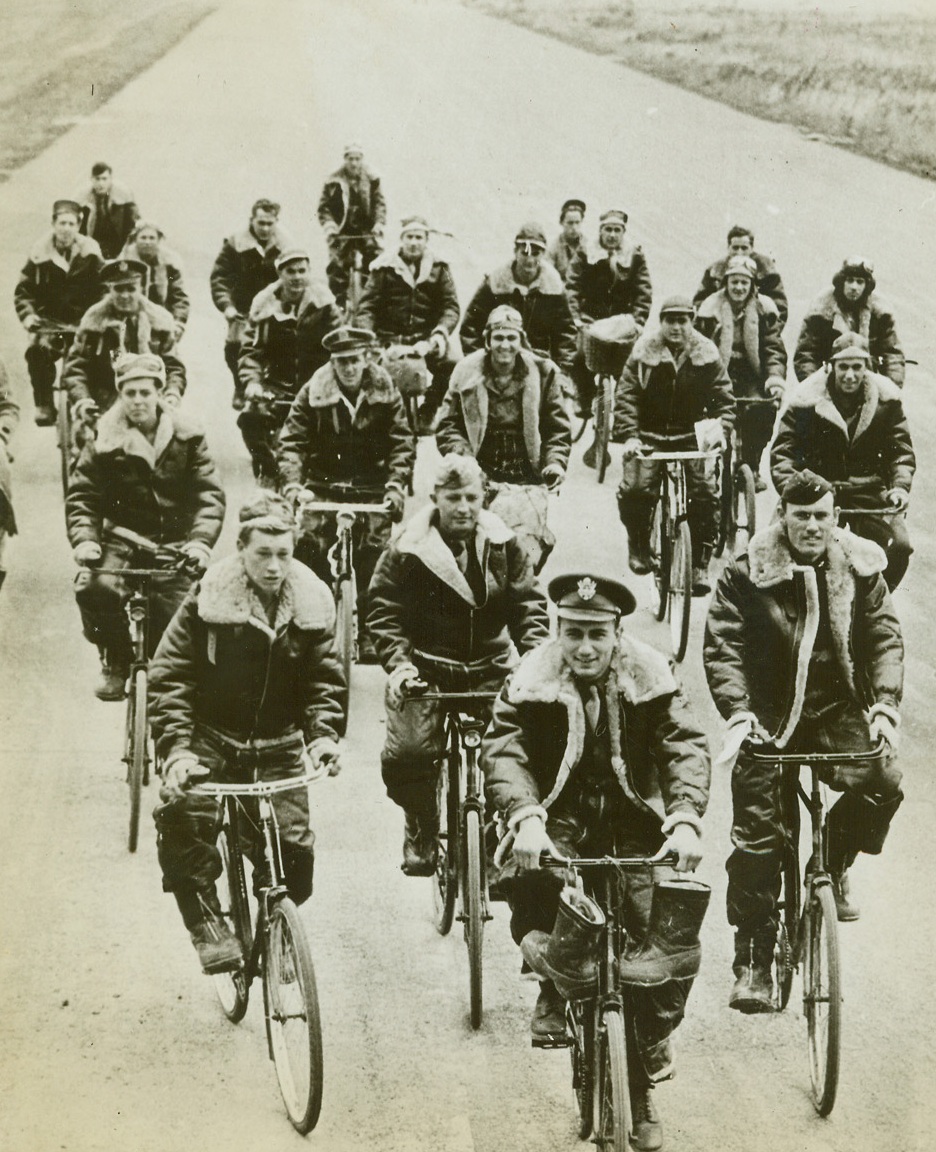
U.S. FLYERS WAIT FOR THE “ZERO HOUR”, 8/5/1942. SOMEWHERE IN BRITAIN – U.S. Army Air Force bomber crews, waiting along with many other American flyers, for the “zero hour” that will send them over Germany with thousands of tons of bombs, cycle across a huge air field to their planes for a flight, “somewhere in Britain.” This is one of the first photos to reach the United States, of American operational bombing stations in Britain. Credit: Acme;
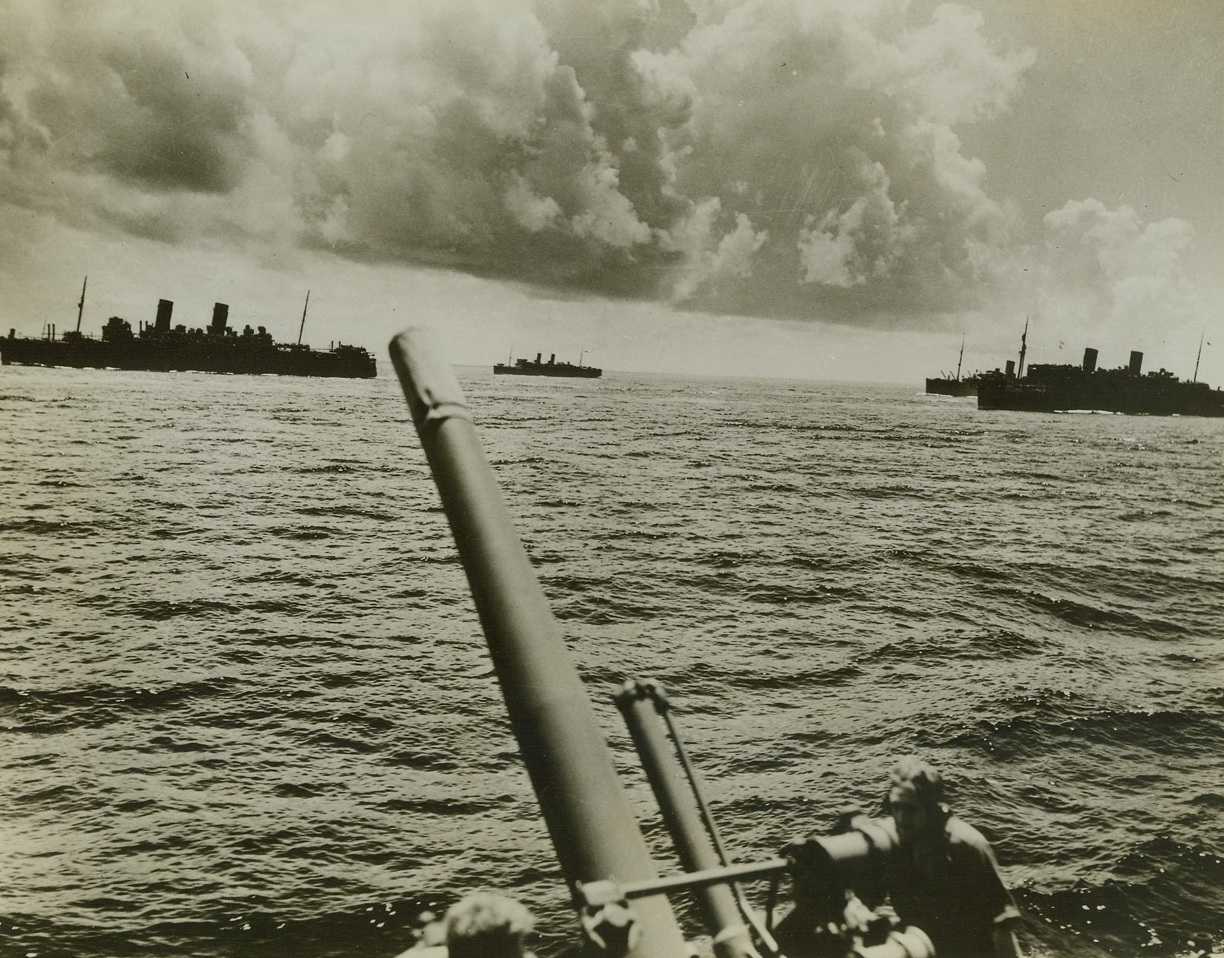
READY FOR RAIDERS, 8/3/1942. The crew of a gun on a transport, part of a convoy bound for England, as they keep on constant watch for enemy raiders. Other ships of the United Nations convoy can be seen in the background.Credit: Acme;

DIEPPE RAID – A MIRACLE OF COOPERATION, 8/27/1942. The raid on the French coastal town of Dieppe, August 19, by United Kingdom Commandos and American Rangers, was a miracle of cooperation of land, sea and air forces. The R.A.F., U.S. Army Air Forces, and royal Navy worked hand in hand to effect the landing of the raiders. Here, Douglas “Boston” Bomber of the R.A.F. drops bombs on an enemy target. Far below, British naval craft can be seen laying a smoke screen.Credit: Acme;
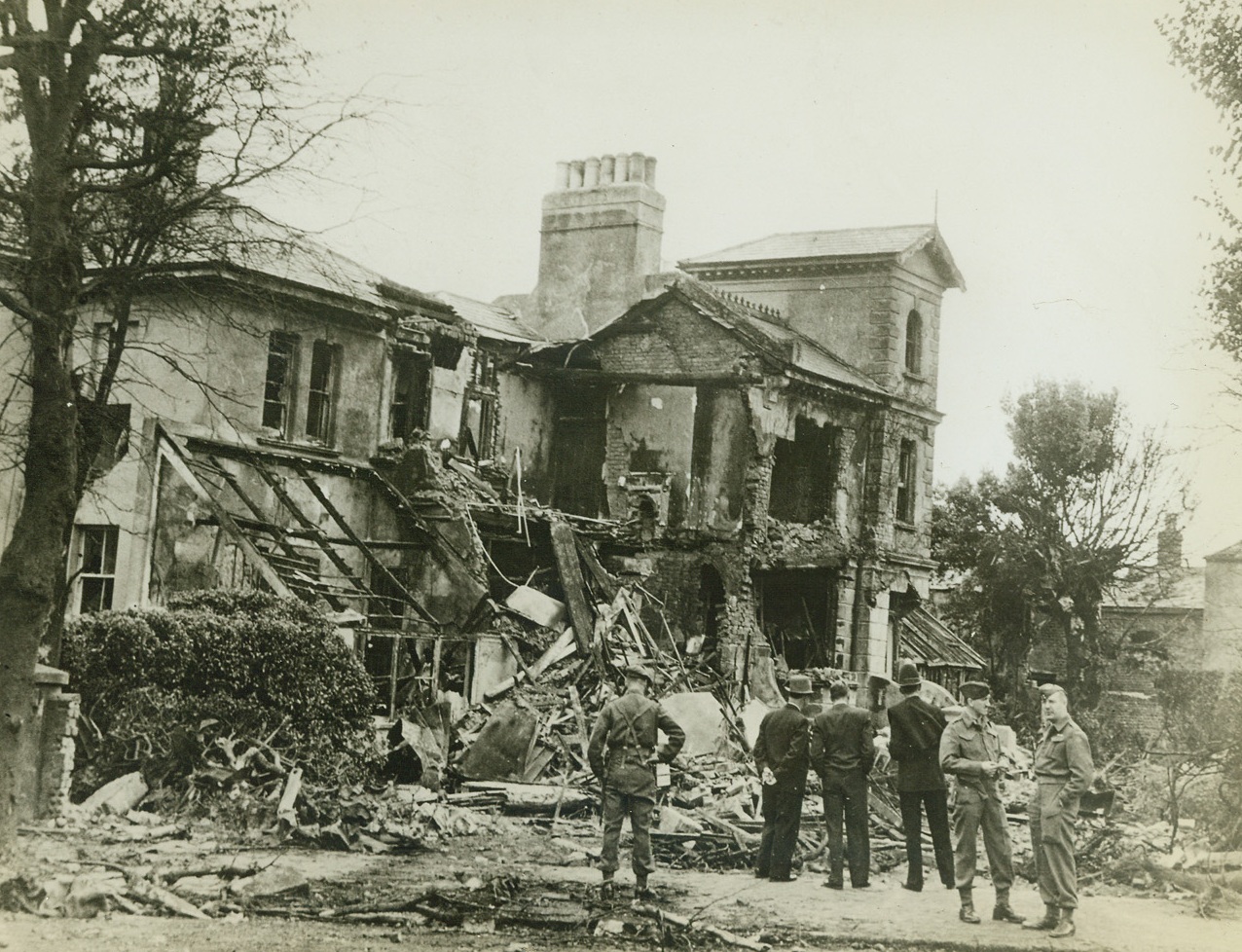
Nazi Funeral Pyre in Britain, 8/13/1943. England – One of two houses damaged when a German Heinkel III crashed after its motors had stopped suddenly, its bomb load exploding and setting the houses afire, at a South Coast town in England. Four people sleeping in the houses were treated for burns. Note hole in roof of second house, (right background in photo). (Passed by censors) Credit: ACME;
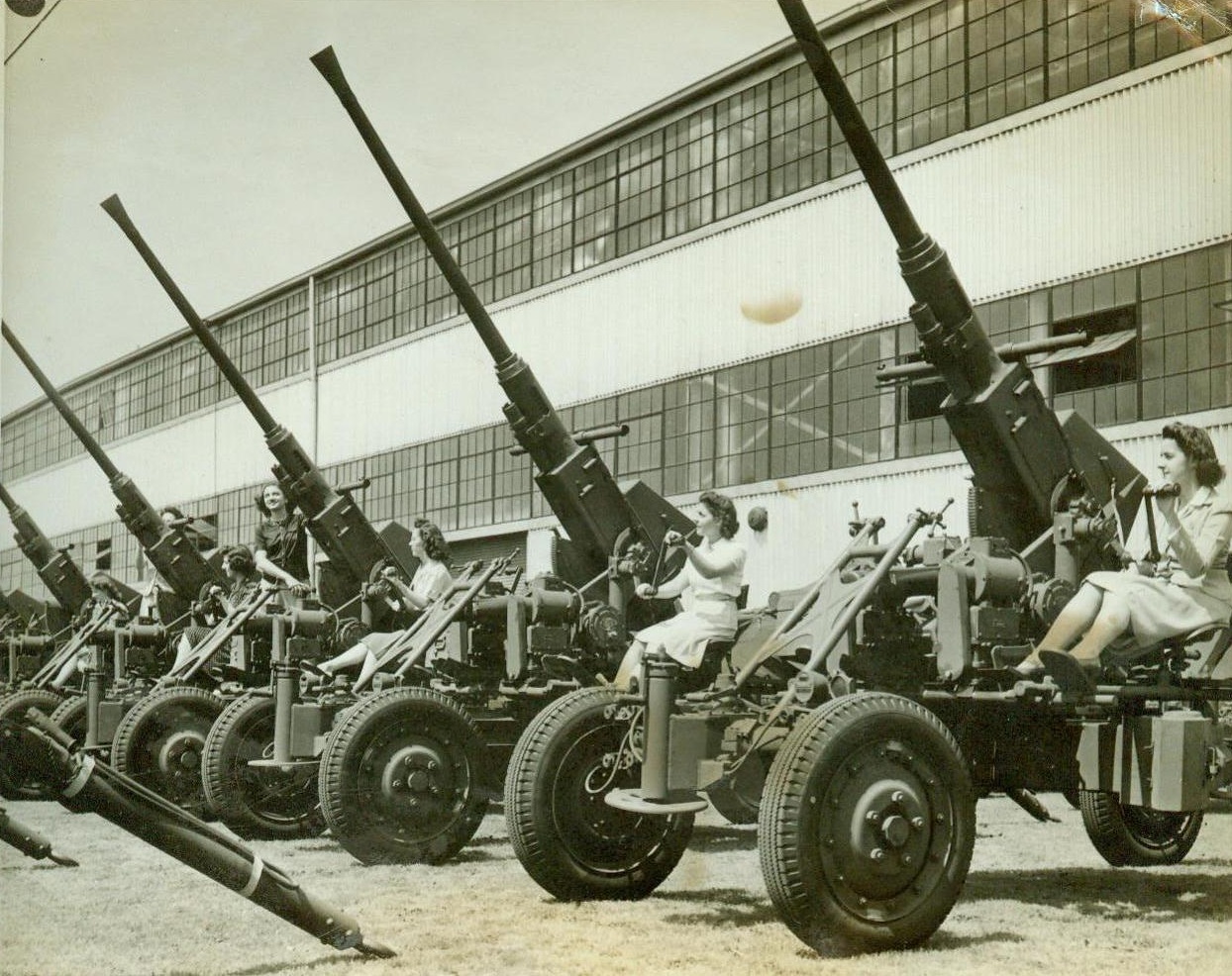
Big Aircraft Guns Easily Maneuvered, 8/28/1943. Akron, Ohio- These Big Bofors Anti-Aircraft guns produced by Firestone Tire and Rubber Co., here are easily maneuvered, as demonstrated by the girls manning the guns in the above photo. Guns are being produes in quantities on production lines here;
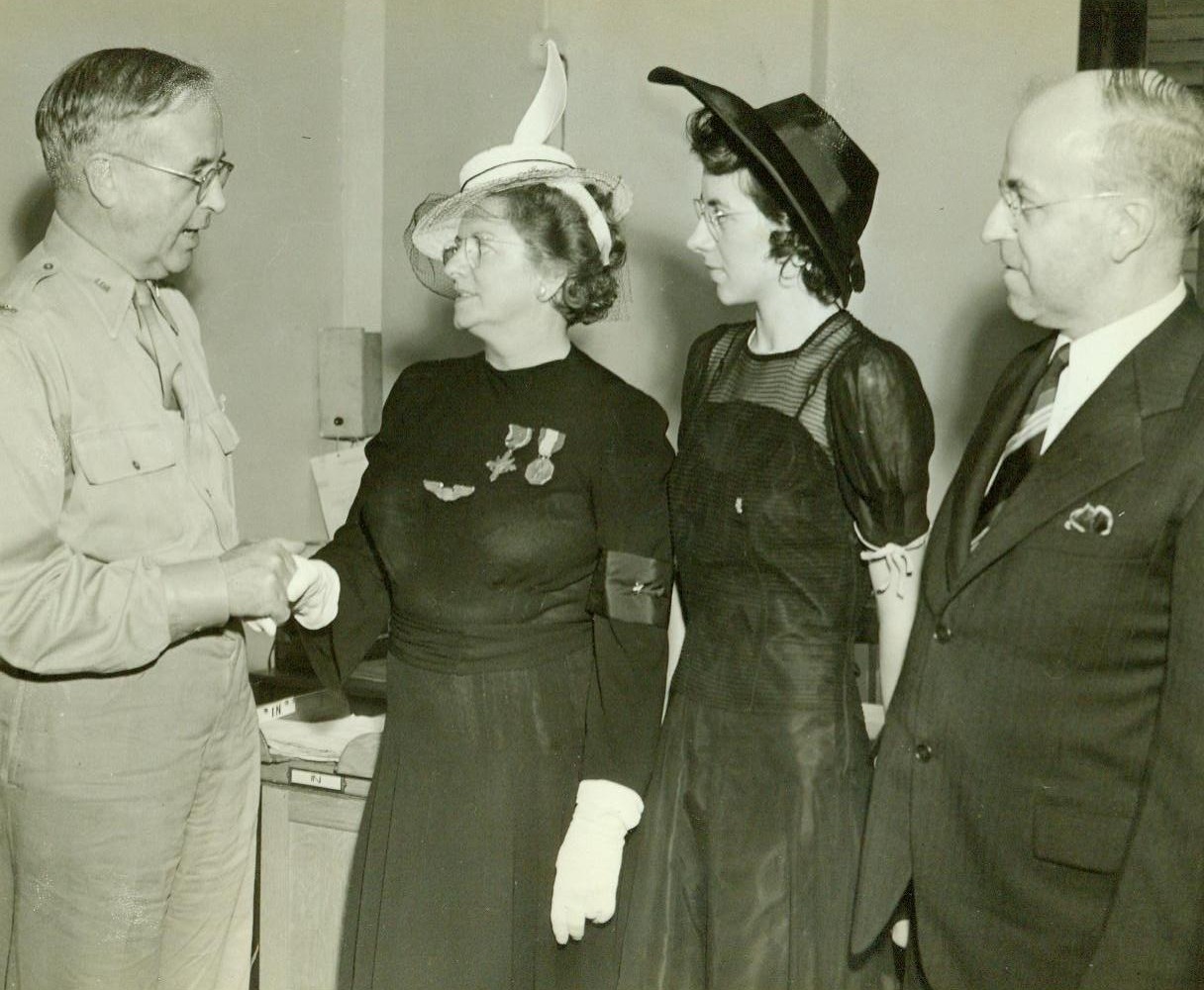
Recieves Son's Posthumous Awards, 8/13/1943. New York, N.Y.—Mrs. Mary C. Church, of 66 Deleware Avenue, Dumont, N.J., mother of the late 1st Lieut. Russel M. Church, Jr., 17th pursuit Squadron, U.S. Army Air Forces, received the Distinguished Service Cross and Soldier’s Medal, posthumously awarded to her son who was killed in action in the Philippines December 16, 1941. Here, in ceremonies in the office of Col. Thomas L. Crystal, post commander, Fort Jay, Governors Island, are, (Left to Right): Col. Crystal, who presented the medals; Mrs. Church; Miss Mary Church, the hero’s sister; and Russel M. Church, Sr., his Father. Mrs. Church wears her son’s wings and the two medals, (The D.S.C. on left and Soldiers medal, right). 8/13/42 (ACME);

Weird Lighting During Night Raid, 8/27/1943. England – This night picture, taken during a raid on a South coast town recently, shows the weird effect caused by flares when they are hit by anti-aircraft gun fire as disintegrated parts of a flare descend over roof tops. The flare on the right has just been hit. Passed by censors. Credit: ACME;
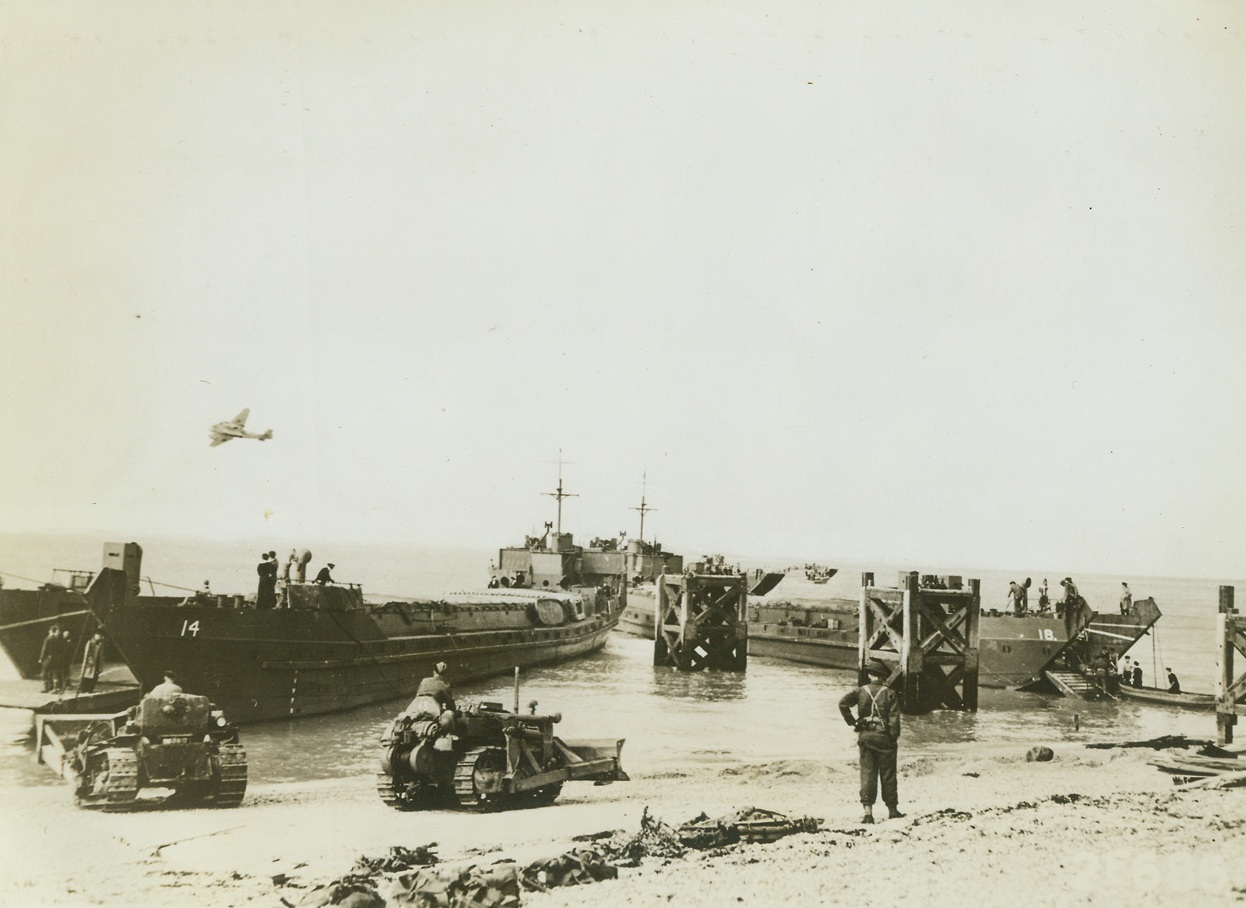
Tank Carriers Land After Dieppe Raid, 8/27/1943. England – Two of the United Nations tank landing craft, used for the first time during the huge Commando-Ranger raid on Dieppe, August 19, as they were beached “somewhere in Britain,” following the raid. Credit: U.S.A. Signal Corps Photo from ACME;
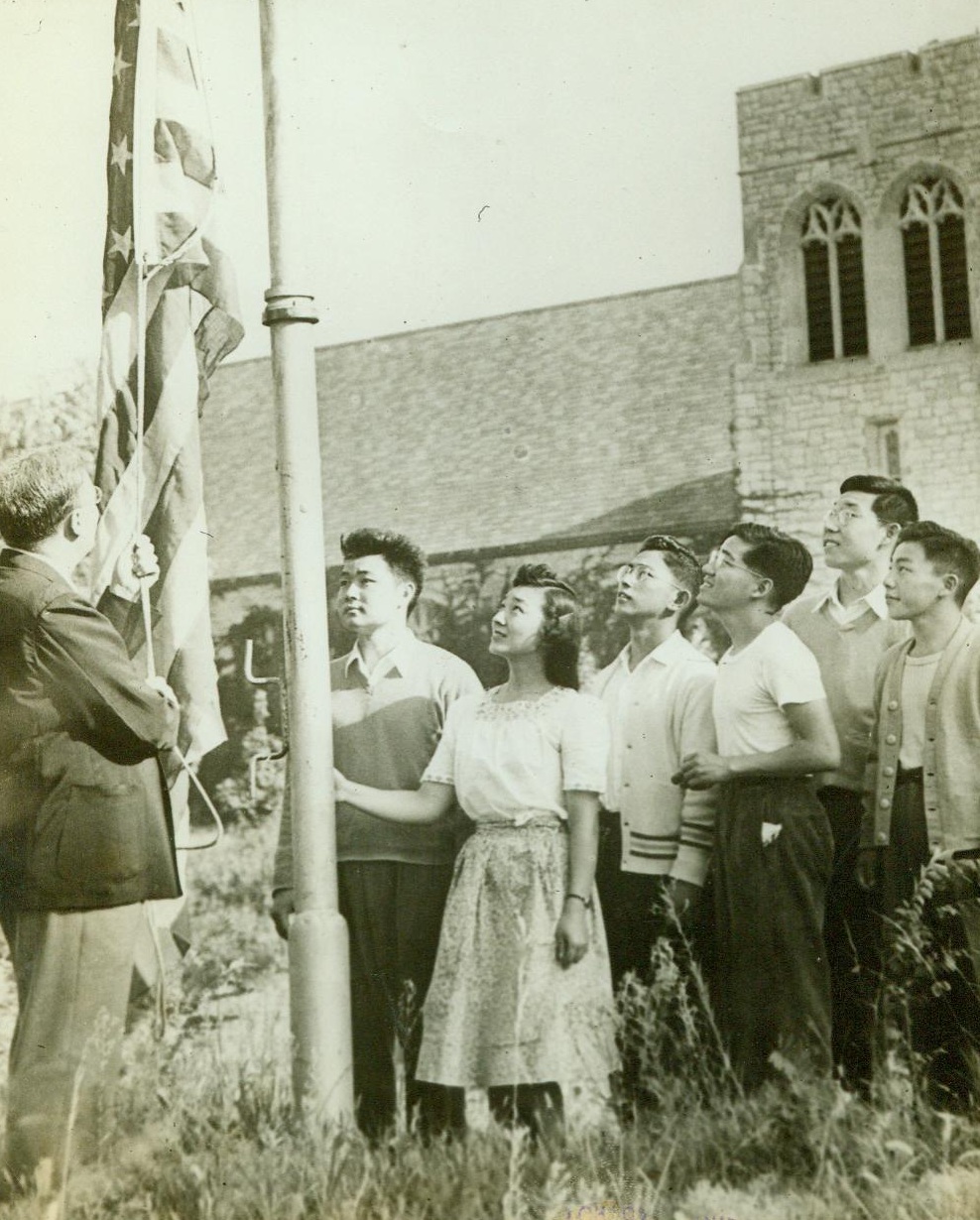
Japanese Students Under Fire, 8/29/1943. Parkville, MO. – American-born Japanese students at Park College, Parkville, Mo., take part in flag raising ceremony and calmly continue studies there despite protests of citizens of Platte County, Mo., who believe they should be interned. Left to Right; W.L. Young, College President; henry Masuda, Toki Kumai, Arthur Kamitsuka, William Yamamoto, Abraham Dohl, and Peter Mori. 8/29/42 (ACME;
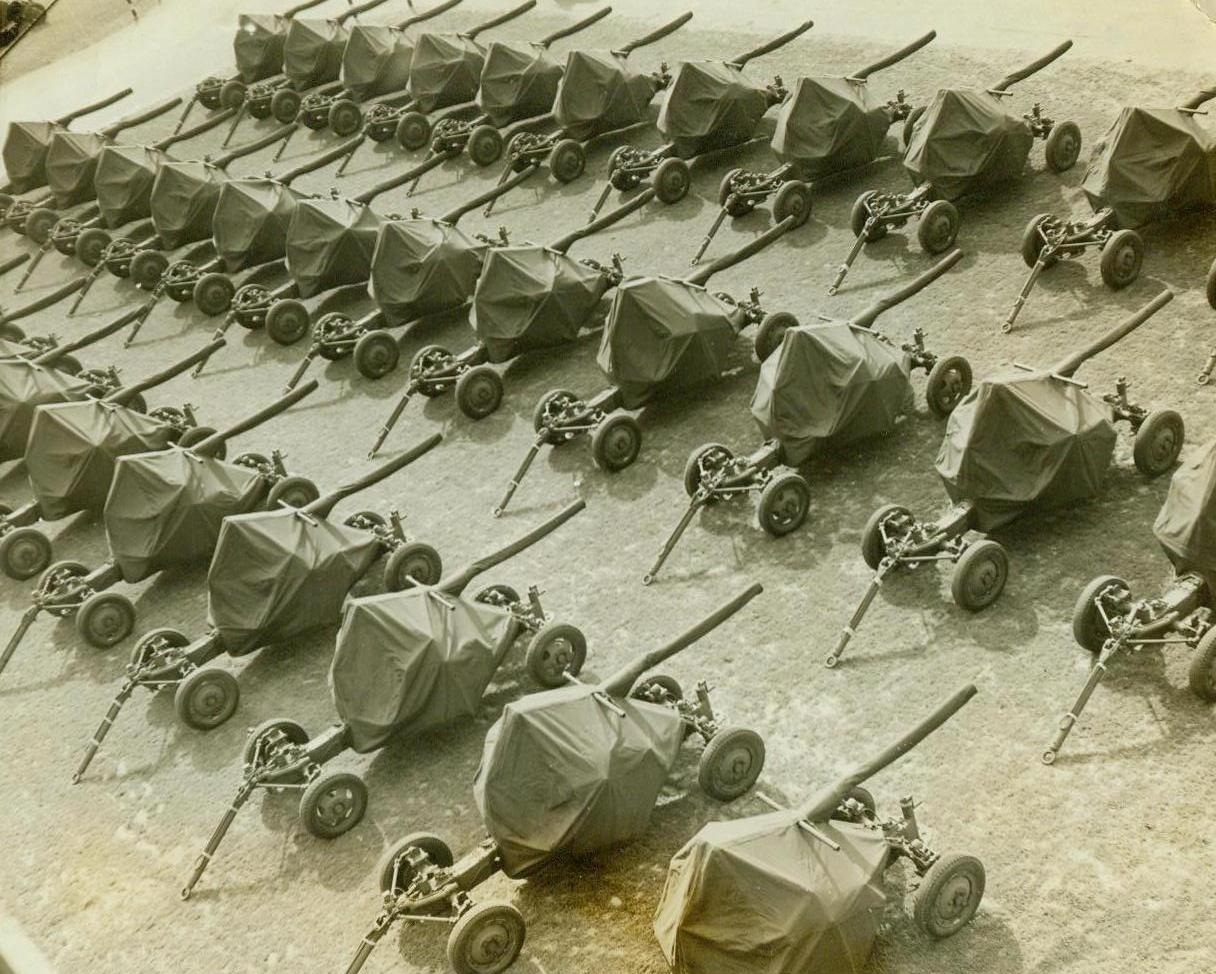
Big Bofors Anti-Aircraft Guns Ready To Smash Axis, 8/28/1942. Akron, Ohio -- Thirty and more a day of the big Bofors anti-aircraft guns roll off the assembly lines of Firestone Tire and Rubber Co., here as all-out production begins to really roll these guns in the direction of all fronts. Above photo shows a day's output lined up outside the plant. Guns were originally Swedish design. (ACME);
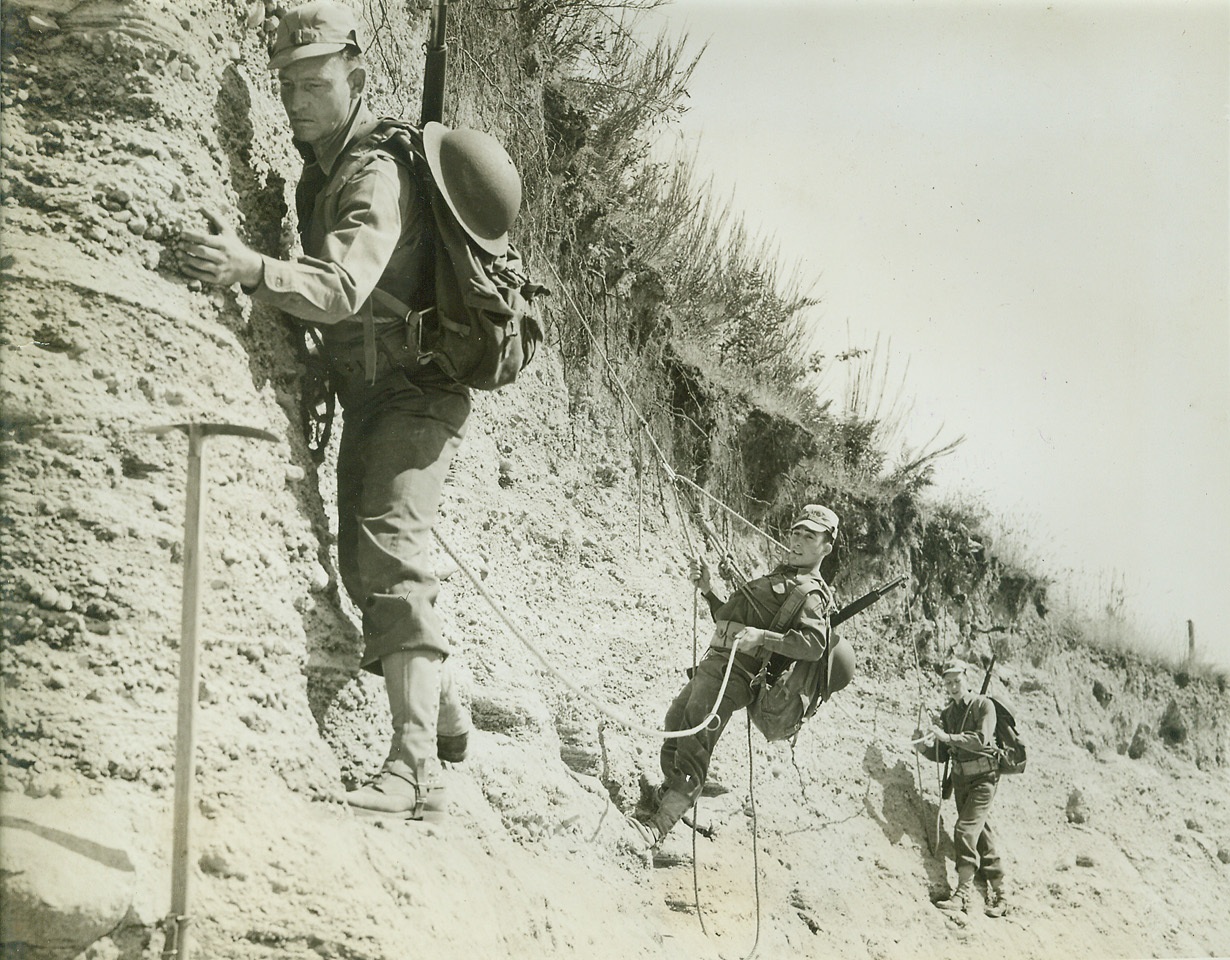
Ski Troops in Winter-Mountaineers in Summer, 8/16/1942. PACIFIC NORTHWEST – A new branch has been added to Uncle Sam’s Army – a full-fledged “Mountain Regiment”, with 1,400 men who are undergoing a rigid and specialized training program. Last winter these same men formed the first organized ski troop battalion in the U.S., but now that the ice and snow has given way to summer heat and dust they are being developed into a regiment intended as a nucleus for similar units of mountain infantry. The regiment’s commanding officer, Col. O.S. Rolph, inaugurated the ski patrol and today personally supervises every phase of the thorough training of the “Mountaineer Infantry”. These photos, taken at the Mountaineering Training Area, show some phases of the training. New York Bureau Mountaineers edge carefully along the face of a rock wall as they complete their basic training and prepare for the second phase and more rigorous training in a wild and mountainous area.;

Aviators' Anti-Axis Sentiment, 8/27/1942. Graphically portraying their feelings, the crew of a B-17 Flying Fortress painted this novel insignia on the flying monster’s fuselage. They will flatten Axis towns with their bombs in partial payment for the bombings of London and Canterbury 8/27/42 (ACME);
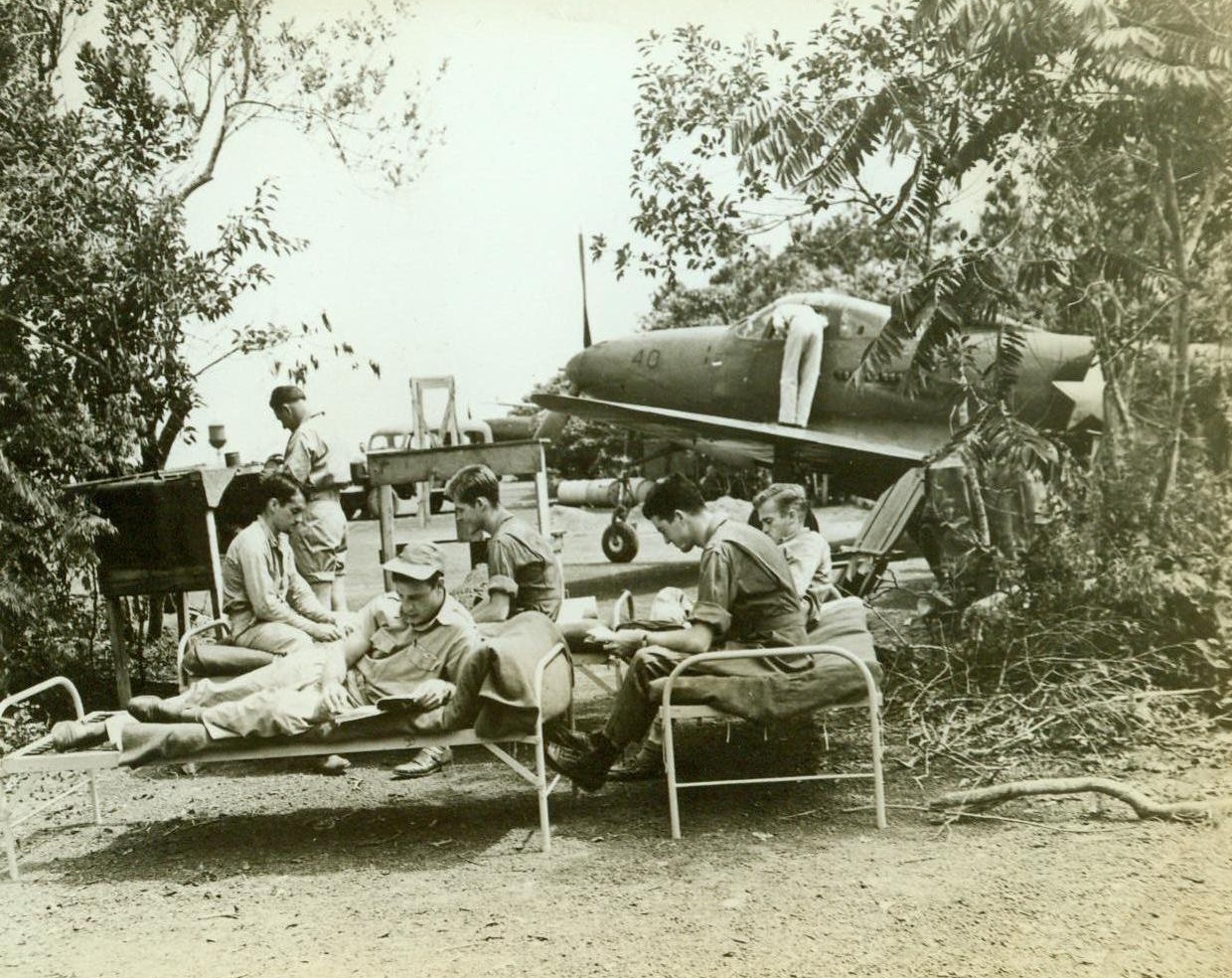
U.S. Fighter Plane Base In Caribbean Area, 8/13/1942. Hidden away in the Caribbean area these fighter pilots of Uncle Sam’s Air Forces are ever on the alert in their dense jungle bases. During a “stand-by alert” they remain beside their planes as the engines are warmed up by ground crews 8/13/42 (ACME);
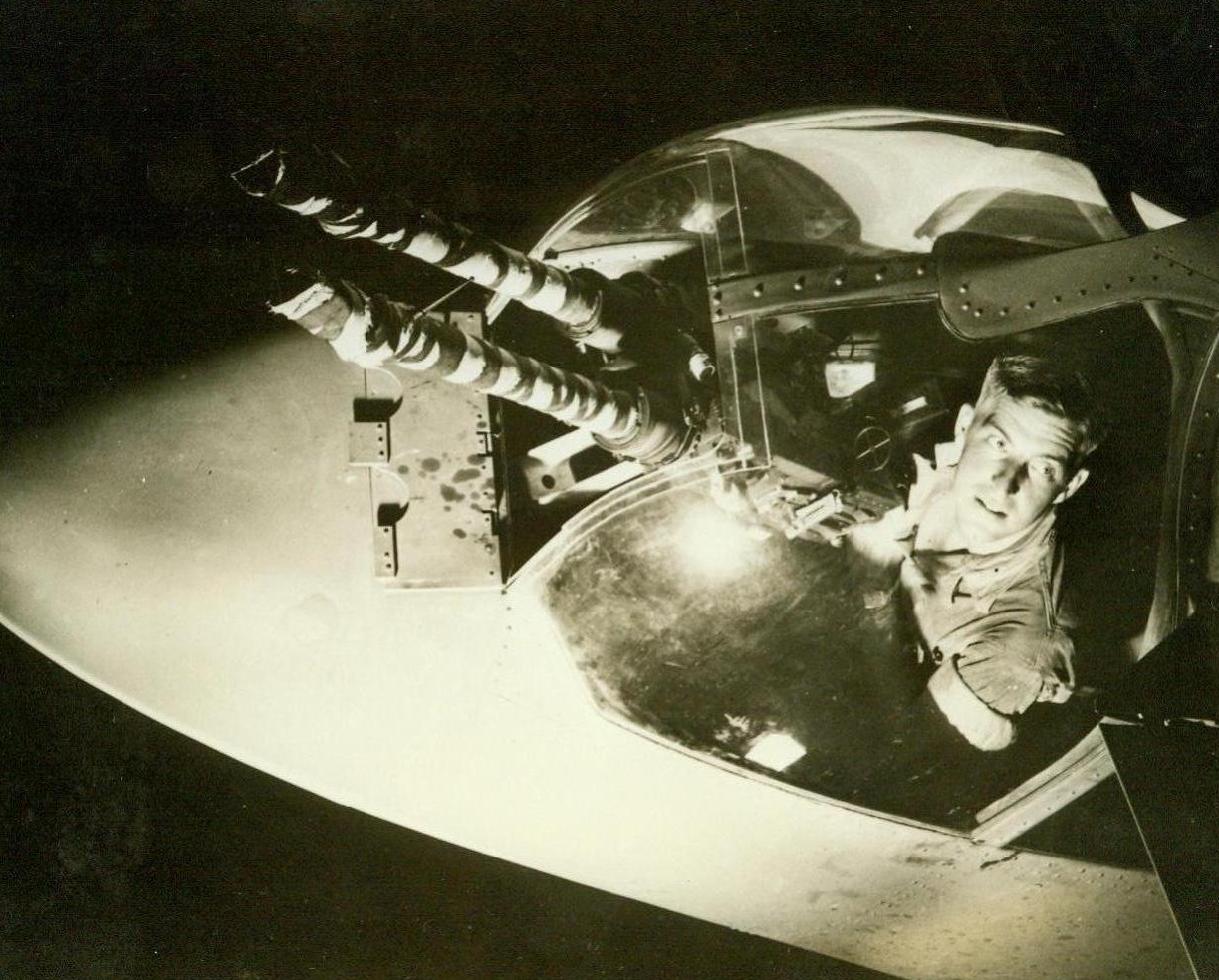
Itching Fingers, 8/14/1942. Macdill Field, Fla. – In wide-eyed alertness, the tail gunner of a B-26 scans the skies for the first sign of enemy opposition. He’s the man who holds the life of his flying teammates and the safety of his plane in his trigger fingers when the going gets toughest. His job calls for split-second timing in beating the foe to the punch. This gunner is an anonymous member of an operational training crew learning the finer points of his deadly art. The wrappings protect guns from weather. They come off when the plane goes into combat duty. 8/14/42 (U.S. Army Air Forces Photo From ACME);
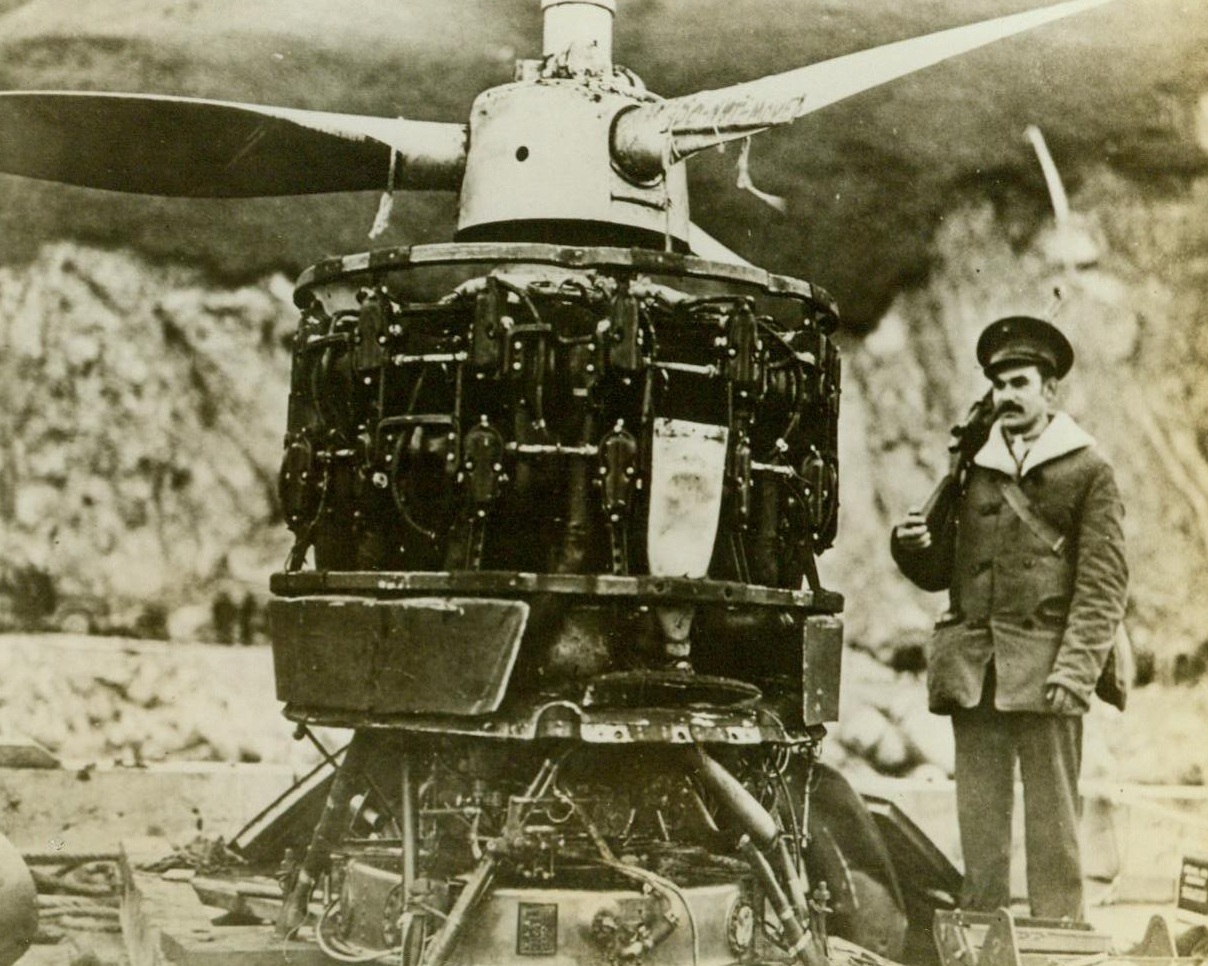
Motor Of Wrecked Jap Plane, 8/8/1942. Washington, D.C. – Proof of the power and maneuverability of Jap fighting plans is this huge motor taken from a carrier-based plane which crashed in a mountainous section near Dutch Harbor, Alaska, during a bombing attack. The motor, in comparatively undamaged condition, is guarded by a U.S. Marine sentry pending study by U.S. aeronautical experts 8/8/42 (Official U.S. Navy Photo- From ACME);
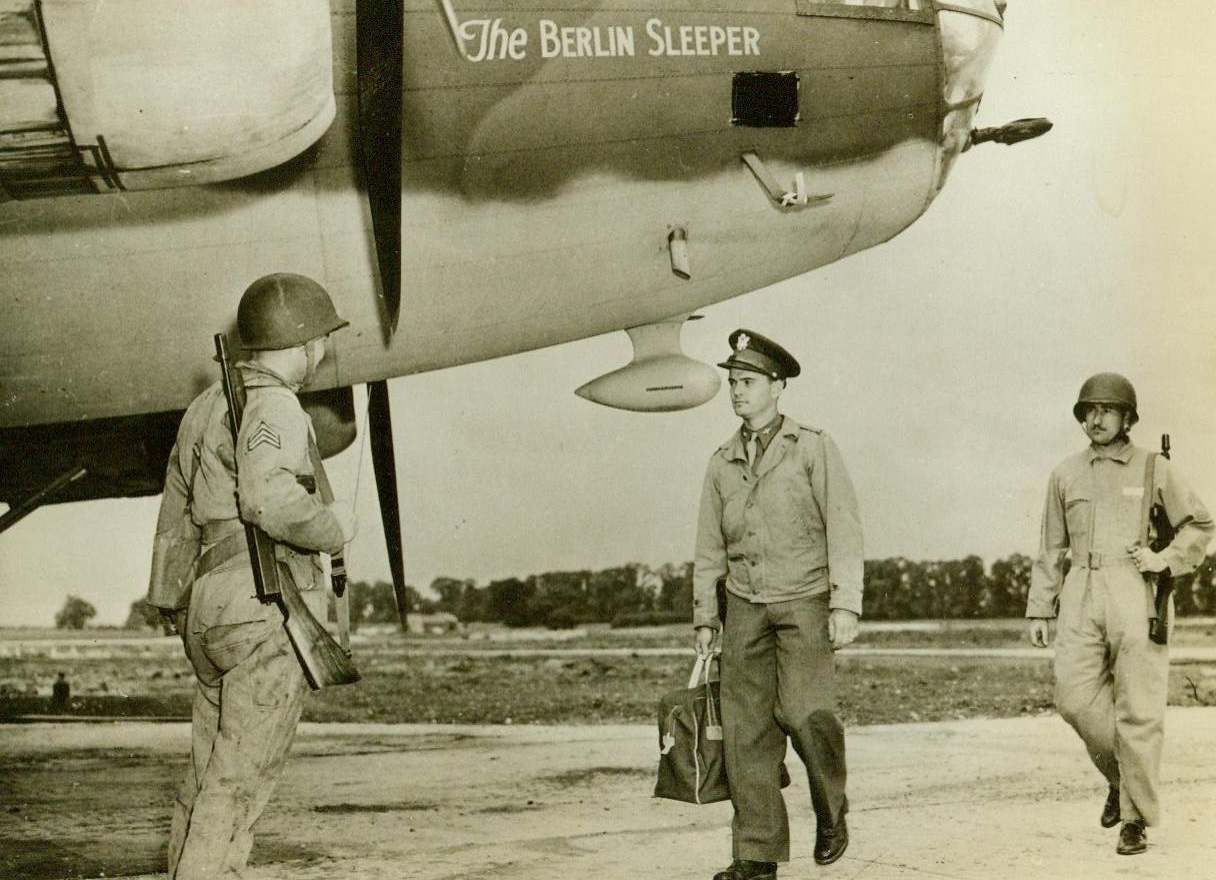
Ready To Deliver Sleeping Powder To Nazis, 8/5/1942. Somewhere in the British Isles – In many parts of the British Isles, U.S. Air Force flying fortresses are waiting for the “zero hour,” waiting to deliver “block-buster” bombs to Berlin – And anywhere else the Nazis may be gathered. Here, Lt. Edward B. Weathers, of Ocala, Fla., walks up to his bomber, which is appropriately named, “The Berlin Sleeper.” He is accompanied by soldiers carrying sub-machine guns, for he carries the valuable and secret American bombsight. 8/5/42 (ACME);
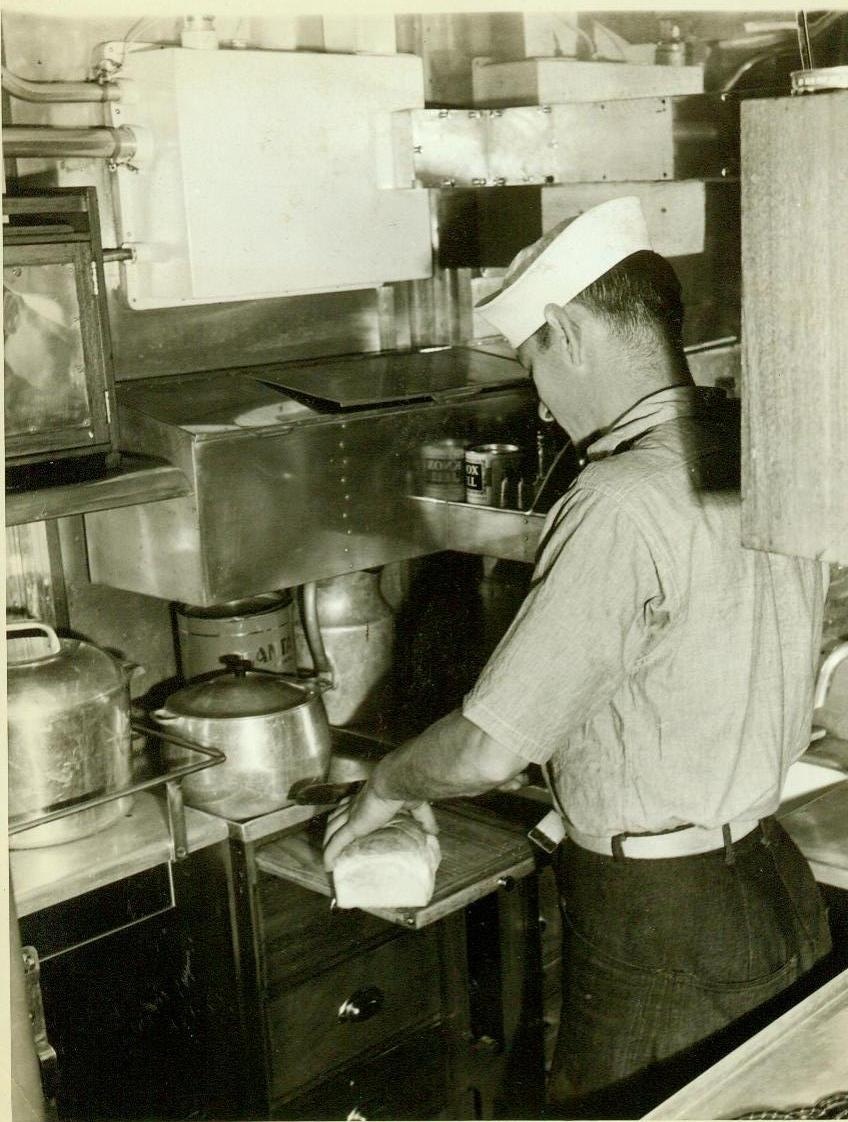
HAWAII’S GOT STINGERS NOW, 8/1/1942. HONOLULU – A palm-fringed, tropical lagoon is headquarters for a nest of sea-going hornets whose stings are deadly to any lurking Jap submarine or surface vessel off Oahu’s shores. It’s the home of the sturdy, speedy little PT fleet – the Navy’s torpedo boats that have recently joined land, sea and air offensives in Hawaii. In a former yacht clubhouse set beneath cocoa palms and huge Kamani trees, the officers and men of the fleet relax while their craft undergo check-ups and repairs, awaiting the time when they will put out to sea—for a day’s or month’s cruise—to “put the fish into an Axis ship”. Here are typical scenes at the secret base. NEW YORK BUREAU Size must be sacrificed to speed on the little PT boats, which pack a powerful sting in spite of that fact. The galley is a bit cramped, but this crew member has elbow room enough to slice bread. (Passed censors). Credit: ACME;
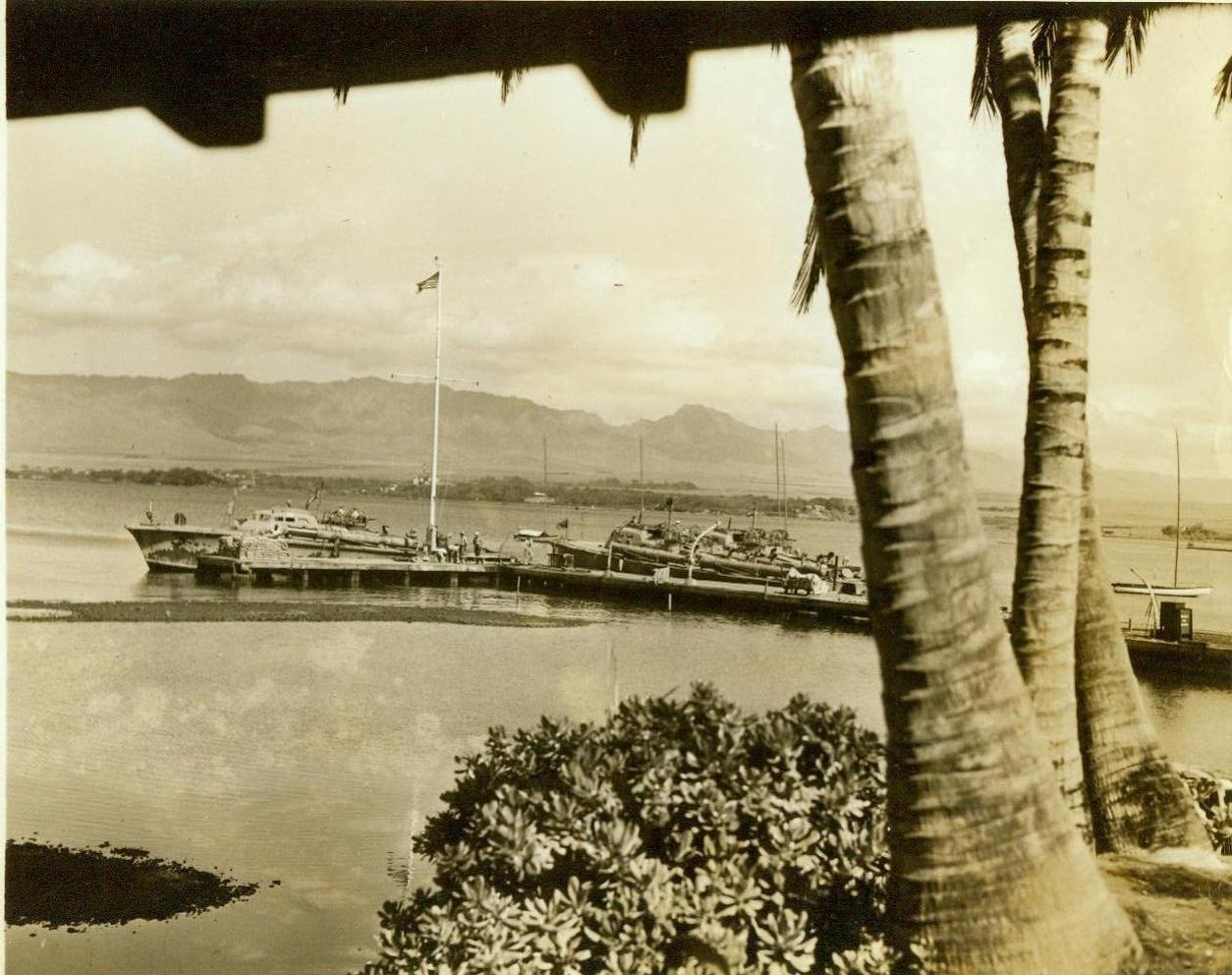
HAWAII’S GOT STINGERS NOW, 8/1/1943. HONOLULU – A palm-fringed, tropical lagoon is headquarters for a nest of sea-going hornets whose stings are deadly to any lurking Jap submarine or surface vessel off Oahu’s shores. It’s the home of the sturdy, speedy little PT fleet – the Navy’s torpedo boats that have recently joined land, sea and air offensives in Hawaii. In a former yacht clubhouse set beneath cocoa palms and huge Kamani trees, the officers and men of the fleet relax while their craft undergo check-ups and repairs, awaiting the time when they will put out to sea—for a day’s or month’s cruise—to “put the fish into an Axis ship”. Here are typical scenes at the secret base. New York Bureau These “sub-dusters” are tied up to their docks, awaiting repairs in the calm waters of the lagoon at the secret torpedo boat base. (Passed censors). Credit: ACME;
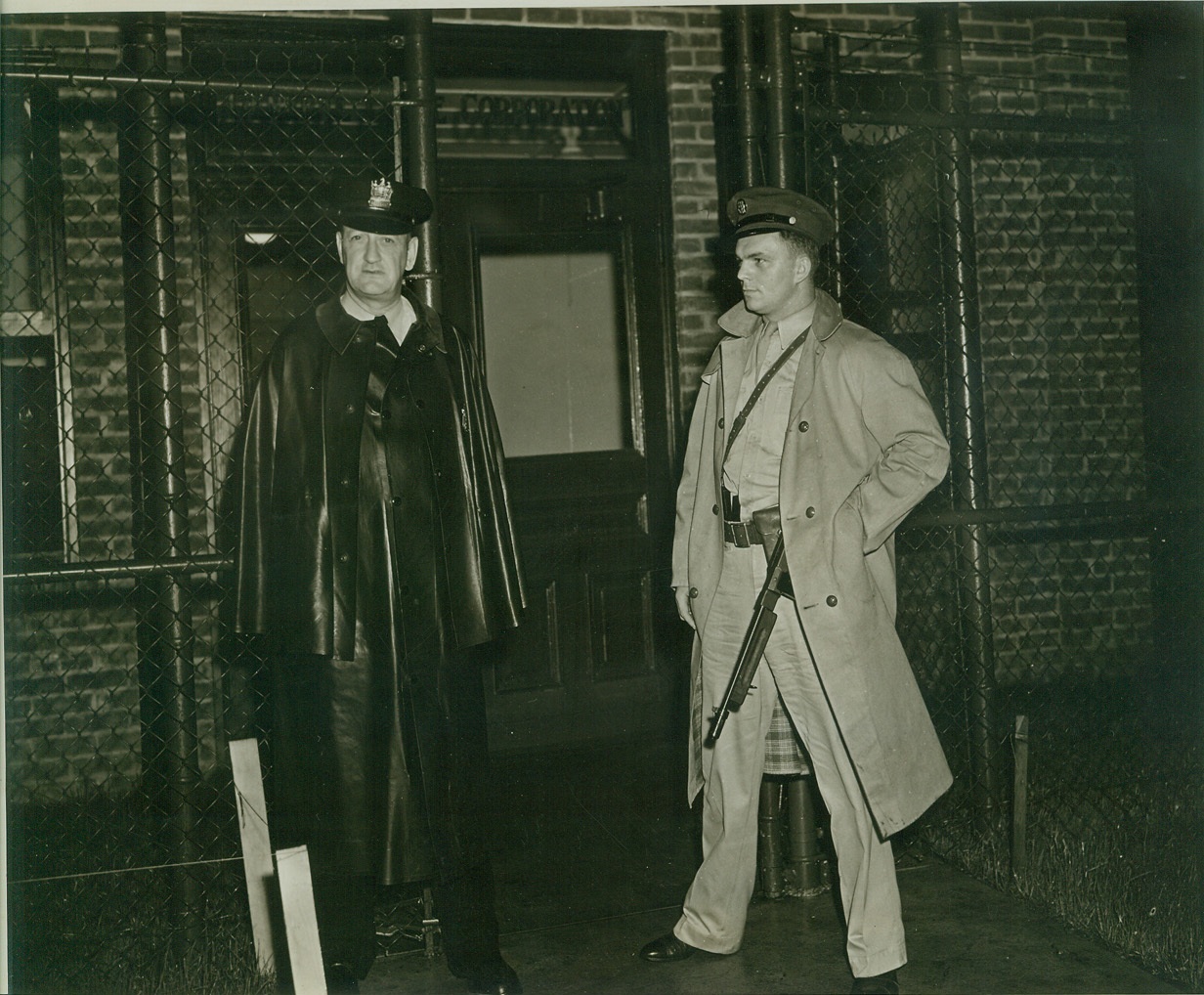
War Plant Closed by President, 8/13/1942. Bayonne, N.J.—Sgt. Charles Robinson, (left), of the Bayonne Police, and Pvt. John Glowacki, at the entrance to the General Cable Co. Plant on West First Street in Bayonne. Pvt. Glowacki accompanied Army officials, who visited the plant after President Roosevelt’s order that the Navy take over the plant had been announced. The factory manufactures cables for the Armed Forces. Credit: ACME.;
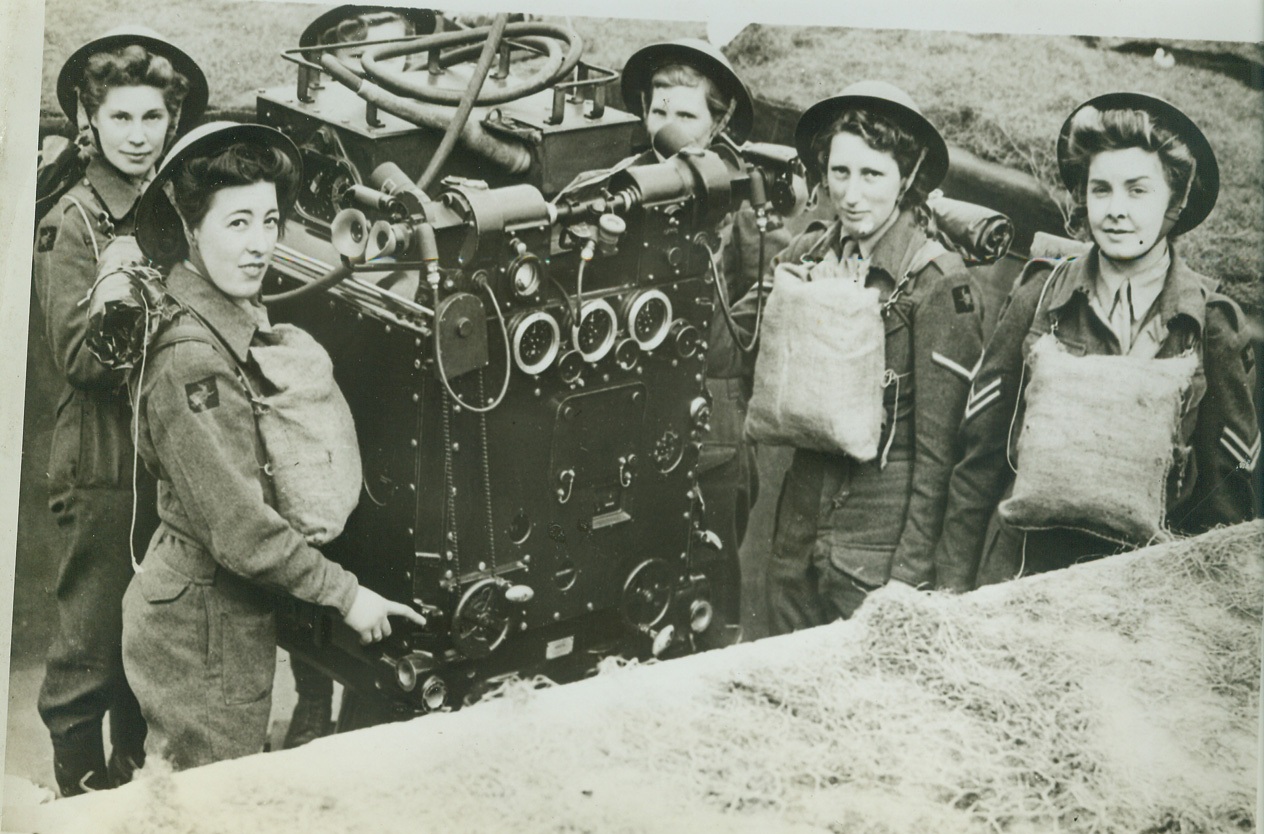
Their Aim is Good, 8/14/1942. England – This is the predictor team of a mixed anti-aircraft battery on the east coast of England which destroyed three enemy raiders within 48 hours. Credit: (ACME);

Ski Troops in Winter-Mountaineers in Summer, 8/16/1942. PACIFIC NORTHWEST – A new branch has been added to Uncle Sam’s Army – a full-fledged “Mountain Regiment”, with 1,400 men who are undergoing a rigid and specialized training program. Last winter these same men formed the first organized ski troop battalion in the U.S., but now that the ice and snow has given way to summer heat and dust they are being developed into a regiment intended as a nucleus for similar units of mountain infantry. The regiment’s commanding officer, Col. O.S. Rolph, inaugurated the ski patrol and today personally supervises every phase of the thorough training of the “Mountaineer Infantry”. These photos, taken at the Mountaineering Training Area, show some phases of the training. New York Bureau Carrying slung Garand rifles and a full pack, the men ascend the wooden ramp in teams of three tied together with safety ropes. Notches cut in the logs offer toe and finger holds. Credit: (ACME);
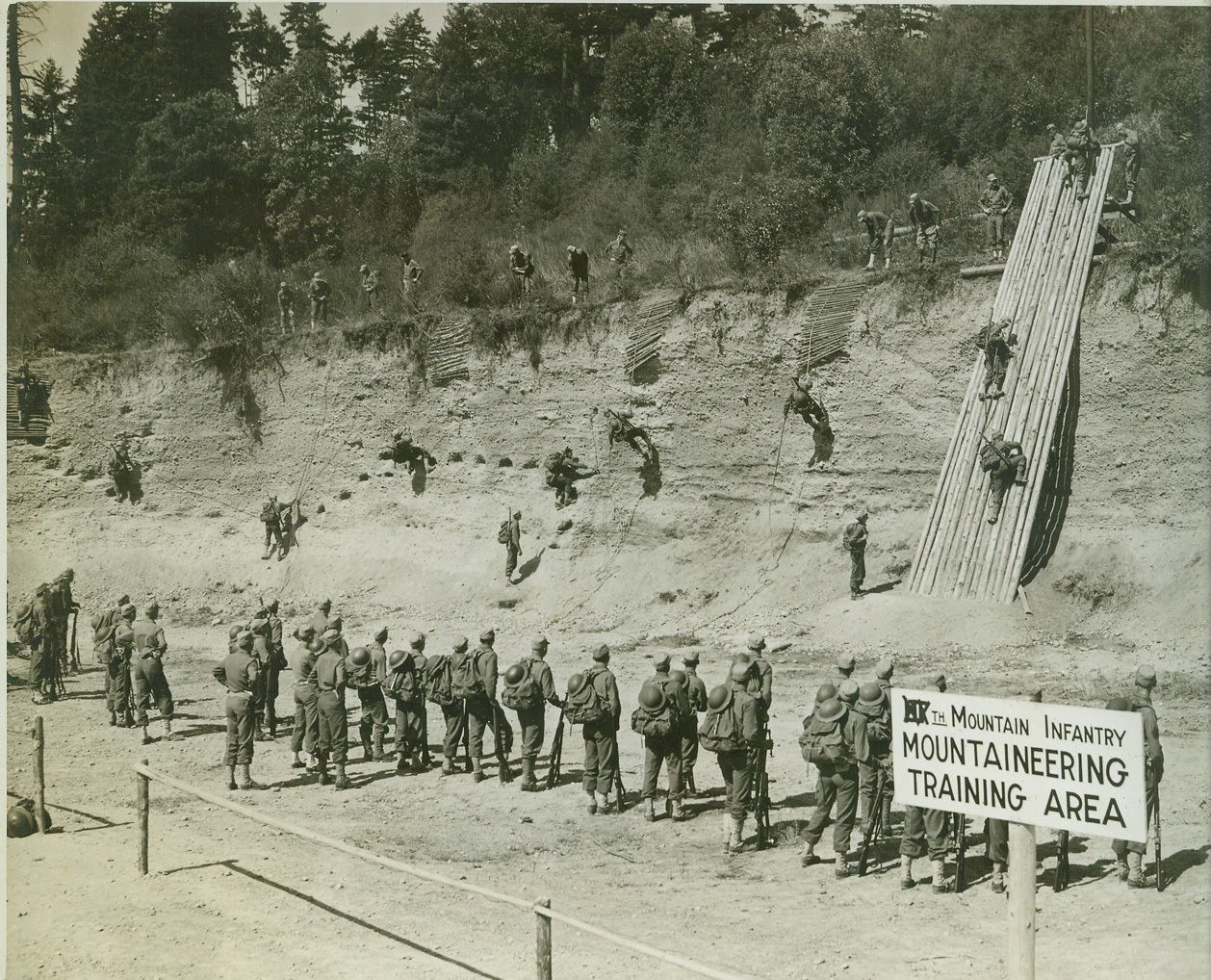
SKI TROOPS IN WINTER – MOUNTAINEERS IN SUMMER, 8/16/1942. PACIFIC NORTHWEST – A new branch has been added to Uncle Sam’s Army – A full-fledged “Mountain Regiment”, with 1,400 men who are undergoing a rigid and specialized training program. Last winter these same men formed the first organized ski troop battalion in the U.S., but now that the ice and snow has given way to summer heat and dust they are being developed into a regiment intended as a nucleus for similar units of mountain infantry. The regiment’s Commanding Officer, Col. O. S. Rolph, inaugurated the ski patrol and today personally supervises every phase of the thorough training of the “Mountaineer Infantry”. These photos, taken at the Mountaineering Training Area, show some phases of the training. At the Mountaineering Training Area the men scale the steep sides of a gravel pit and almost vertical wooden climbing ramps, 40 feet high and nicked at widely-spaced intervals with an axe to give toe and finger holds. Credit: OWI Radiophoto from ACME;

BOMBING OF AN ITALIAN SUBMARINE, 8/26/1942. MEDITERRANEAN—As the upheaval from a stick of bombs dropped by a Sunderland plane subsides, the object of the attack—an Italian submarine caught on the surface of the Western Mediterranean—can just barely be seen. The pilot of the Sunderland sighted the sub while on Coastal patrol in the Western Mediterranean, and reported that his bombs severely damaged the outer casing of the undersea craft. Credit: Acme.;
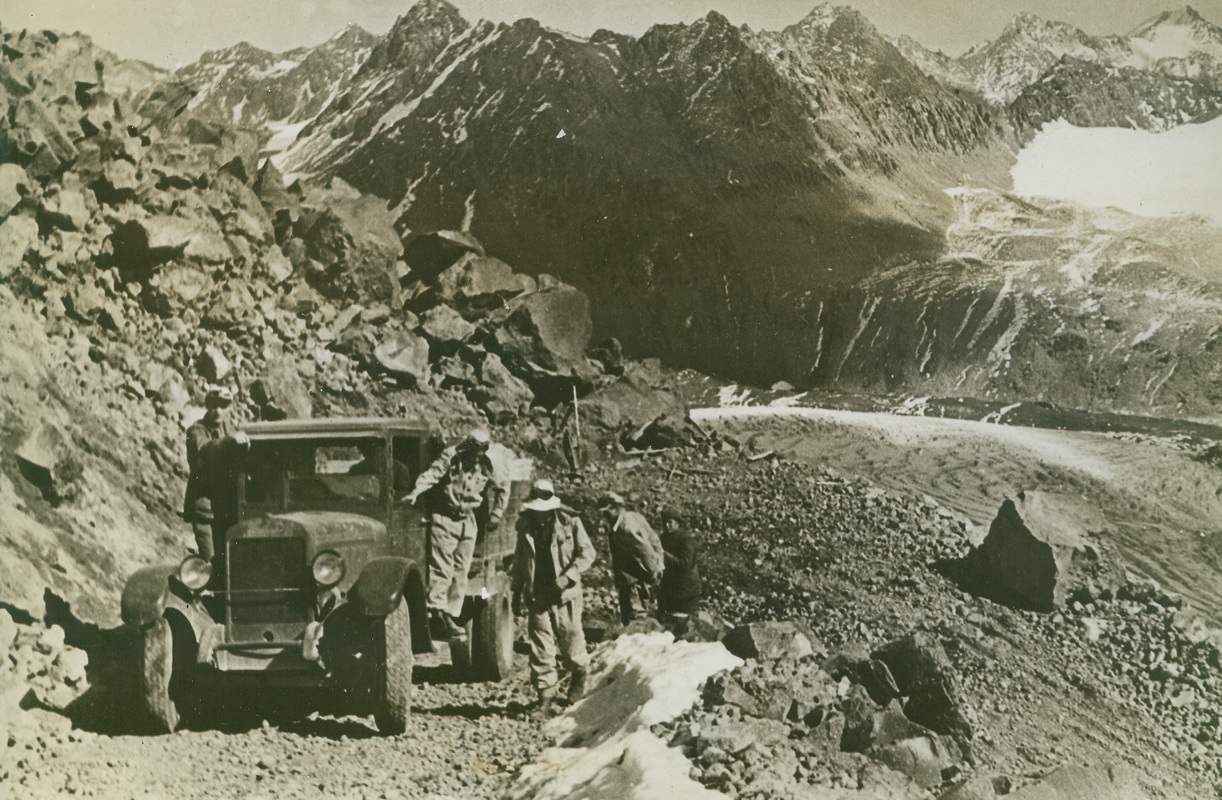
NAZIS CLAIM CAPTURE OF MT. ELBERUS, 8/26/1942. The German High Command as reported that mountain troops had forced several passes in the Western Caucasus area of Russia and that the swastika was hoisted over Mount Elberus, highest peak in the Caucasus Mountains. Above photo shows a view of the Caucasus showing Mt. Elberus in background. Credit: Acme;

THEY LEARN ART OF DESERT WARFARE, 8/27/1942. WITH U. S. ARMY IN CALIFORNIA DESERT – Wearing goggles and air filters, these U. S. tank crewmen learn the art of desert warfare as mechanized and motorized forces of the U. S. Army begin battle maneuvers somewhere in the California desert. War time touch is the name of the tank – “Grim Reaper.” Credit: ACME;
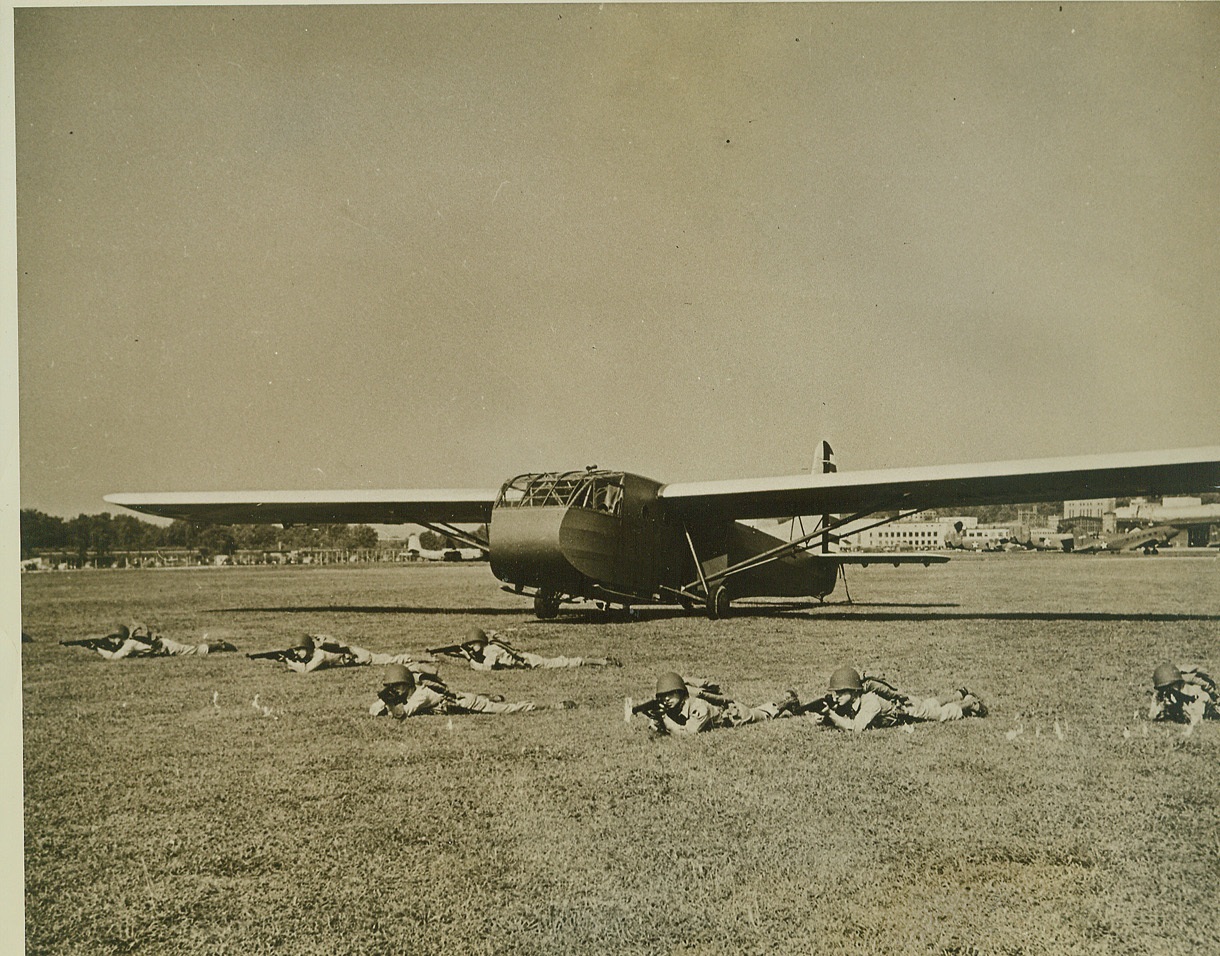
New Troop-Carrying Glider in Production, 8/27/1942. Air-borne infantry have landed in this new U.S. Army Air Forces CG-4A 15-place glider and are ready for action. This practice maneuver may soon be repeated many times over "for real", for gliders of this type will soon be our first line of offense in invasion against the Axis. The craft are now in quantity production by Boeing, Beech, and Cessna at Wichita, Kansas, and skilled pilots are being turned out for them by the Army Air Forces. In spite of their size, these gliders weigh only about 3,000 pounds, and two or more of them can land in almost any small field or pasture. Credit: (ACME);
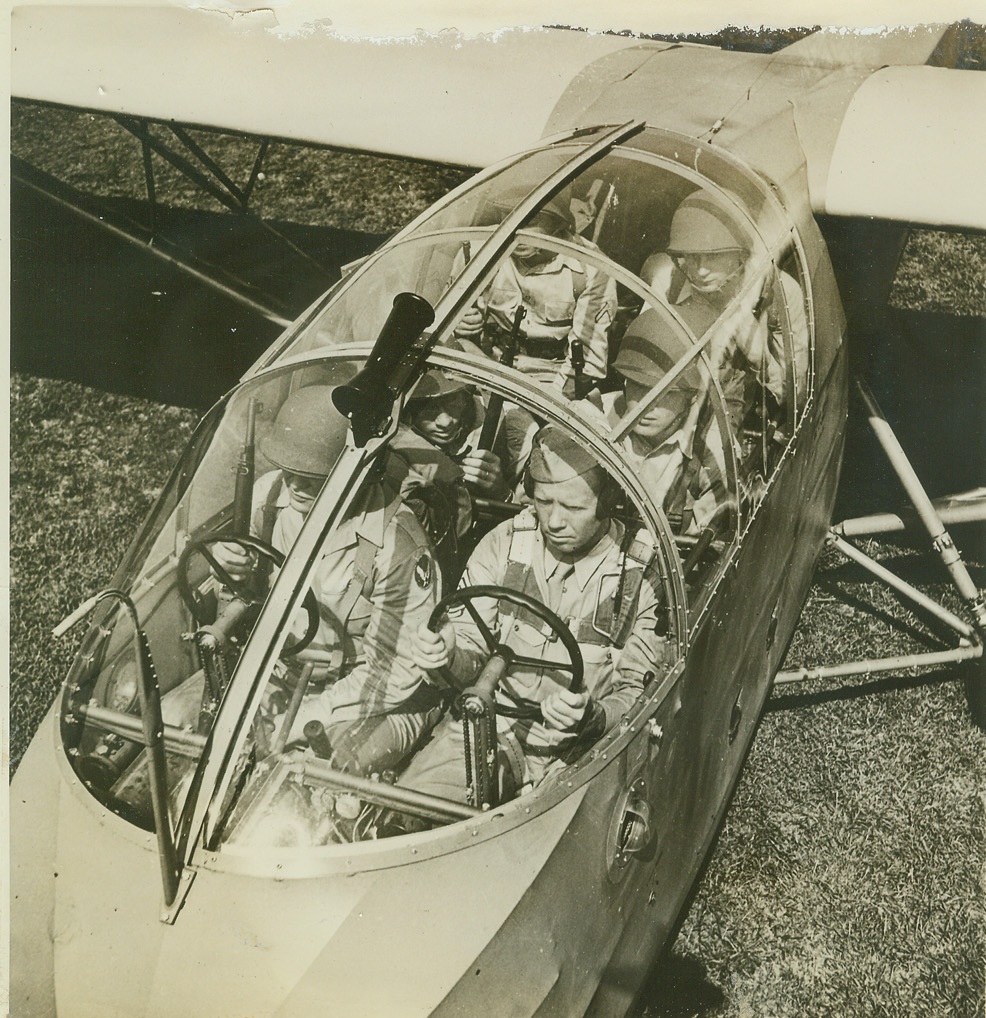
New Army Air Forces Training Glider, 8/27/1942. New Army Air Forces Training Glider This new 9-Place CG-3A Glider is being used to train pilots and crews for the larger 15-place gliders, by the U.S. Army Air Forces. The large craft, the CG-4A, will soon be our first line of offense in invasion of Axis-held territory, and are now in quantity production. Credit: ACME;
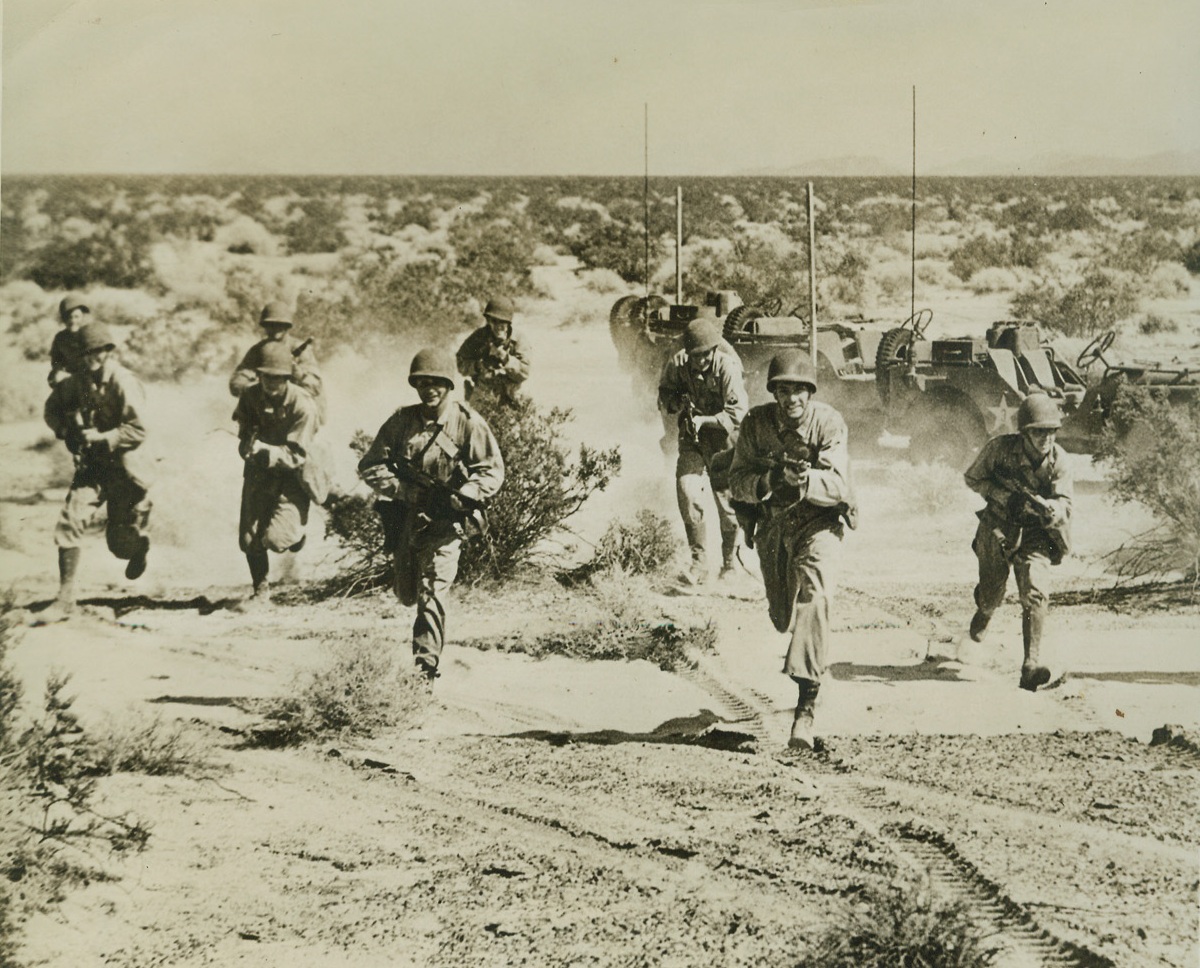
Infantrymen of the Desert, 8/27/1942. With U.S. Army in California Desert—From their armored cars, these hard-bitten U.S. soldiers leap forth to battle as the U.S. Army began battle maneuvers somewhere in the California desert. Credit: ACME.;

BOFORS ANTI-AIRCRAFT GUNS ROLL OFF PRODUCTION LINES, 8/28/1942. AKRON, OHIO—Skilled workmen turn out more than 30 huge Bofors Anti-aircraft guns at Firestone Tire and Rubber Co. plant here. Above photo shows part of the assembly line of these guns which were originally of Swedish design. They have an effective range of 6000 feet. Credit: OWI Radiophoto from ACME;
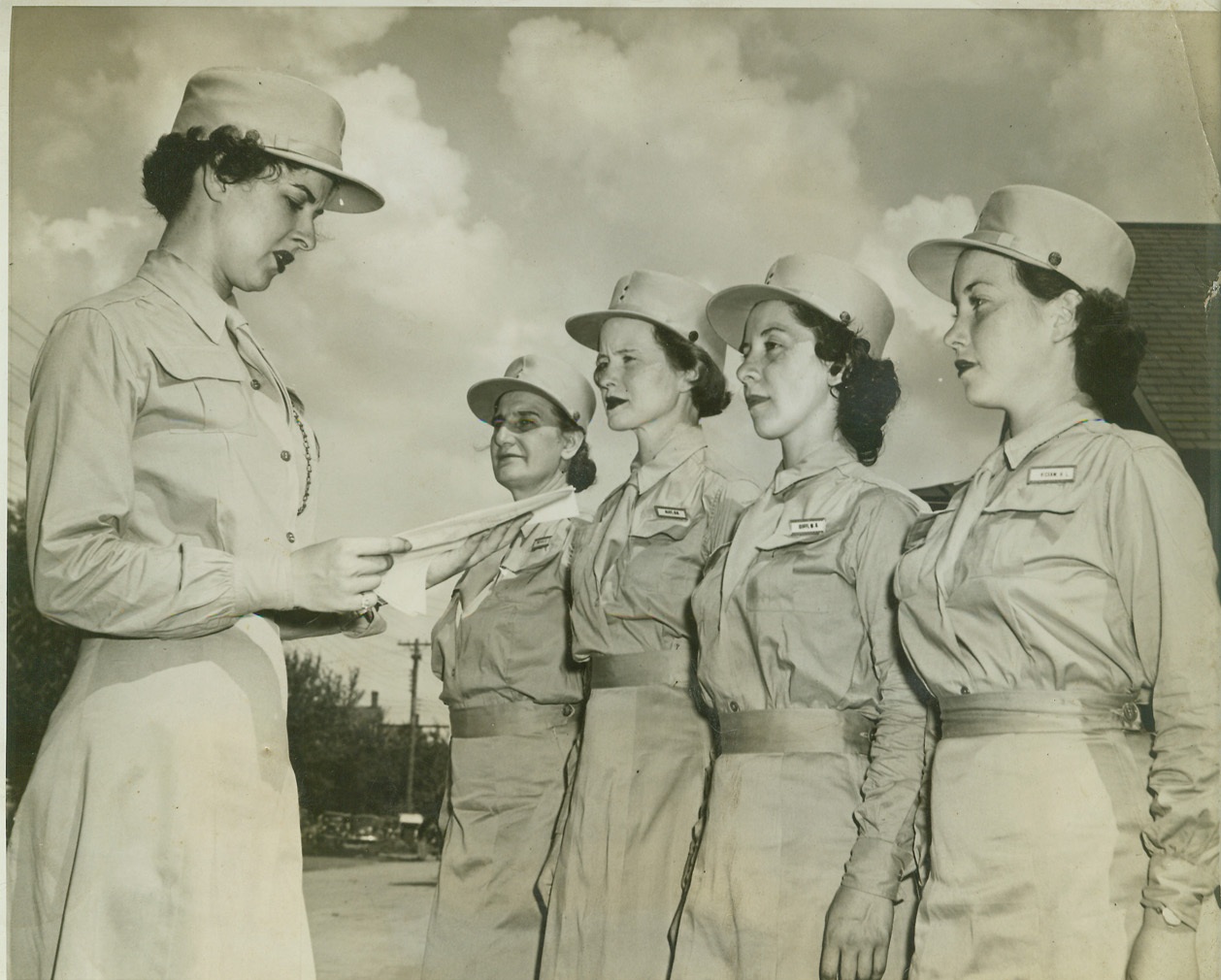
WAAC HAS SERGEANTS TOO, 8/30/1942. FT. DES MOINES, IA. —Sgt. Wilma Stanton, Los Angeles, CA., first WAAC auxiliary (private) to be promoted to grade of Sergeant reads orders to members of her squad. Left to right: Helen Delvoski, Philadelphia, PA, Opal Aliff, Huntington, W. VA, Winifred Cioffi, Rutand, VT., Helen Hickman, Atlanta, GA. Credit: OWI Radiophoto from ACME;
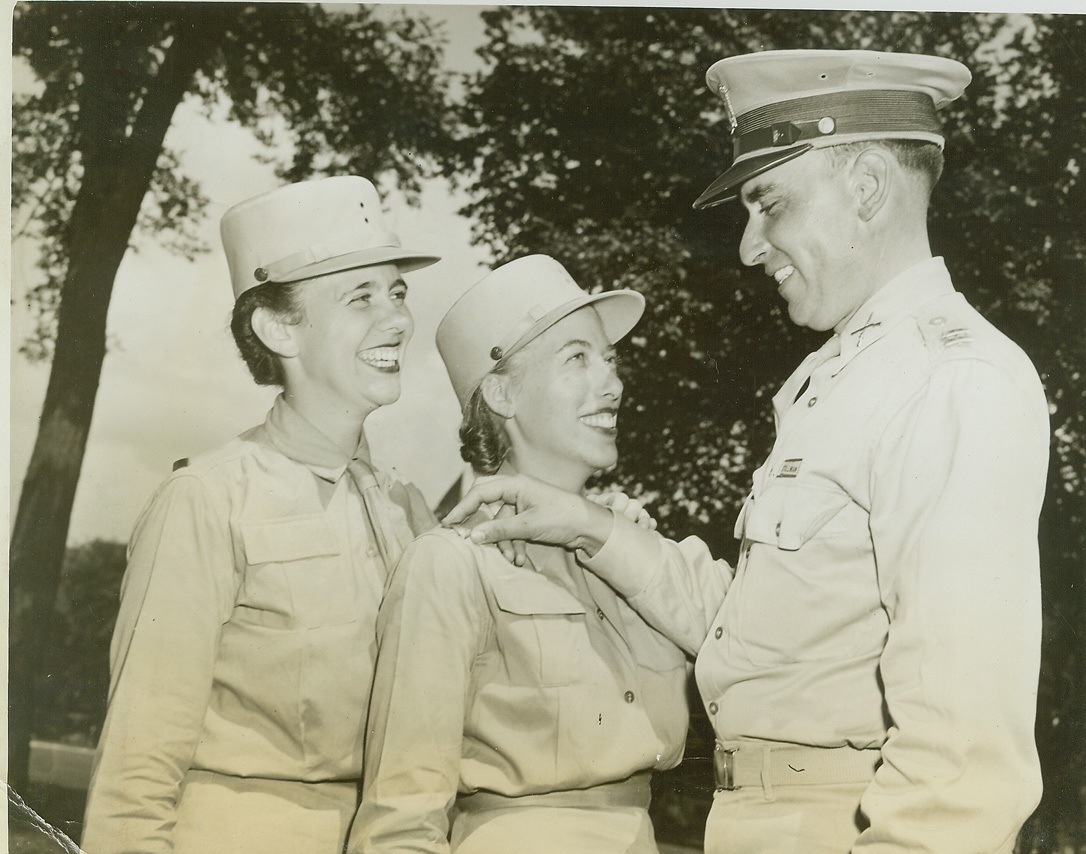
Pinning on the Bars, 8/30/1942. FT. DES MOINES, IA. – Capt. Frank E. Stillman, Jr., pining gold Third Officer’s (2nd Lieut) bars on WAAC officers Janet Jenkins (left) and Jean Korn at Ft. Des Moines, Ia. the women were members of first class to graduate from WAAC officer candidate school at Ft. Des Moines. Both women come from Philadelphia, Pa. Credit: (ACME);
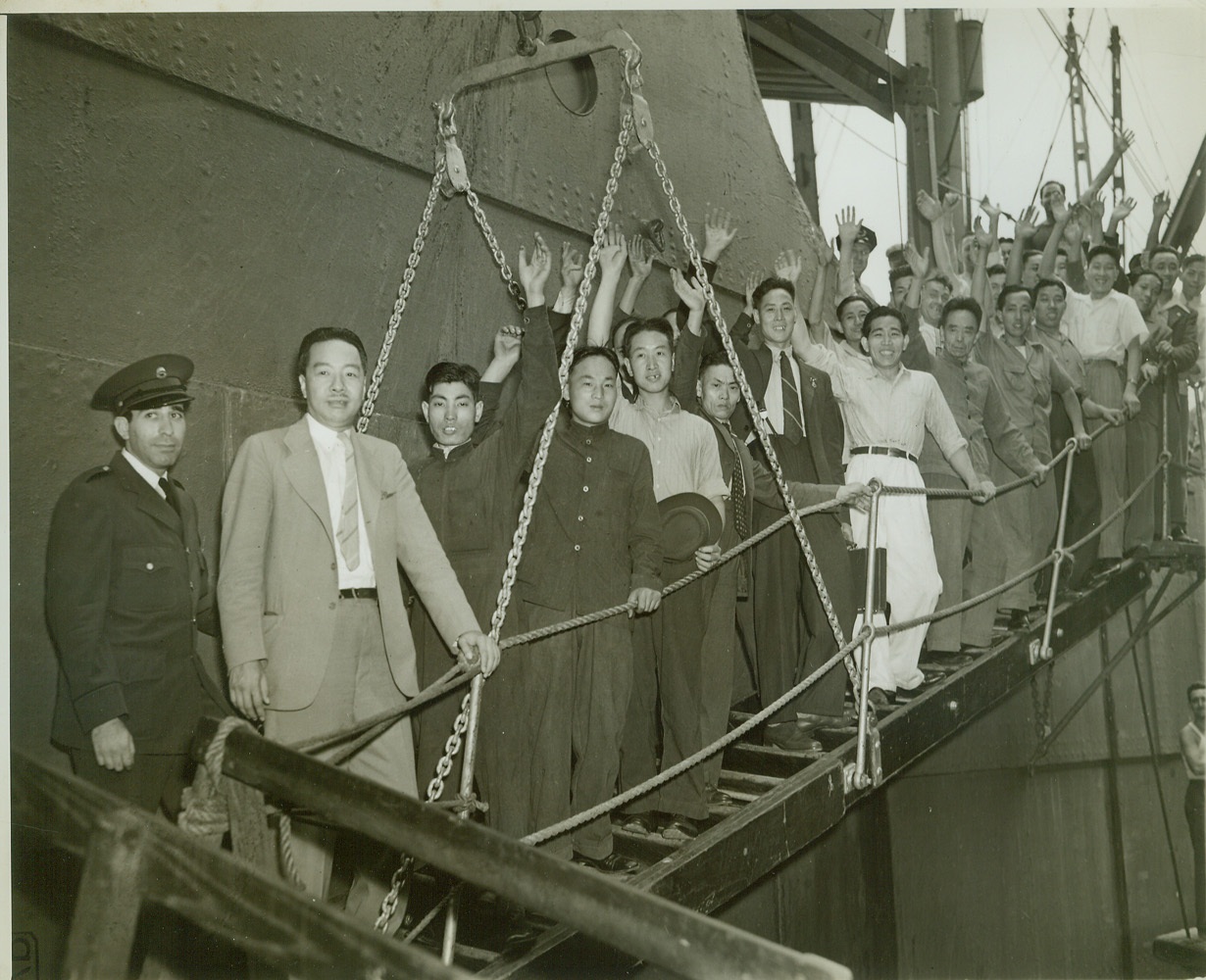
SHORE LEAVE, 8/4/1942. Tsune Chi-Yu, Chinese Consul General at New York, leads a group of Chinese seamen ashore at an east coast port after notifying them, on their arrival, of a new agreement with U.S. Immigration Authorities permitting China’s sailors for the first time to come ashore when docking in U.S. ports. Credit: ACME;
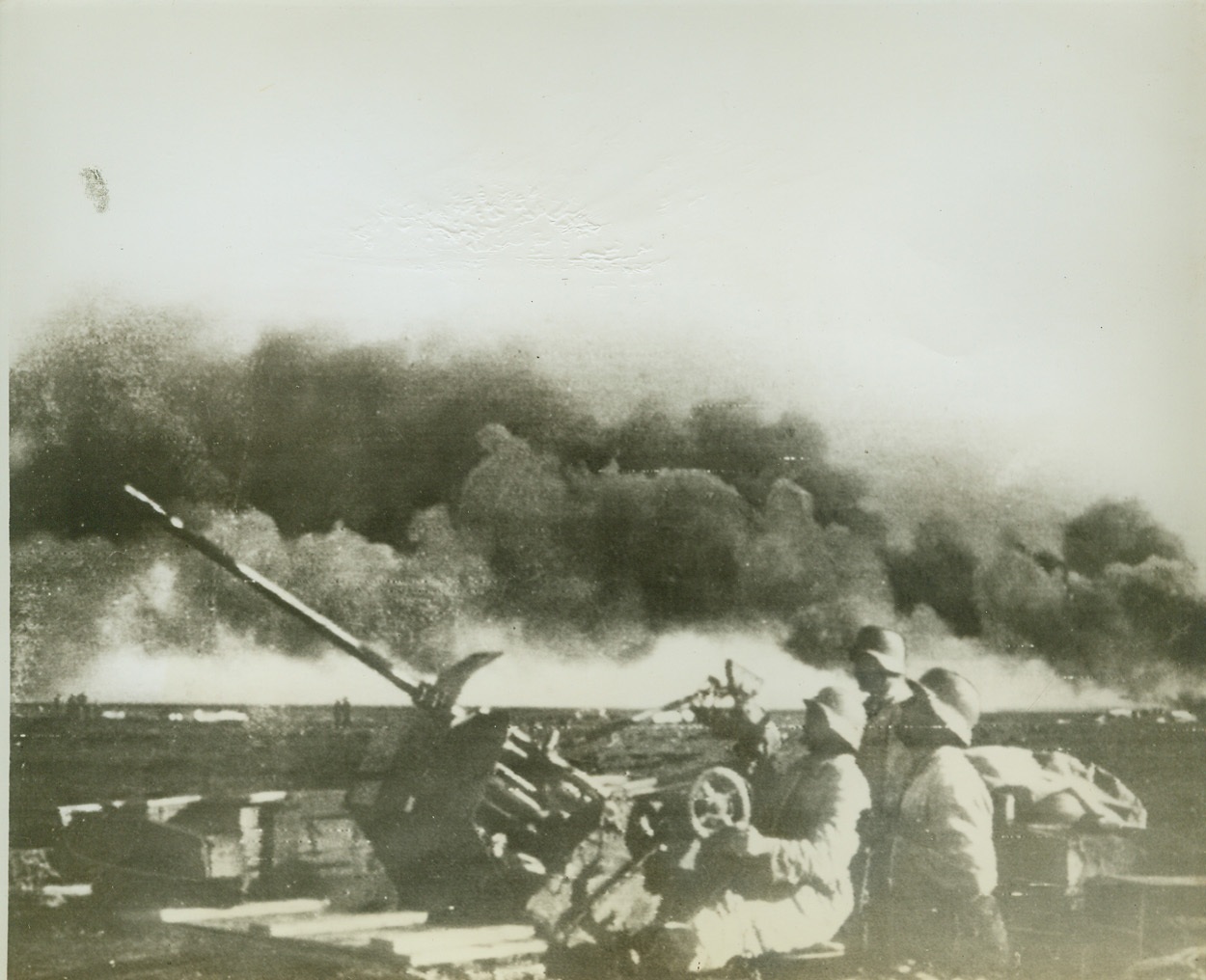
KAMPF IN AFRIKA, 8/4/1942. A Nazi anti-aircraft crew at a German air field in the Western Desert scans the sky worriedly for Allied bombers as thick black smoke from blasted Nazi planes stains the sky. Snapshot was made by a German soldier. Next day he was captured along with his camera and rolls of films. Picture was flashed to New York from Cairo today by radio. (Passed by British censor.) Credit: ACME Radiophoto;
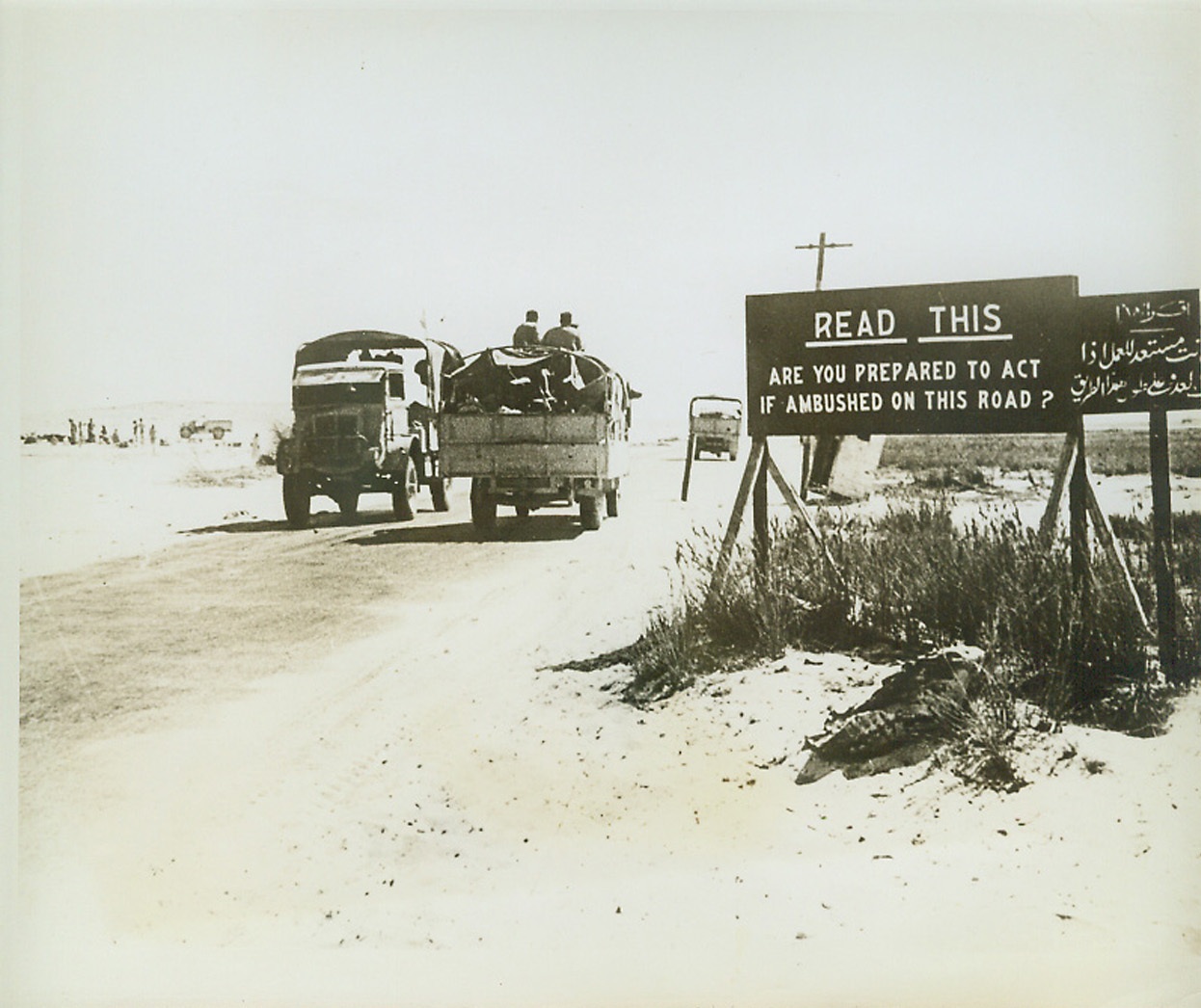
WARNING, 8/3/1942. EGYPT – This sign is prominently displayed at a road junction near the Egyptian battle zone. Credit: ACME;
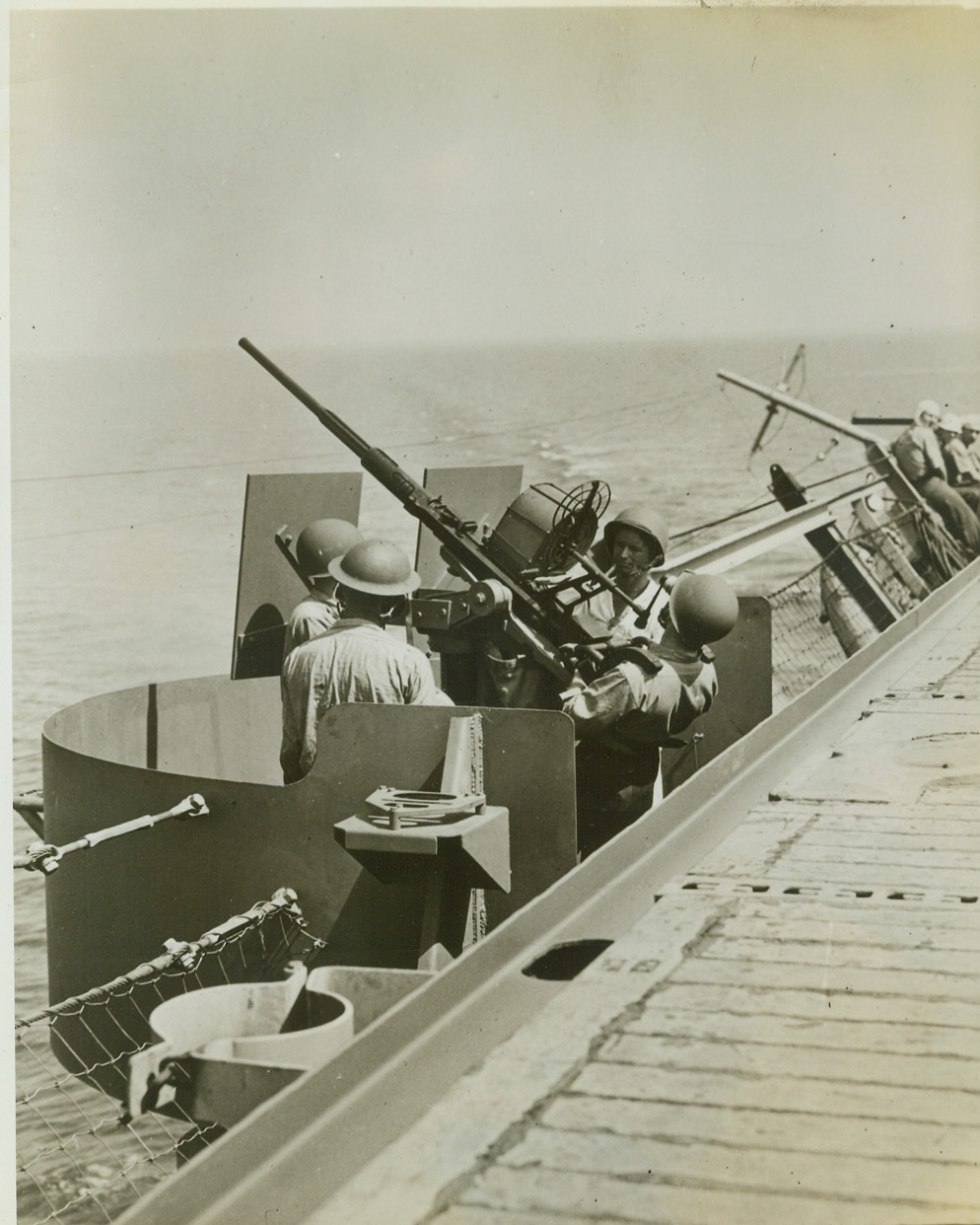
Tense Moment on a U.S. Tanker in a Convoy, 8/4/1942. Life-jacketed U.S. sailors leap to their guns as a submarine alarm is sounded on a naval tanker in a convoy somewhere in the Indian ocean. Credit line (ACME);
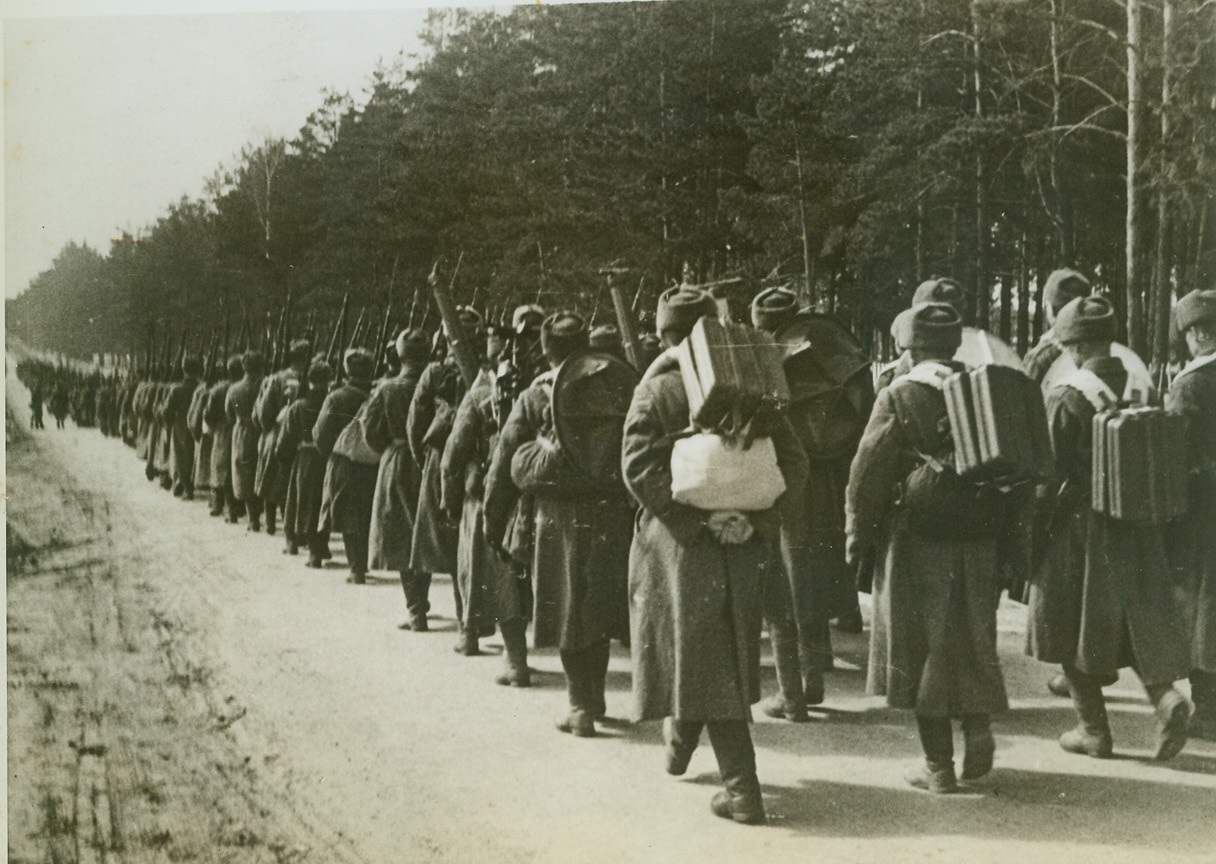
RED RESERVES MOVE FORWARD, 8/4/1942. RUSSIA – A long line of Red Reserves moves up to the front, “somewhere in Russia.” Many of these reserve troops have been thrown into the breach against the Nazi hordes threatening the Caucasus oil fields. (Passed by Censors). Credit: ACME;
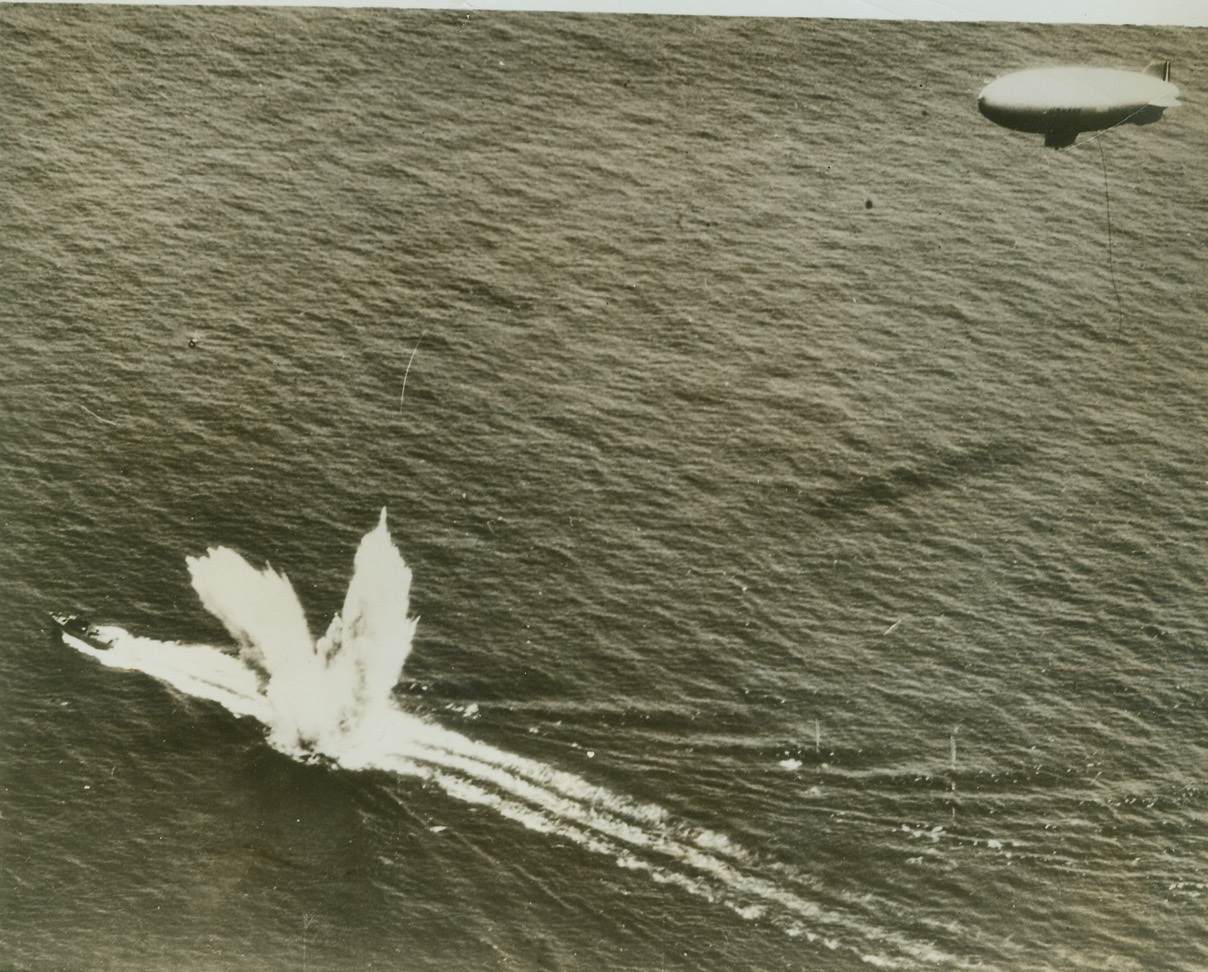
Bad Sign for U-Boats, 8/4/1942. Here's how air and sea vessels are cooperating to put the blast on U-boats operating off Uncle Sam's shores. A U.S. Navy blimp signals a nearby Coast Guard "sub-buster" to a spot where an enemy submersible is suspected of lurking in the Atlantic. The cutter streaks across the area, laying an "egg" that sends columns of water streaking skyward in a V for victory. After that the U-boat lurks no longer. Credit: (ACME);
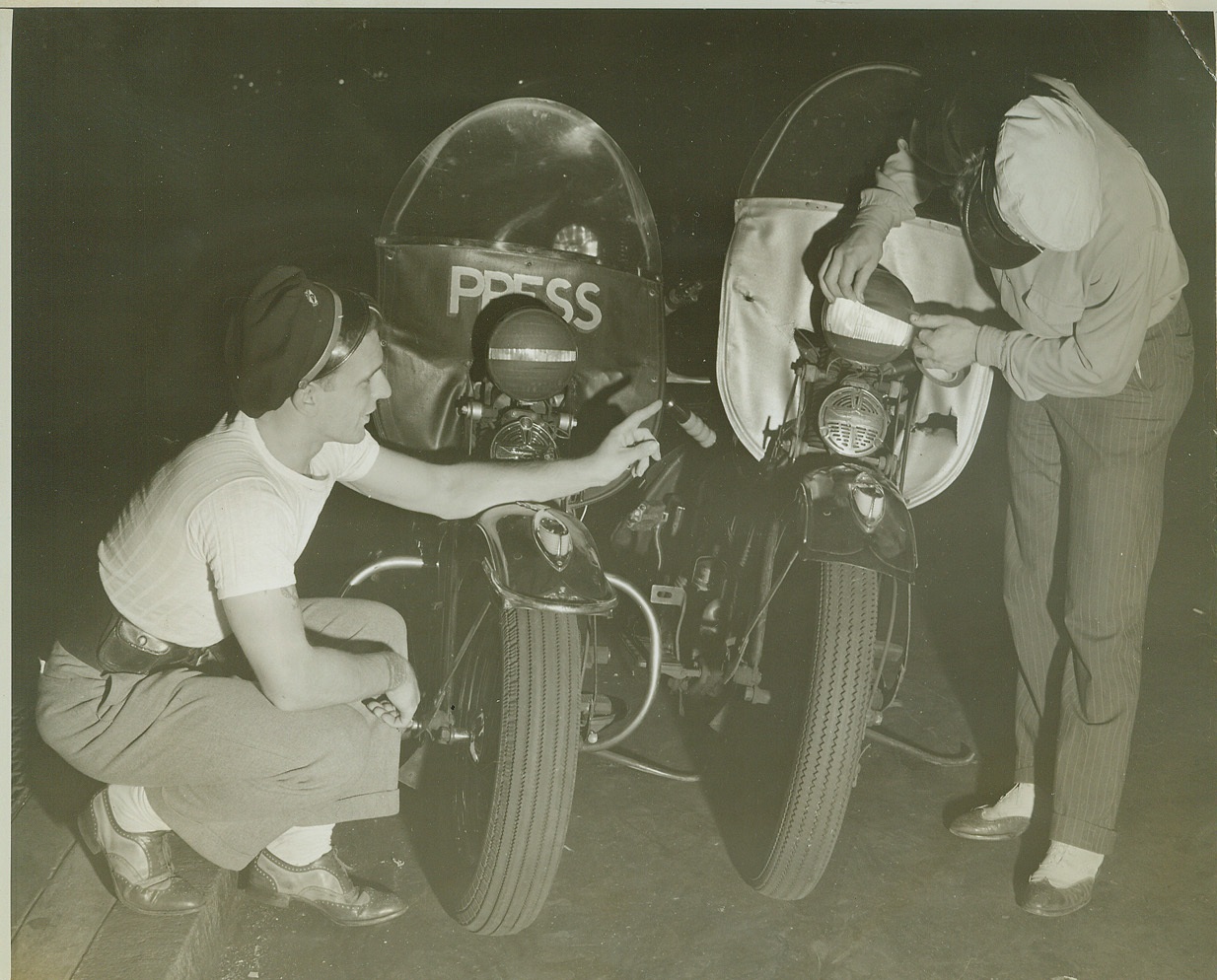
Motorcycle Riders Join Dimout, 8/4/1942. NEW YORK, N.Y. – Two press motorcycle riders, who must be prepared to ride through blackouts, Jack Schultz, (left), and Frank Mote, both of Acme Newspictures, Inc., tape up their headlights to conform to the ruling that auto lights be dimmed out to the intensity of parking lights, beginning August 4th. For the first 10 days, violators will only be given warnings. After that, magistrates will be empowered to impose penalties up to $50 or 30 days, or both. Credit: (ACME);
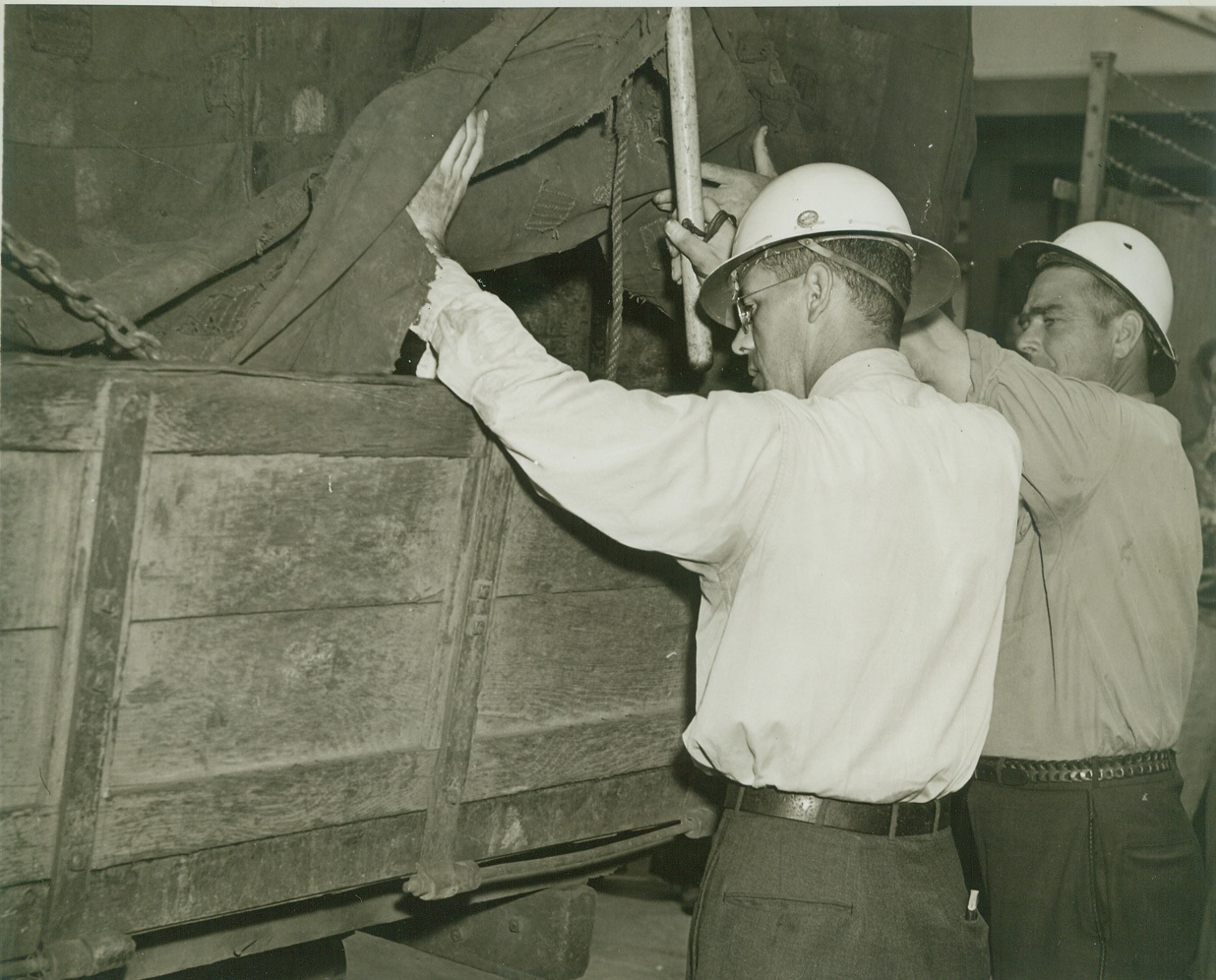
SABOTEURS KEEP OUT!, 8/4/1942. NEW YORK, NY – After four Nazi saboteurs landed on the shores of Long Island, and four on a Florida Beach, recently, with detailed plans for the destruction of various installations of tremendous value to the American war effort, it became very apparent that the Axis wasn’t – and isn’t fooling. For that reason, war plants, shipyards, and other important installations are now taking precautions. An Axis saboteur would have a tough time of it, trying to get into the Todd Erie Basin Drydocks, a Brooklyn unit of the Todd Shipyards Corp., for here is one of the plants that realizes the full danger the yard installations and personnel would be in, should they allow one chance to saboteurs. Therefore, they are taking no chances, as this series of photos passed by Navy censors shows. Every truck that goes into, or comes out of the shipyards, is carefully examined by Todd Shipyard Guards. Here, they are looking under the canvas of a truck for anybody, or anything that might be dangerous. Credit: OWI Radiophoto from ACME;
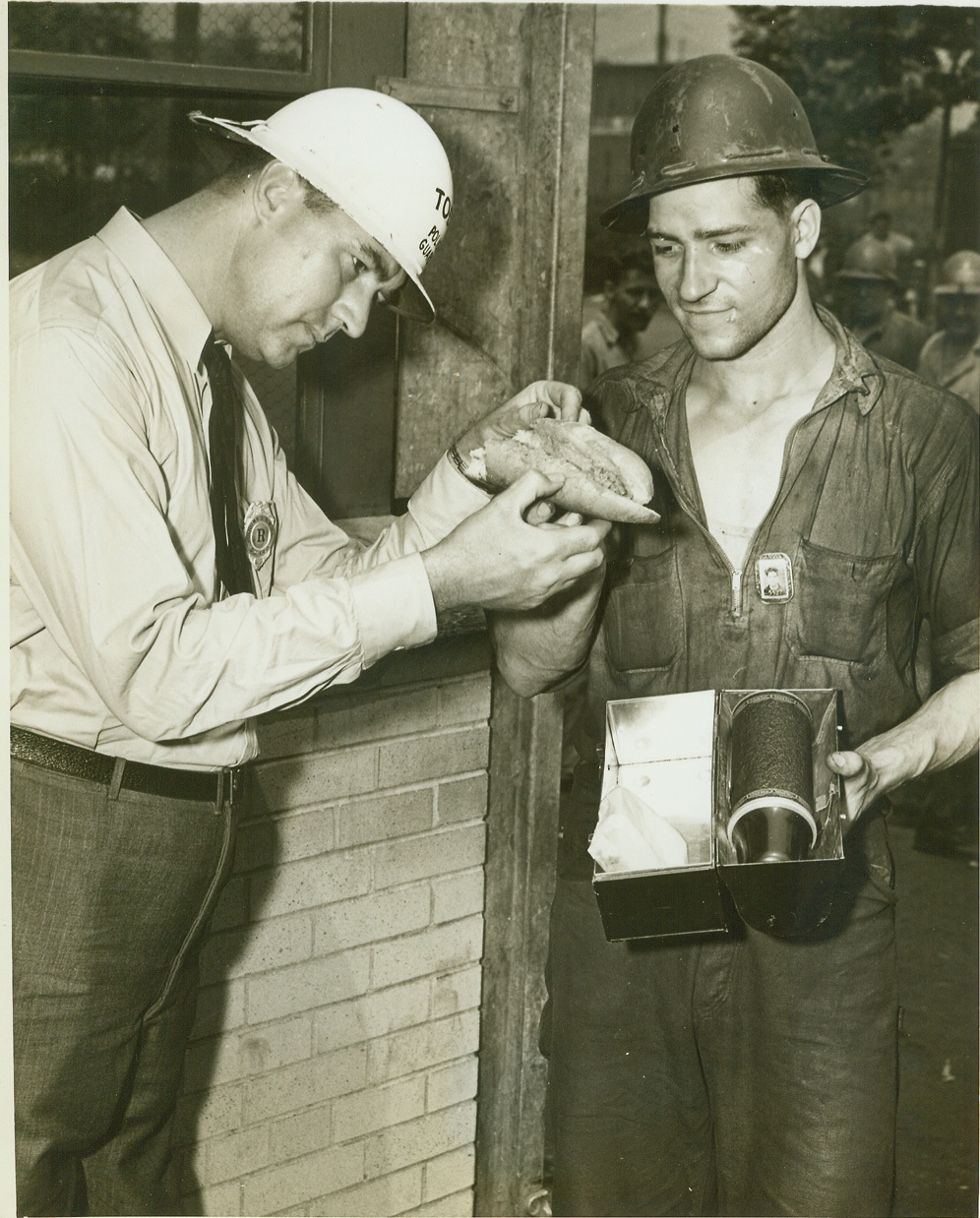
SABOTEURS KEEP OUT!, 8/4/1942. NEW YORK, NY – After four Nazi saboteurs landed on the shores of Long Island, and four on a Florida beach, recently, with detailed plans for the destruction of various installations of tremendous value to the American war effort, it became very apparent that the Axis wasn’t – and isn’t fooling. For that reason, war plants, shipyards, and other important installations are now taking precautions. An Axis saboteur would have a tough time of it trying to get into the Todd Erie Basin Drydocks, a Brooklyn unit of the Todd Shipyards Corp., for here is one of the plants that realizes the full danger the yard installations and personnel would be in, should they allow one chance to saboteurs. Therefore, they are taking no chances, as this series of photos passed by Navy censors shows. Guard Philip Mayer ,(left), even looks into a sandwich, looking for sabotage materials. Meanwhile, Jimmy Orefice, a machinist’s helper, watches anxiously, lest the guard drop his lunch. Credit: OWI Radiophoto from ACME;
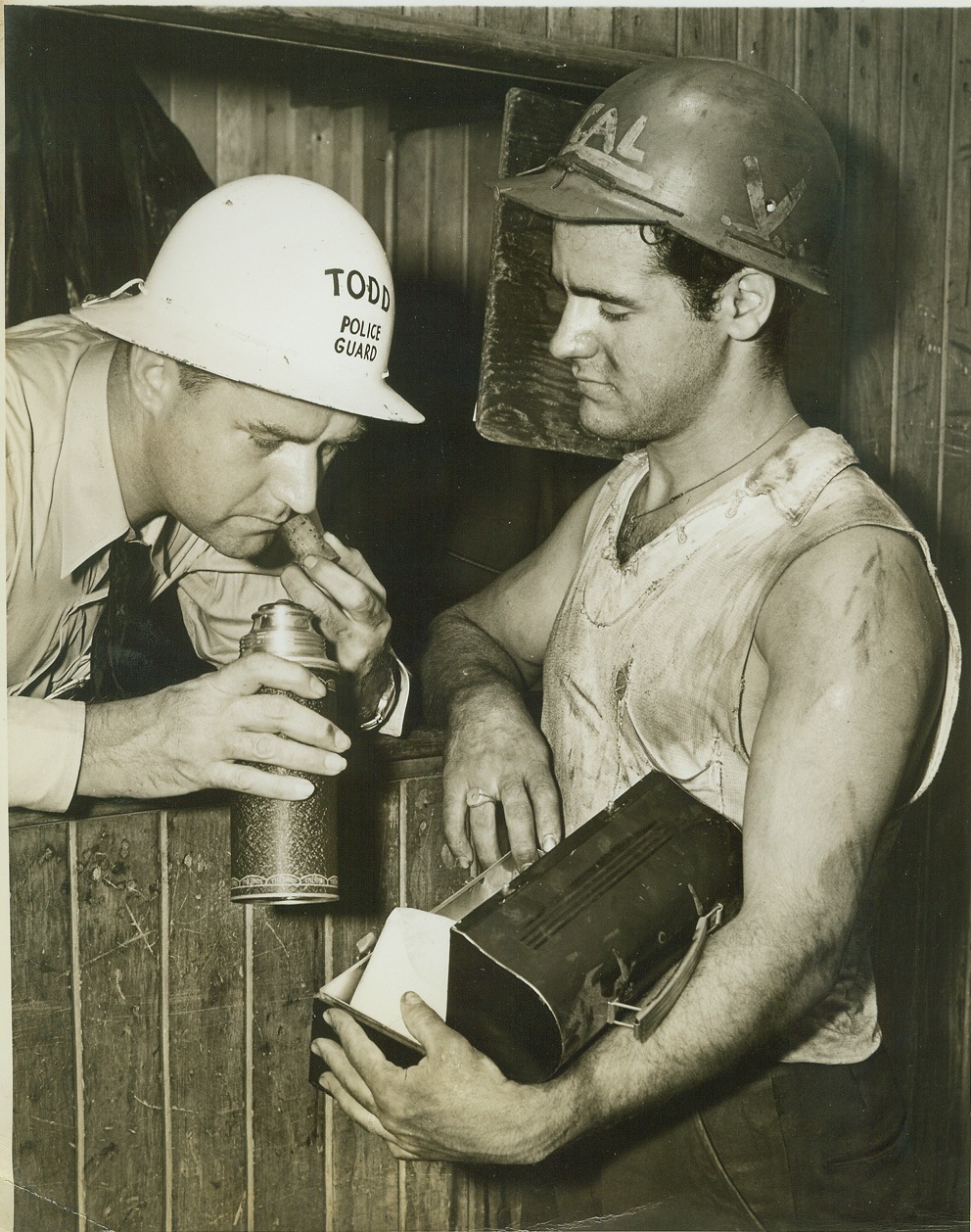
SABOTEURS KEEP OUT!, 8/4/1942. NEW YORK, NY – After four Nazi saboteurs landed on the shores of Long Island, and four on a Florida beach, recently, with detailed plans for the destruction of various installations of tremendous value to the American war effort, it became very apparent that the Axis wasn’t – and isn’t fooling. For that reason, war plants, shipyards, and other important installations are now taking precautions. An Axis saboteur would have a tough time of it trying to get into the Todd Erie Basin Drydocks, a Brooklyn unit of the Todd Shipyards Corp., for here is one of the plants that realizes the full danger the yard installations and personnel would be in, should they allow one chance to saboteurs. Therefore, they are taking no chances, as this series of photos passed by Navy censors shows. Even an innocent looking lunch box may contain a bomb! – Albert Califano, (right), has his lunch box open for inspection by Guard Philip Mayer, who smells the contents of the thermos bottle, to be sure it doesn’t contain dangerous chemicals. Credit: OWI Radiophoto from ACME;
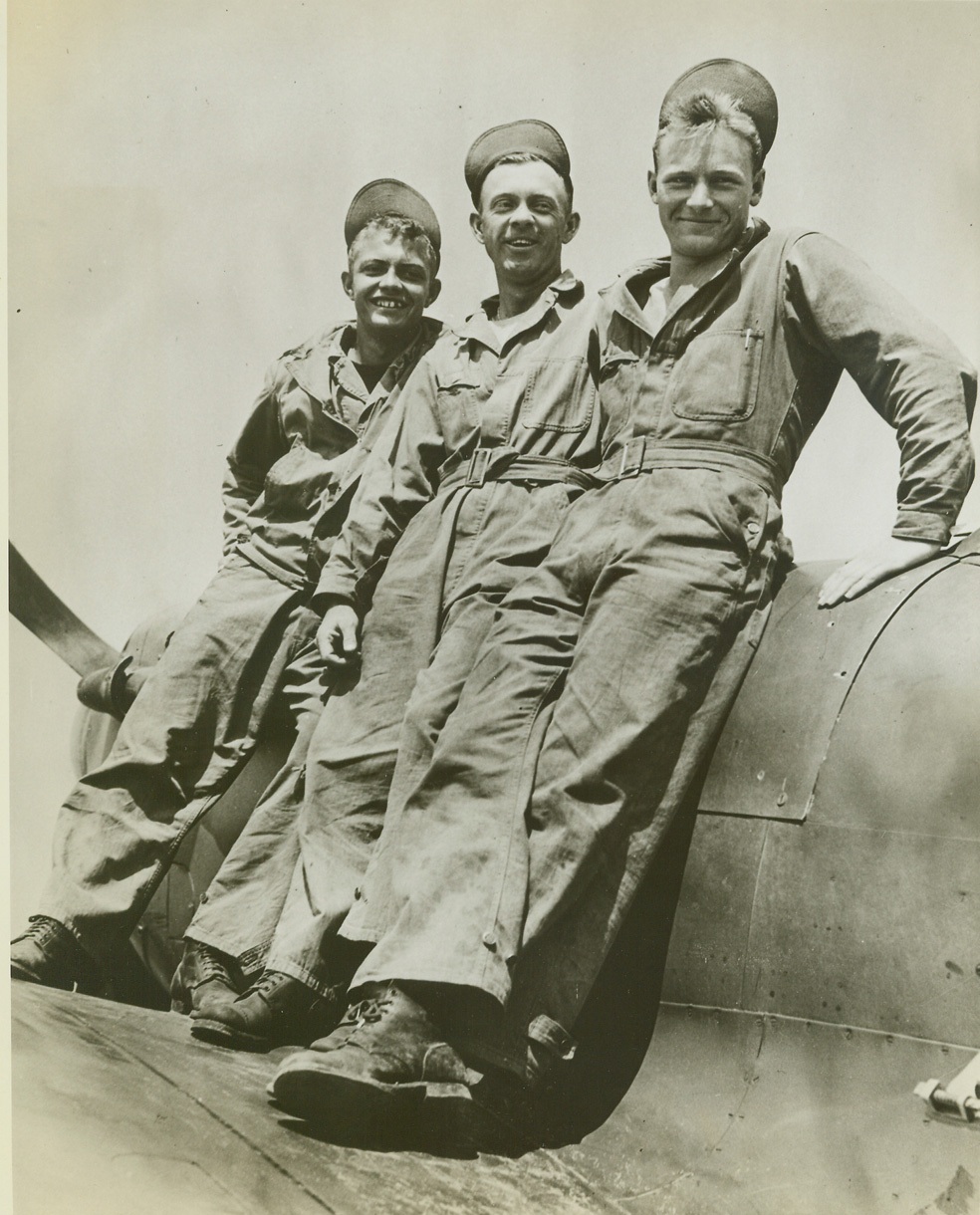
”AMERICANS ARE CONFIDENT—”, 8/5/1942. SOUTHERN ENGLAND – With smiles of confidence in ultimate victory, these young American members of a U.S. Army Air Force ground crew at a station in southern England pose for the photographer. It’s upon the willingness and capability of “greasemonkeys” like these that the success of any Air Force venture depends. They are (left to right): Don Walker, of Washington, Iowa; Mallie Galloway, of Darlington, S.C.; and John Perkins, of Woodruff, Wisconsin. (Passed by censors). Credit: ACME;

U.S. SOLDIERS LEARN JUNGLE FIGHTING, 8/5/1942. In this photo released by the U.S. Army Signal Corps, a Panamanian officer (center) instructs two American soldiers in the correct method of parrying a slashing stroke of a machete. This type of fighting is very important in jungle warfare. Credit: U.S. Army Signal Corps photo from ACME;
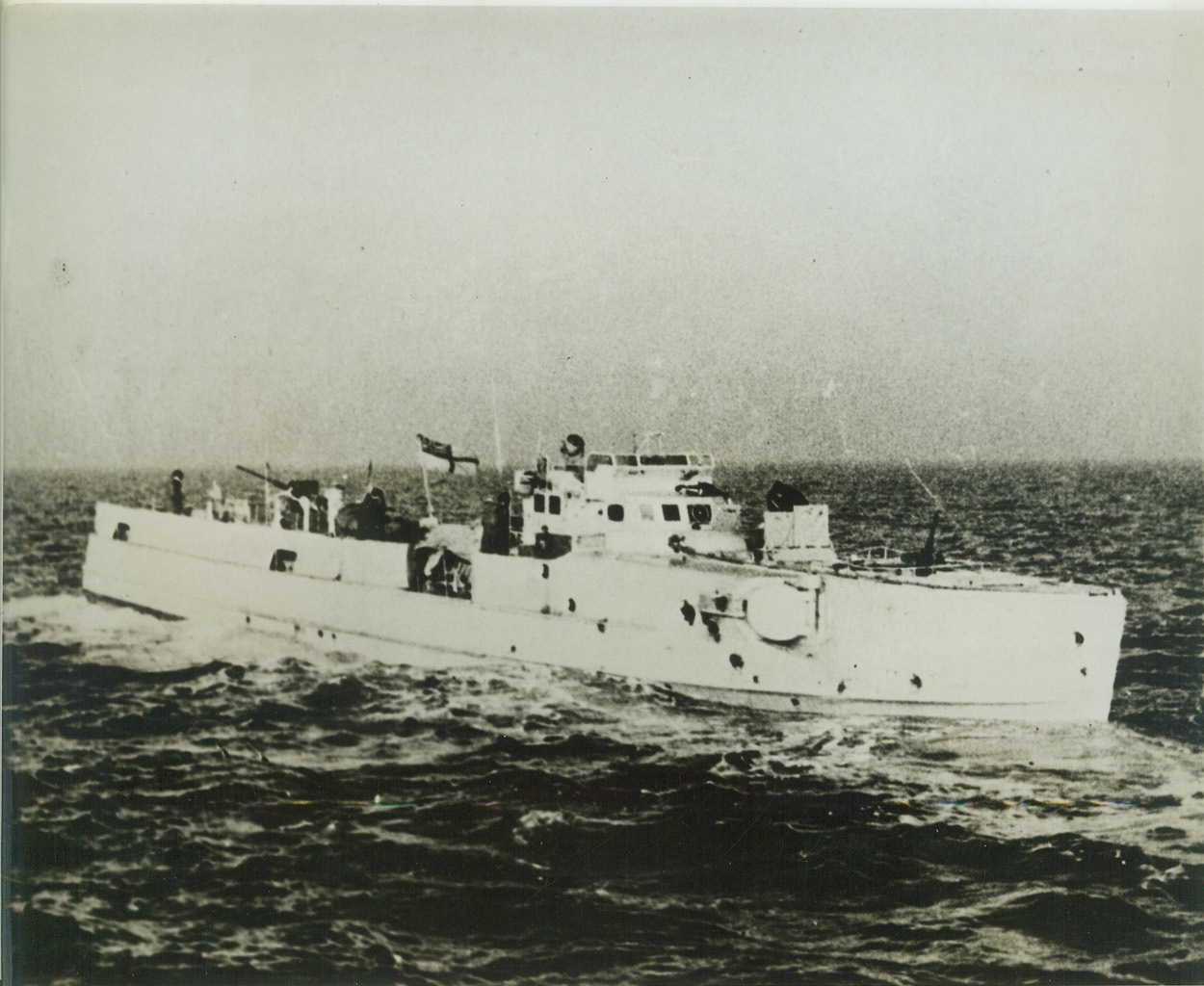
FIRST PHOTO OF CAPTURED GERMAN E-BOAT, 8/5/1942. This is the first photo of a captured German E-Boat to reach the United States. These boats, the counterpart of our PT boats, have carried out hit-and-run attacks on United Nations shipping in the English Channel and in other parts of the world. The E-Boat in photo was captured by a small force of British Coastal craft, whose Oerlikon 20mm guns punched the many holes that show in the hull and killed many of the crew. The small vessel is equipped with torpedo tubes, depth charges, smoke floats, two 20mm guns and two machine guns. (Passed by censors). Credit: ACME;
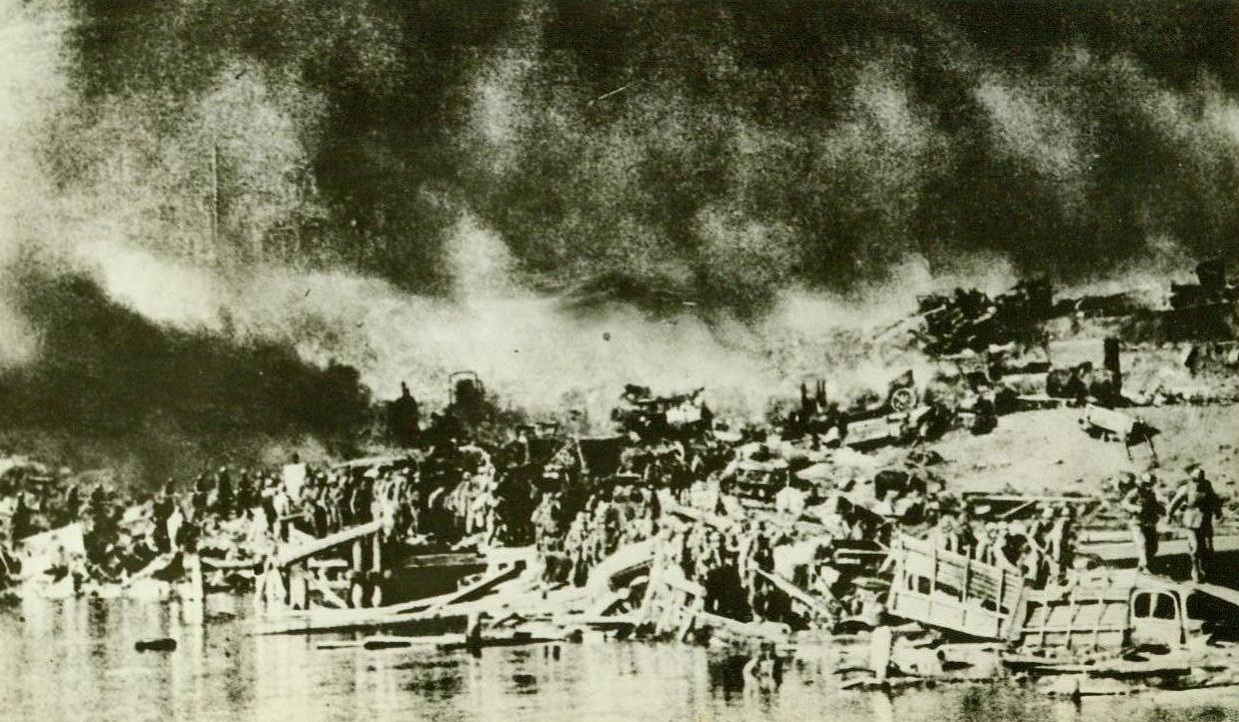
BRIDGE WRECKED BY REDS IN DON AREA, 8/5/1942. In this photo from an enemy source, German soldiers, in single file, cross over the wreckage of a bridge blown up by the Reds to halt the Nazi drive in the Don River Area of the Caucasus. Note smashed trucks and other pieces of equipment, blasted to bits in the bitter fight for this river crossing. The Nazis, still surging forward towards Red oil fields, have reached a point 100 miles southwest of Stalingrad. (Passed by Censors). Credit: ACME;
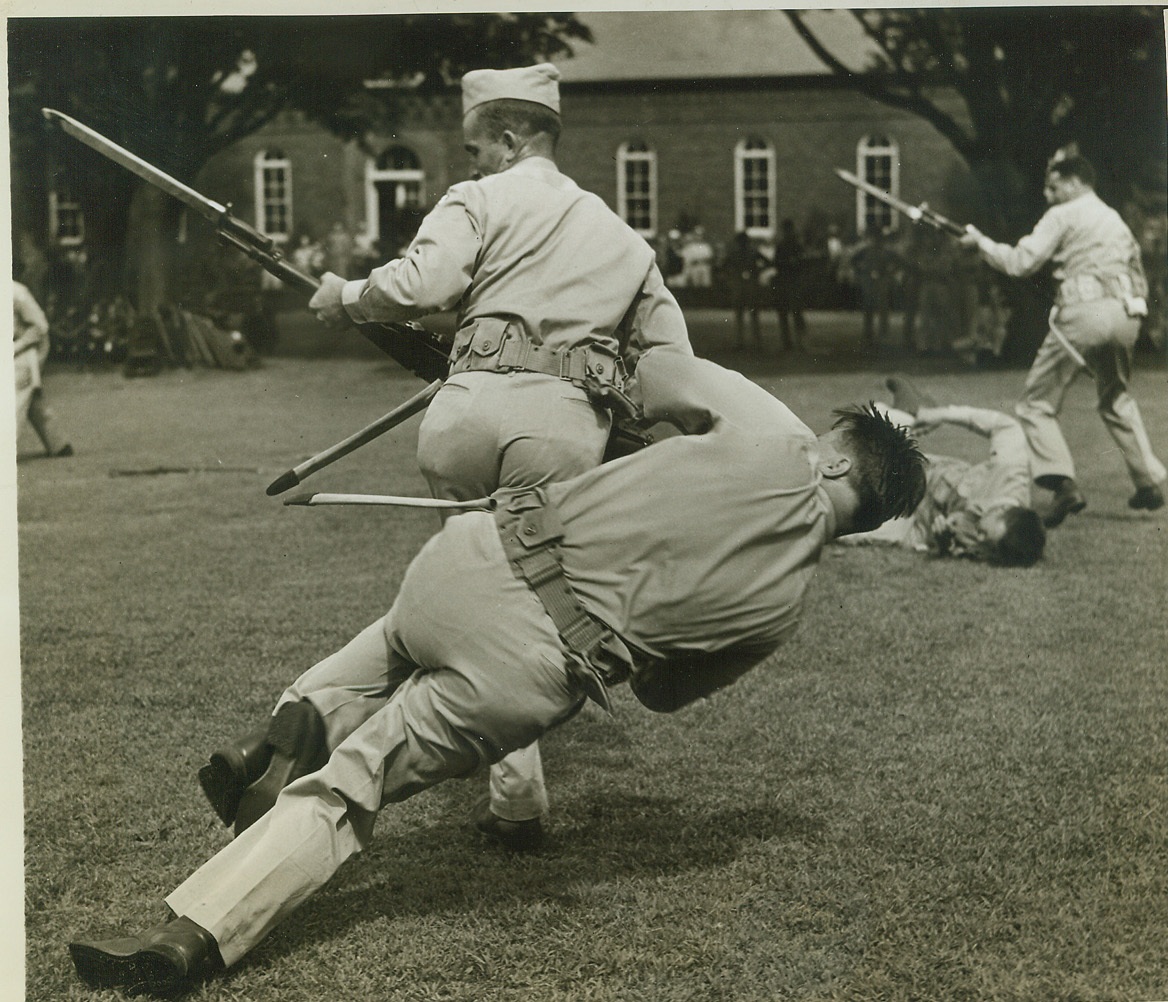
64 Recruits Graduate at Fort Slocum, 8/5/1942. FORT SLOCUM, N.Y. – In the first recruit graduation exercises in the history of Fort Slocum, 64 soldiers today became members of the permanent party stationed here, after passing through an eight weeks training period. All received diplomas and four were awarded medals for outstanding work. The ceremonies, which included a program of demonstration of the work the men received during training, was under the direction of the Post Commander Col. Bernard Lentz. The commencement address was delivered by Mayor Stanley W. Church of New Rochelle, N.Y. Here, using Commando-like tactics, one soldier is disarming another, (falling to ground, in photo), during the demonstration. Credit: (ACME);

PLEBES GO OVER AND AFTER ‘EM, 8/6/1942. WEST POINT, N.Y. – West Point plebes, on a shin-barking, back-breaking “assault” course, drive through a smoke screen, hurdle a trench and tear after the “enemy”, August 6th. Carrying 22 pounds of equipment each, these boys travel a 200 yard course, hurdling 8-foot log fences, jumping wide trenches, bayoneting dummies that pop out at them unexpectedly, and meet with other obstacles with which they are not familiar. It takes a little more than four action-packed minutes to cover the course, but it teaches the boys to meet and conquer with instantaneous speed, the same sort of surprise obstacles they would meet on the field of battle. Credit: OWI Radiophoto from ACME;
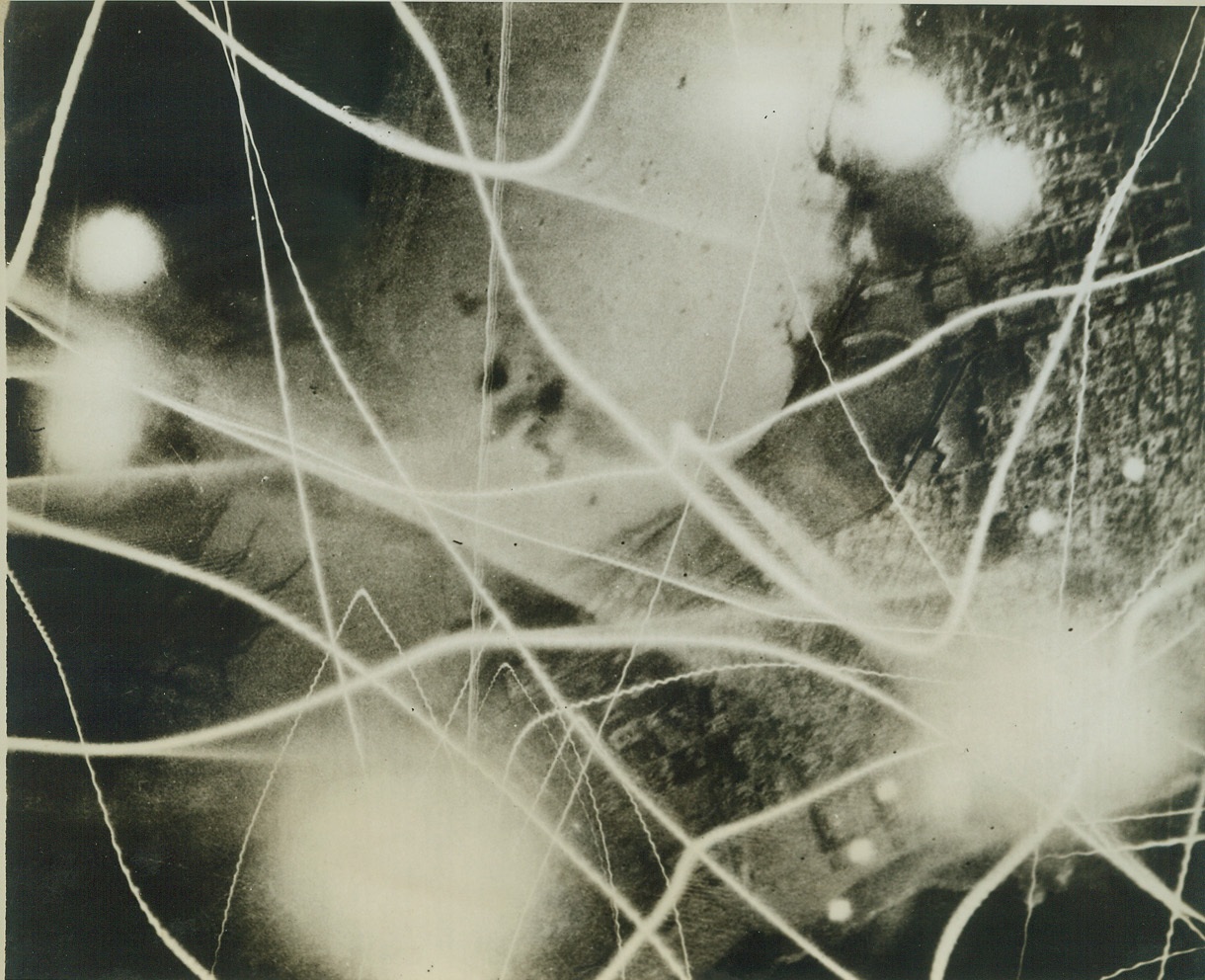
ALLIED BOMBERS ATTACK BENGHAZI BY NIGHT, 8/6/1942. This unusual photo, showing a criss-cross fire of tracer bullets, bomb flashes and brilliant white flashes of exploding anti-aircraft shells, was taken from a United Nations bomber during a night attack on the port of Benghazi. (Passed by censors.) Credit: ACME;
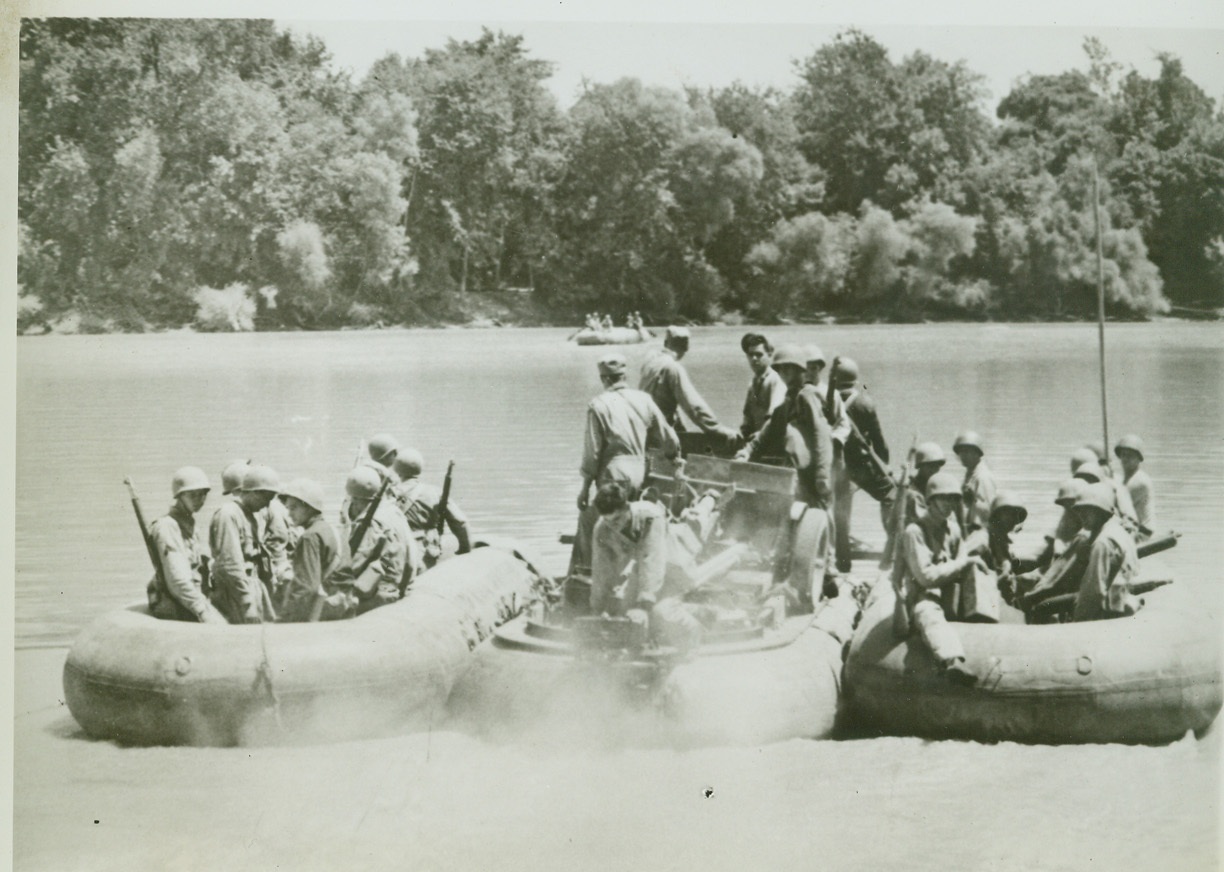
Pontoon Crossing in Carolina Maneuvers, 8/6/1942. With the Army in the Carolinas—An outboard motor stirring up the quiet waters of the Pee Dee River, propels three rubber pontoons toward a bridgehead, ferrying a 37 mm anti-aircraft gun and its crew members across the river during maneuvers in the Carolinas. Credit: ACME.;
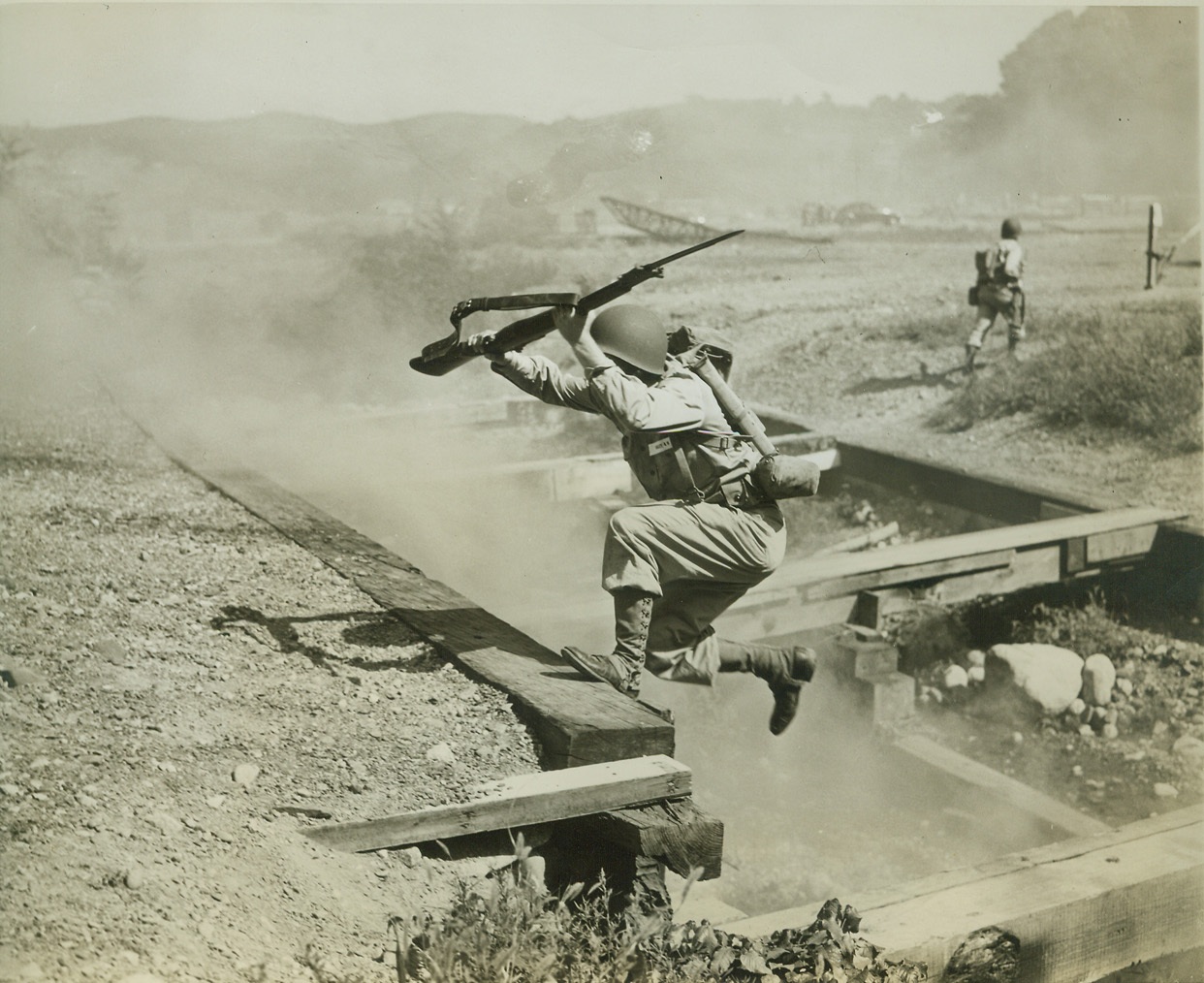
THINK HE DIDN’T MAKE IT? ---- HE DID!, 8/6/1942. WEST POINT, NY – It doesn’t look like this plebe would make this five-foot jump up out of a trench – but he did! And so did the other plebes that tackled this part of a tough, 200 yard “assault” course at West Point, Aug. 6th. The boys, carrying 22 pounds of equipment, hurdled trenches and barbed wire tangled log fences, and took bayonet stabs at dummies. The course is part of five weeks of intensive training, which precedes the plebes’ academic course at the United States Military Academy. Credit: OWI Radiophoto from ACME;
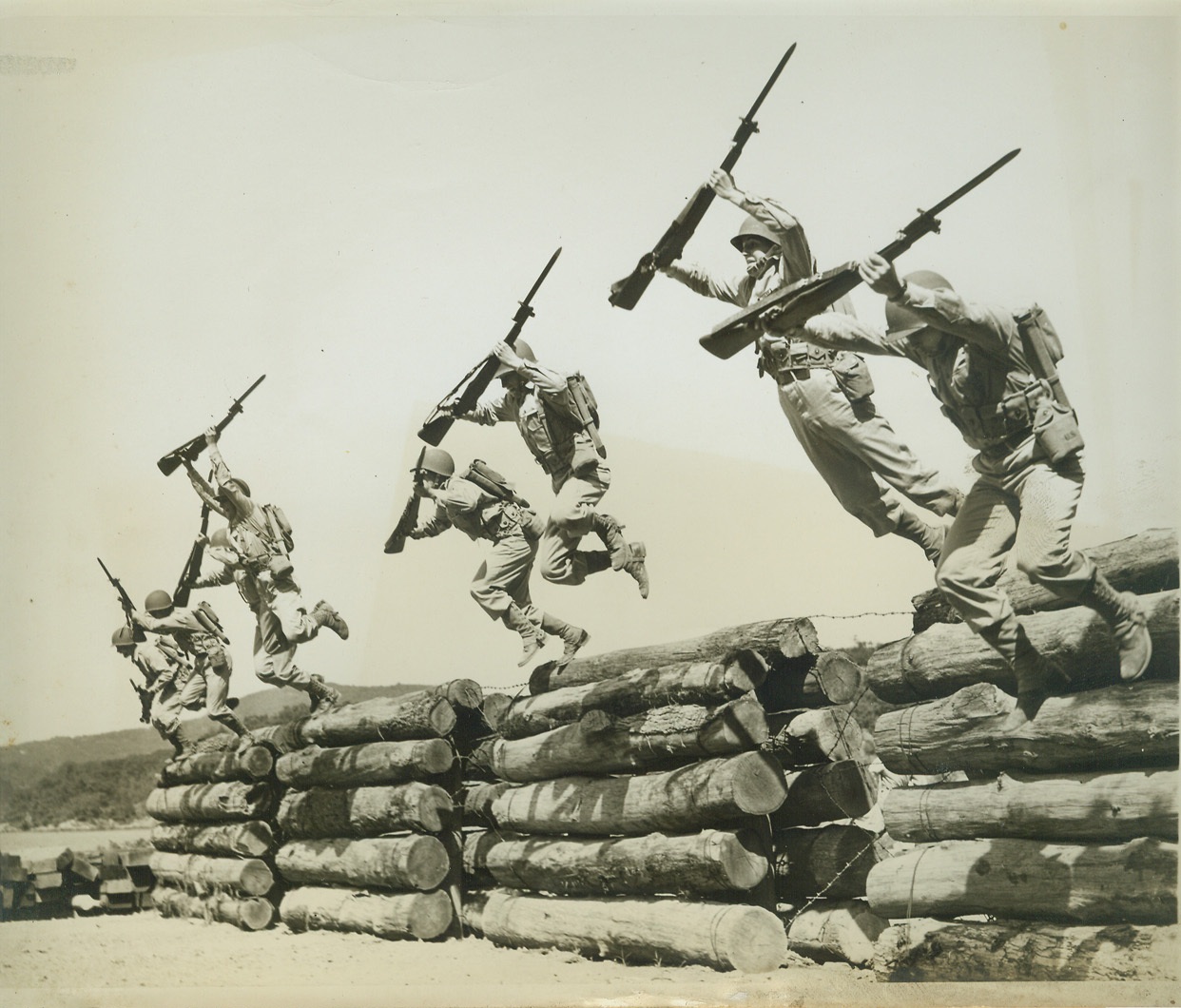
NOT FOR “SISSIES”, 8/6/1942. WEST POINT, NY – It takes a good, hard “Hunk O’ Man” to hurdle a barbed wire tangled log fence like this. But, these plebes take it in their stride as part of a 200 yard “assault” course, which includes everything from hurdling trenches, to taking a stab at dummies, which pop out at them unexpectedly. It’s part of the Army’s method of turning out officers that can meet – and conquer any emergency that may confront them on the battlefield. Course, is the toughest, shin-barking, back-breaking routine that can be cooked up, and these boys cover it in little more than four action-packed minutes. Credit: OWI Radiophoto from ACME;

WORLD’S LARGEST AIRPLANE WOOD VENEER PLANT BURNS, 8/7/1942. CHICAGO, ILL. – The embers and twisted steel of valuable machinery after fire broke out in what was once the world’s largest airplane wood veneer plant at Mellen, Wisc., owned by the Penoke Veneer Company. The blaze apparently started by a short circuit and damage is estimated at $500,000. Credit: ACME;
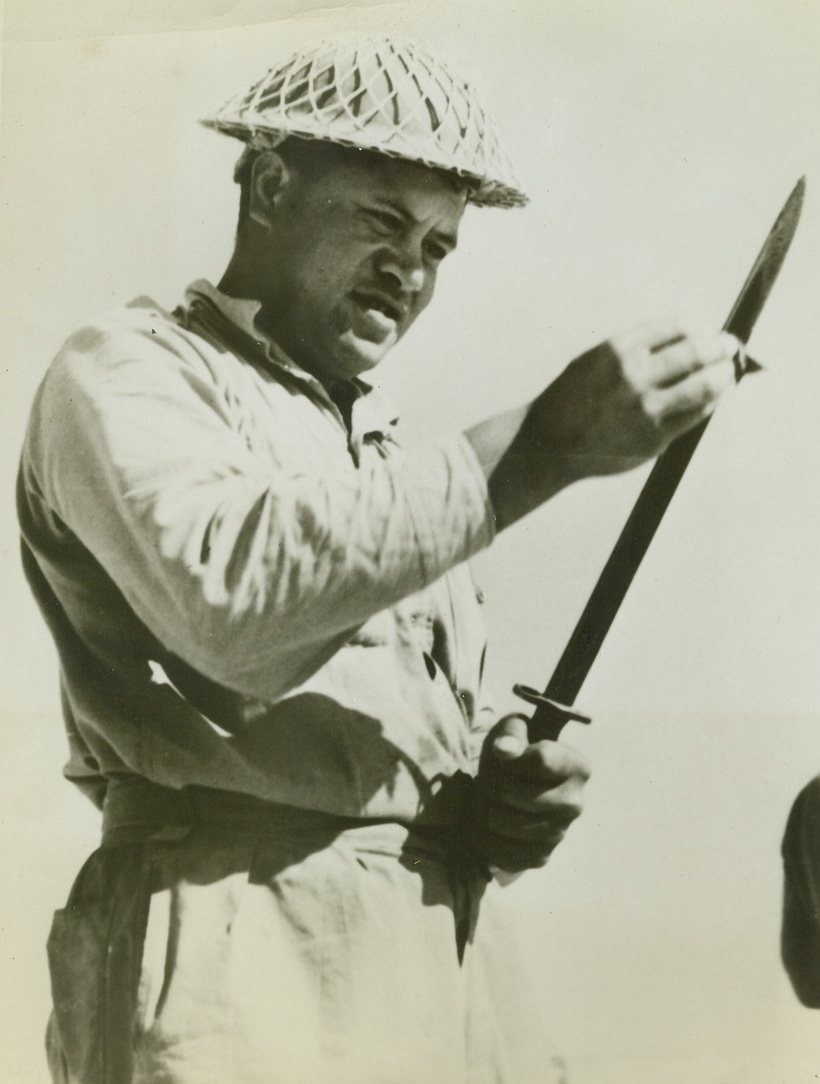
READY FOR THE NEXT!, 8/7/1942. EGYPT – A Maori soldier of the New Zealand forces in Egypt wipes his bayonet after a bloody engagement with Axis forces near El Alamein. The Maori favors such hand-to-hand fighting and looks on the bayonet as his best friend. The net over his helmet is to hold camouflage material. (Photo was released by New Zealand legation.) Credit: ACME;
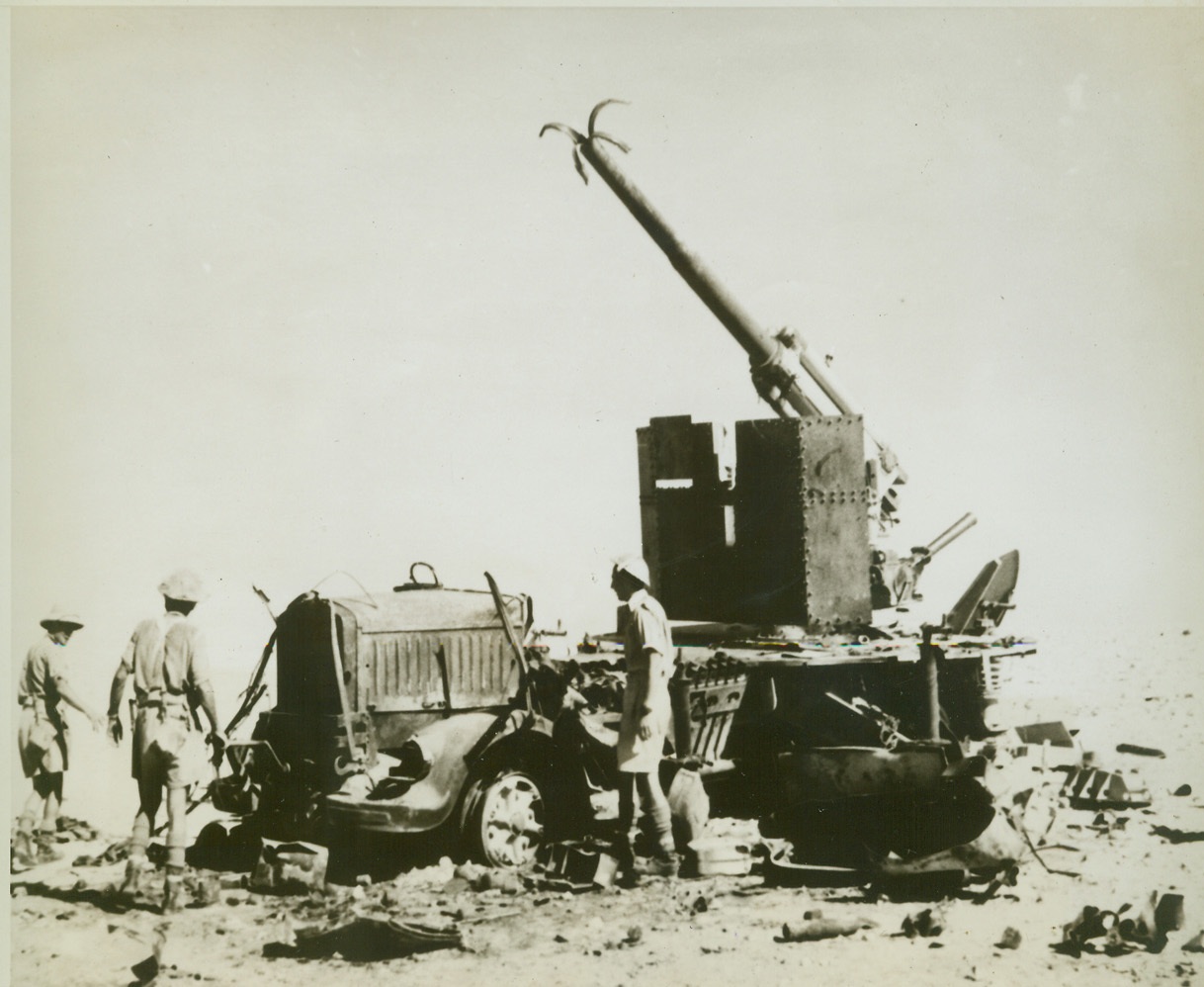
END OF AN “EIGHTY-EIGHT”, 8/7/1942. EGYPT – No more shots will be fired from this 88-mm. German anti-tank which was wrecked by high explosive shells fired by New Zealand 25-pound field guns. Rommel’s men blew up the muzzle before abandoning the gun. (Photo released by New Zealand Legation) Credit: ACME;
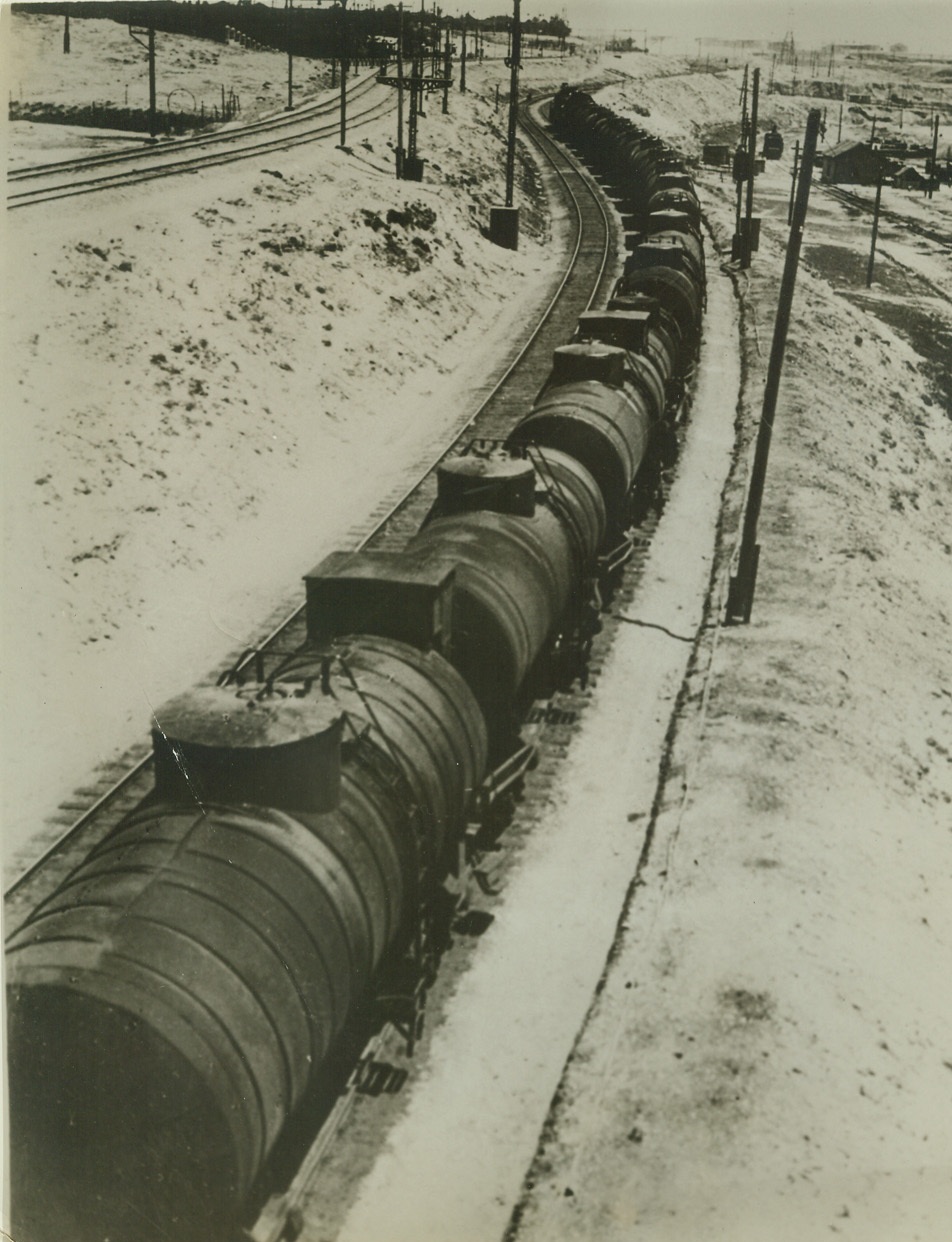
No Title. 8/8/1942.
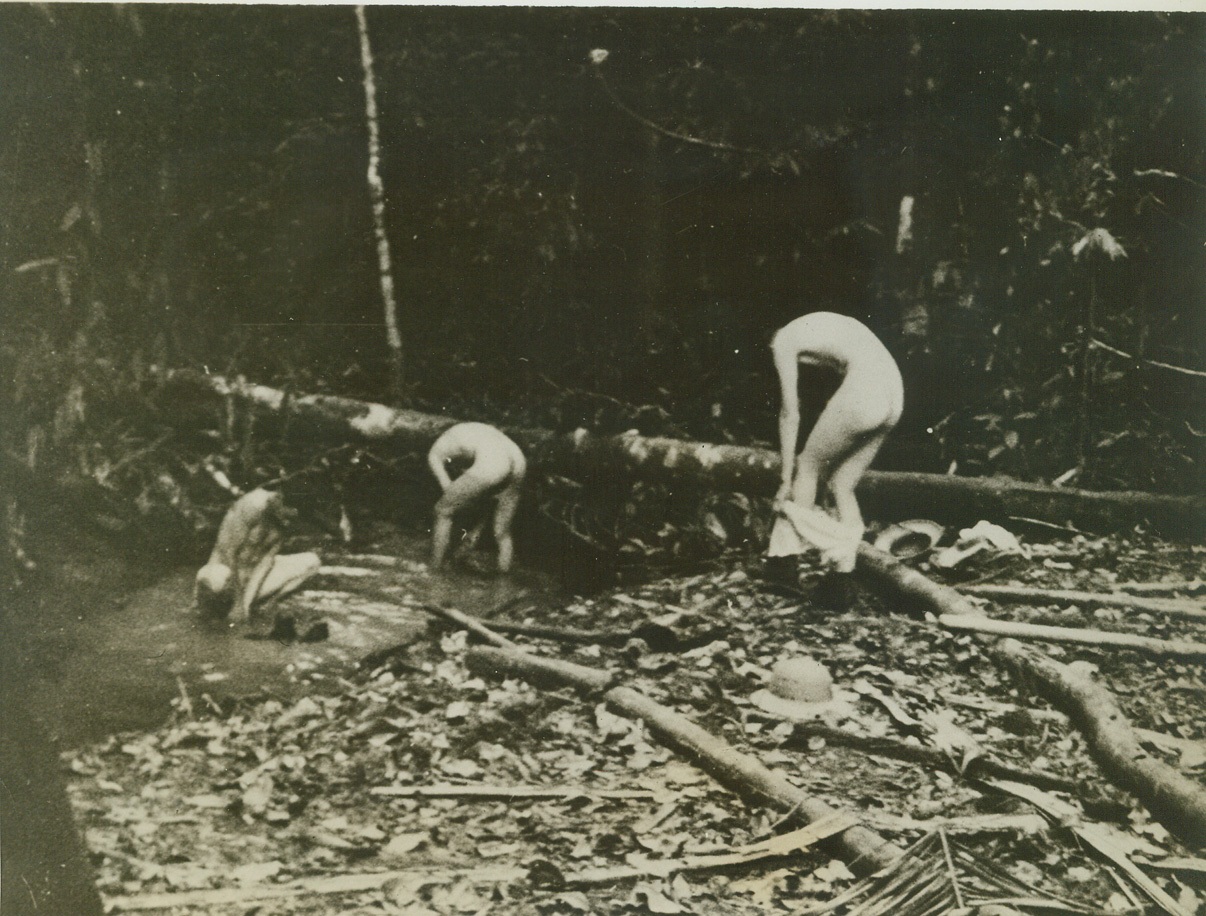
Cleanliness is observed, 8/8/1942. Cleanliness is observed in spite of jungle flies and other pests. “Yank” correspondent Ed Cunningham took this photo of some of the men washing their clothes—and themselves—in one of the small streams. Credit: ACME;
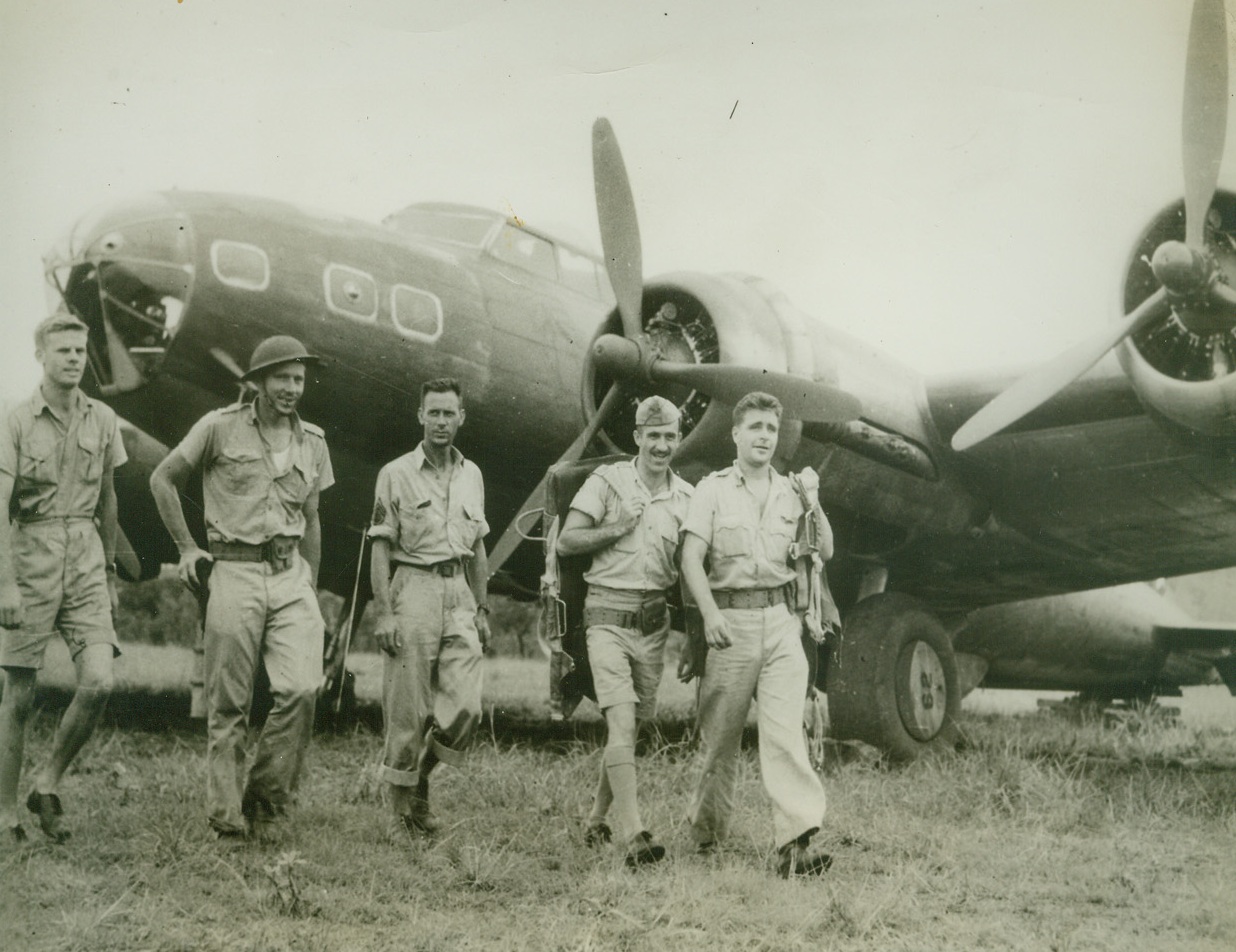
Some of Our Boys “Down There” in Australia, 8/9/1942. “Somewhere in Australia” was taken this picture—one of the first from the land of “down under” since the United States entered the World War II – shows members of an American Army Air Corps “flying fortress” crew walking in front of one of their big four-motored bombers, which, incidentally, had been in action against the Japanese invaders in the Philippines area;
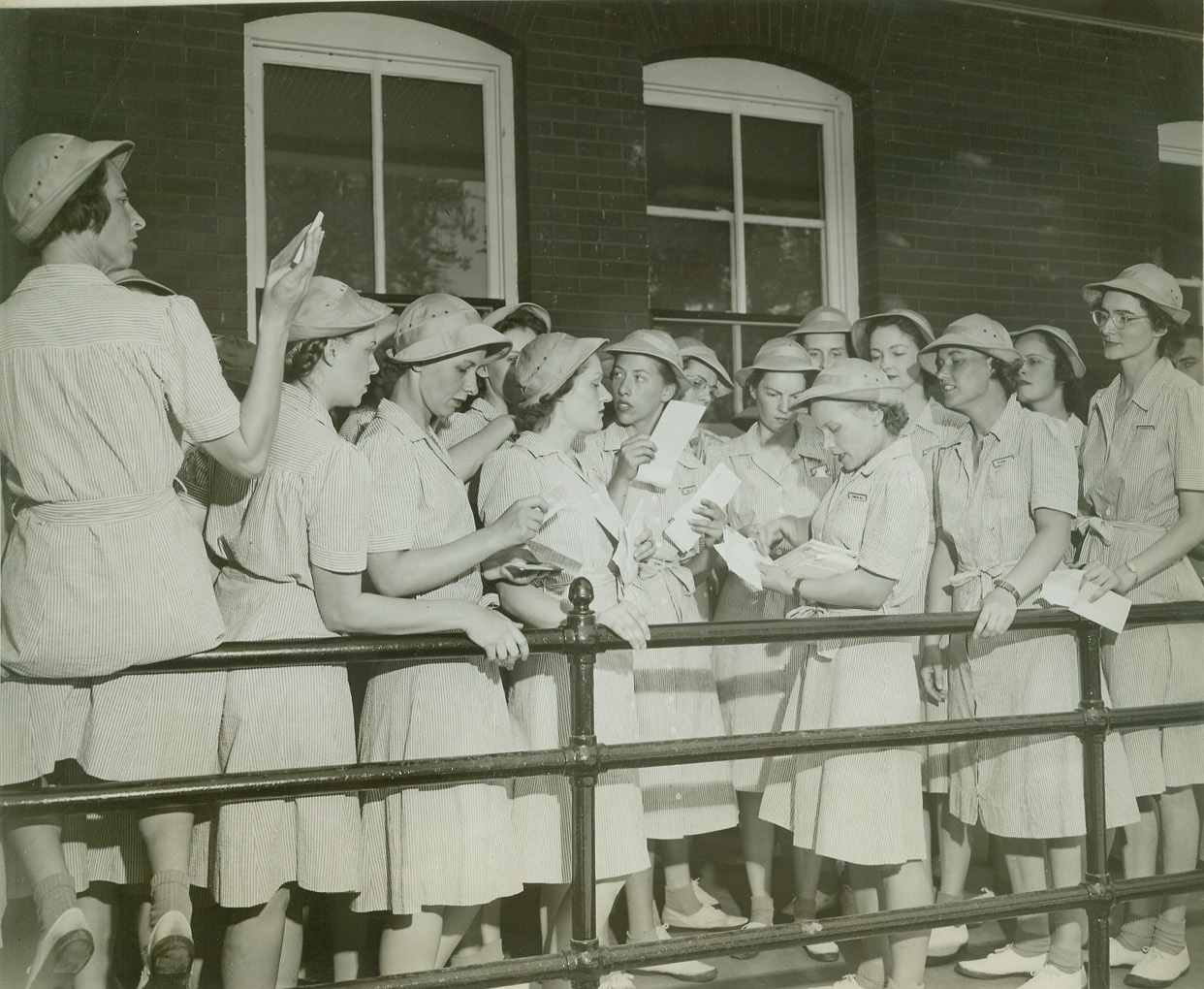
Mail Call at WAAC Camp, 8/9/1942. Fort Des Moines, Ia. – Women of 1st Regiment officer training school of Women’s Army Auxiliary Corps at Fort Des Moines, Ia., receiving mail from Murl Fodness of Ellendale, North Dakota. Credit: (ACME);





 Trash & Recycling
Trash & Recycling
 Online Payments
Online Payments
 City Documents
City Documents
 Parks
Parks
 Traffic Court
Traffic Court
 CITY PARKS
CITY PARKS
 Outdoor Recreation
Outdoor Recreation
 Volunteer
Volunteer
 Home
Home TRANSLATE
TRANSLATE
